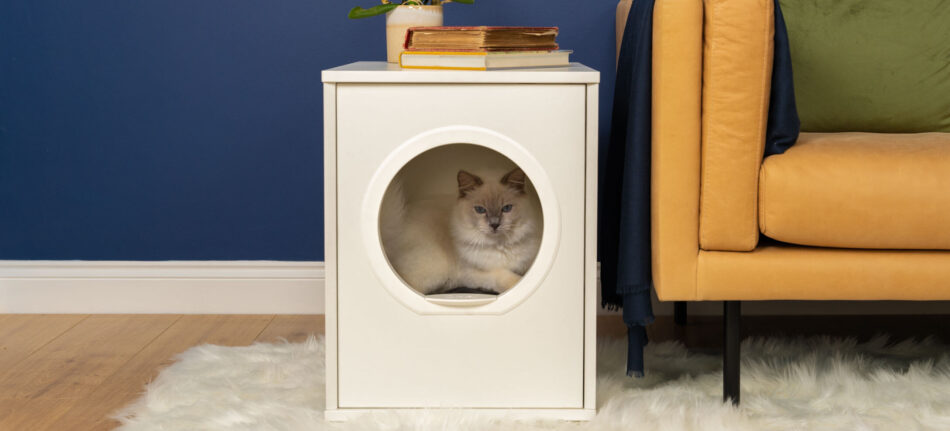
Whether your cat is moving with you to a new house or you’re welcoming a new cat into your life, a new home can be stressful and confusing for our feline friends. The first few days are especially trying, and it’s important that you as an owner do everything you can to make the move as smooth as possible for your pet. Read on to find out some top tips for moving with cats.
Moving to a new place with a cat – before the move
If you are moving with a cat, try to keep the cat’s routine as normal as possible in the days leading up to the move. Very anxious and timid cats will benefit from familiarizing themselves with cardboard boxes around the house before you start packing your belongings.
In the new house (or your current home if you’re rescuing a cat), prepare a room somewhere where you can keep your cat when you arrive. This should ideally be a spare room or a bathroom away from the hustle and bustle of the home. Cats will naturally think a new house is scary and smells unfamiliar, so giving them a smaller space to get familiarized with to start with can be less difficult.
Give your cat places to hide in the room, as well as a snug spot to relax, maybe with something they already feel comfortable with, like their super comfy donut cat bed or a blanket from the rescue center. Also prepare a cat litter box, bowls with food and water, and some toys.
A Freestyle cat scratching tree that is tall and rigid will also help your cat let off some steam and allow them to leave familiar scents from glands in their paws, which will help them keep calm.
If possible, prepare this room with everything your cat needs before bringing them home.
During the move
The most important thing when getting a cat to settle in a new environment is to have patience and always let your cat make the first move when it comes to approaching new things, or new people. Most cats love feeling in control, and by pulling them out of the cat carrier or picking them up for a cuddle you could be adding to your cat’s stress.
Be aware that it might be a few weeks, or even months, before your cat feels comfortable in their new home. It takes them time to get used to new surroundings, not to mention other cats or children they’ve never encountered before.
If possible, it’s good to give your pets something familiar that makes them feel safe. If you’re adopting a cat, ask the adoption center if they have a blanket or toy your new addition has been using, or if you’re moving house with your resident cat, unpack their things first. Don’t change the food you’re giving them, give them a new litter tray or treat them to a new bed just yet.
How to introduce cat to new home
Make sure the space where your cat is allowed to be is completely cat proof. This might, to start with, just be one room, but if you’re letting your feline friend explore the whole house, keep all doors and windows closed, and check potential cat flaps or even chimneys before you invite your cat in. Give everyone around on moving day careful instructions or put a sign on doors to inform them where the cat is. The new home will seem like an unsafe space for your pet, and their instinct will most likely be to escape.
Once you have set up a room or an area for your cat to initially settle into, carry the cat into the room and open the door to the cat carrier. Sit back and see what they are doing, but never force them to come out or pick them up, let them explore in their own time. You can sit in the room, or you can leave for a bit and come back later.
When you have seen that your cat is comfortable in their room you can open the door and allow them to come into the rest of the house whenever they feel ready. Cats are naturally inquisitive, so they will want to explore their new surroundings.
If you have other animals or pets in the house that your new cat has not met before, make careful introductions i.e. initially using a barrier, keeping a distance. You should try to space out any stressful events to not overwhelm your cat.
It’s normal for a new cat, or a cat in a new home, to not have much of an appetite or to cry during the first few nights. Unless you think it might be detrimental to your cat’s health, or that they are in danger, leave them to it. Most cats will stop this behavior after a couple of days.
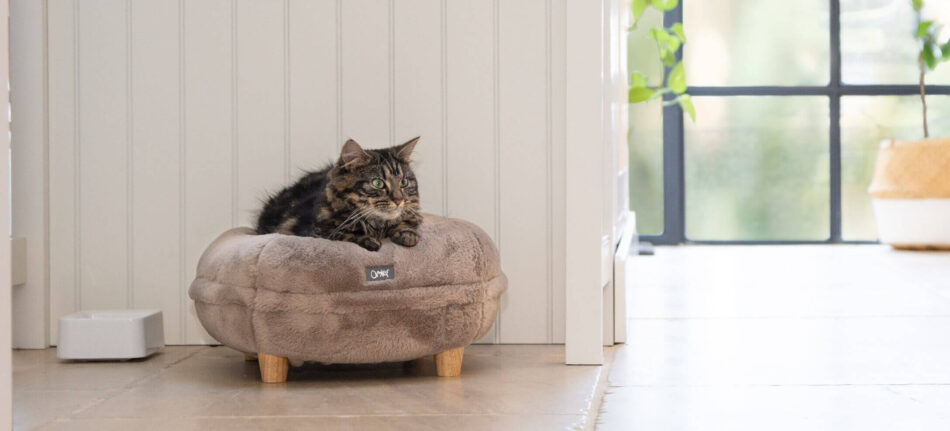
Transporting your cat to a new home
Make sure you have a good pet carrier that is big enough for your cat. If you can, it’s a good idea to get your cat used to car rides before the journey to a new home, but that is obviously more difficult if you’re picking up a rescue cat.
Put some soft bedding in the carrier and secure it in the trunk or with a seat belt inside the car. It’s important that it’s safe and doesn’t move around, as that will be very stressful for your cat. Regulate the temperature in the car so it’s cool but not cold.
Keep the journey as short as possible; don’t make any unnecessary detours or make stops you don’t have to make. If you do need to stop, it’s often best not to let the cat out of the carrier, as there is a risk they will escape. However, never leave your cat unattended in the car. It can quickly get dangerously hot, fast.
Moving a long distance with cats
If the journey is so long that you will need to stop and allow your cat to go to the toilet or eat and drink, it’s important you find a place where it’s safe to do so. Consider keeping your cat on a lead, or only let them out in a confined space. If you’re travelling really far you might want to sedate your cat to make the journey less stressful for all. Speak to your vet to see if this is an option.
When to let your cat outside
If you have a cat that normally spends a lot of time outdoors, you might want to let them out as soon as possible and give them their freedom back, but it’s generally good to keep a cat indoors for at least a few weeks. Moving is one of the most common reasons cats disappear, be it because they don’t feel safe in their new house or that they get lost, so be careful. You can read more about this in our previous blog post Why Do Cats Run Away?
Moving house with an outdoor cat
While keeping outdoor cats indoors, make sure they have plenty of stimulation and exercise opportunities.
Once you think your cat is ready to go outside, one thing you can do in preparation is to sprinkle a bit of used litter around the perimeter of the yard. This will make the outside space smell familiar to your cat, and other cats in the neighborhood will be warned that there is a new cat on the block.
The first times you let your cat out, make it short, and keep an eye on them. Call them back after a few minutes, and gradually extend the time they spend in and around the yard. It’s best to stay with them to reassure them that everything is fine, and leave the door or cat flap open so they can return into the house if something scares them.
If you have moved somewhere that doesn’t allow your cat to roam as freely as they have previously done, be it due to traffic, wildlife or neighbors, you might want to consider investing in an Outdoor Cat Run. Omlet’s catios lets your cat feel the wind in their fur in complete safety, and they can keep your cat healthy and fit without the worry of them running away or getting hurt. There is also the option of a Cat Balcony Enclosure if you live in an apartment.
Moving house with your cat
While lots of these tips apply to a new cat as well as a long term pet who is moving with you, there are some specific things that could help a current cat settle in.
As your cat has been living with you, there are things that will be easier than bringing home a new cat. Maybe they have a Maya Indoor Cat House or Memory Foam Bolster Cat Bed where they can go for some quiet time and that will immediately make them feel at home. If you want to introduce your cat to a cat house, this might be a good time, as they will be searching for a safe space to retreat to. You can read more about this in our previous blog How to Get a Cat to Use a Cat House.
Depending on their personality, you will probably want to let them out of their initial introduction room quite quickly. They are used to being around you and your family and keeping them separate can be more stressful. But again, wait for them to make the move.
One thing to help your cat adjust can be to take a piece of cloth and rub it gently around your cat’s neck and face to pick up their scent. You can then wipe this cloth on furniture in the house at cat height to make the new territory seem more familiar. Feliway products or a pheromone diffuser can also be good options.
Remember to update the address on their collar and change their microchip information on any database.
If you haven’t moved far, there is always the worry that your cat may disappear in search of their old home. Sometimes the new owners will provide food and leave out water bowls for the unexpected visitor, so, if possible, ask the new residents to let you know if your cat shows up. To avoid these trips down memory lane, keep your cat indoors for the first few weeks after the move. That won’t necessarily make them forget their old home, but should get them used to their new one, and hopefully realize that’s where they belong.
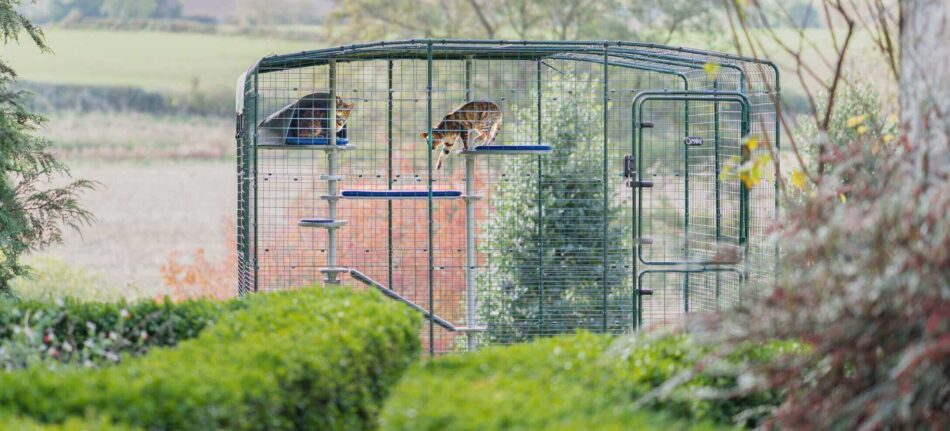
Moving with multiple cats
If you live in a multi-cat household, then this can inevitably make things a little bit complicated, but with the right preparations, the move can be made as stress free as possible! The process of moving itself isn’t all too different, but you will have to consider the needs of more than just one animal. Take a read of our How to Create Peace in a Multi Cat Household blog for some advice on creating a better dynamic between your cats, which will help in making the transition easier when the time comes.
Conclusion
A move is a very exciting event for both cats and humans, especially for those who are moving from a shelter to their forever home. However, most animals are creatures of habit, and many cats find a new house a very scary thing. To make the move a bit more comfortable, shop Omlet Cat Products to help you find everything your purry pal needs to settle into their new home. Make sure you prepare yourself for the next few days, or weeks, to be a bit tiring. And with these tips for moving with a cat, it will, of course, be worth it in the end!
This entry was posted in Cats
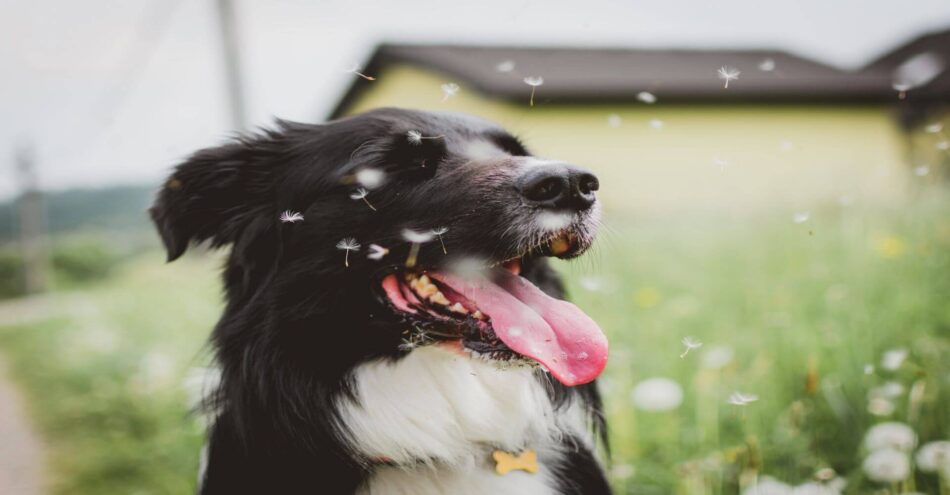
Common allergies in cats and dogs have been identified as 3 main allergy groups, which we explore in this article. Some common allergies are seasonal, and others can creep up throughout the year. Understanding the common allergies in cats and dogs will make being a pet owner easier as you know what to look out for and how to handle it. Allergies can be treated quite easily, but there are a few symptoms or warning signs that we can look out for to make sure that our cats and dogs are healthy and happy.
Persistent seasonal allergies such as the dreaded hay fever kicks in for many of us humans, but we know that we are not alone in this seasonal battle of the bugs as our beloved pets can suffer too. We exhaust alternative medications, home remedies and whatever we can lay our hands on to try and keep these pesky allergies at bay!
Despite doing our absolute best to ensure our cats and dogs are spoiled and looked after, sometimes we cannot always spot the potential threats of allergies or illness.
Allergies in cats and dogs fit into 3 main groups. These groups make it easier to be able to narrow down and identify the cause and then the form of treatment that is required. Whilst you may be able to “self-diagnose”, (we all like to play doctor or vet with a quick google search), it is always recommended to check with your vet before attempting any medicated treatments yourself. However, a little research and a general understanding of what you could expect as a pet owner are perfectly normal.
Common Allergy Groups in Cats and Dogs
1. Flea Allergy
This is probably the most common allergy and one that most pet parents are aware of. Cats and dogs will react to the toxins in the saliva following a flea bite, which will result in a reaction on the skin.
Cats will over groom to the point where it’s very noticeable and the skin develops crusts all over the body, known as miliary dermatitis. Dogs tend to nibble and scratch at the affected areas and the skin will develop little red spots.
2. Food Allergy
Food allergies don’t necessarily show up immediately, they could manifest from eating the same food over a long period of time. It is a reaction to a specific protein or chemical in the food, which then appears on the skin. Common proteins which can cause allergies for both cats and dogs are chicken, fish, gluten and egg.
A common symptom of food allergies in cats will be persistent scratching around the head and neck. Symptoms in dogs are not as easy to identify but generally if scratching is more regular and your dog’s skin seems more irritated then it could be a sign of a food allergy.
3. Atopic Dermatitis
These are allergies caused by the environment, similar to hay fever or asthma in humans. They can be seasonal like an allergy to pollen or all year round, for example dust mites. With dermatitis, the skin will be visibly irritated and affected with symptoms including the following:
- Constant scratching in a particular area
- Flaky skin
- Red or irritated skin
- Over licking
- Chewing
- Fur loss
- Patchy skin
- Skin rashes or spots
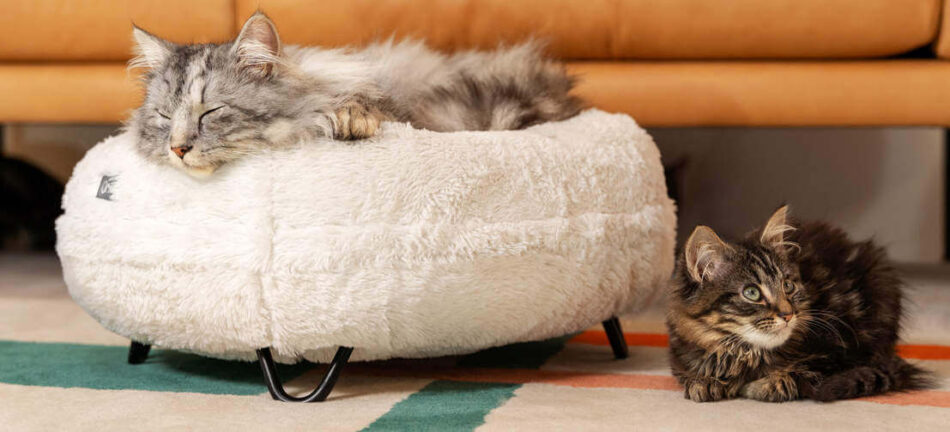
Should my pet see a dermatologist?
If you think your pet is suffering from an allergy with any of the symptoms mentioned, you will notice that the skin is affected. A dermatologist will try to recognize the cause of the skin irritation by discussing your pet’s history, for example diet, home life and behavior. Once they are able to identify the correct allergy group, they will be able to perform certain tests to pinpoint the exact cause and recommend any treatment or ways you can help.
Seasonal Common Allergies in Dogs
Seasonal allergies can affect your canine friends in very similar ways to humans. They could be affected by environmental allergens like dust mites, fleas, mold and pollens from grasses, trees, weeds, and flowers. They will not hide their discomfort and will most likely obsessively lick or scratch one particular area. Pay close attention to their bellies, paws, armpit, ears and face. During the seasons of irritation, keep your home as clean as possible and free of mites and pollen. The Topology Dog Bed provides a simple and stylish way to keep your doggy comfortable all year round with easy to clean removable and washable covers.
Seasonal Common Allergies in Cats
Cat allergies are not as common as they are for dogs, though some will display irritation from pollen or bites from fleas. If your cat sneezes a lot then it could have an allergy to pollens. As with dogs, it’s important to make sure their bed is kept clean. A good alternative is the luxury Maya Donut Cat Bed, which has a removable cover that can be washed in the machine.
Respiratory Allergies
Respiratory allergies are far less common in cats and dogs, but they can suffer from them. Symptoms are similar to those of a cold, including watery eyes, runny nose, coughs and yes, even sneezes! Some respiratory allergens could develop into asthma. This could occur from being in a smoky environment, building debris, chemicals or certain cleaning products or pollution.
Pets, like humans, benefit from fresh air, so taking dogs for regular long walks will always be good for them (and you). While you may want to take your cat for a walk, maybe it’s time to consider an Outdoor Catio, which will not only provide a safe space for your feline, but it will also provide them with plenty of space to play and explore and generally keep fit!
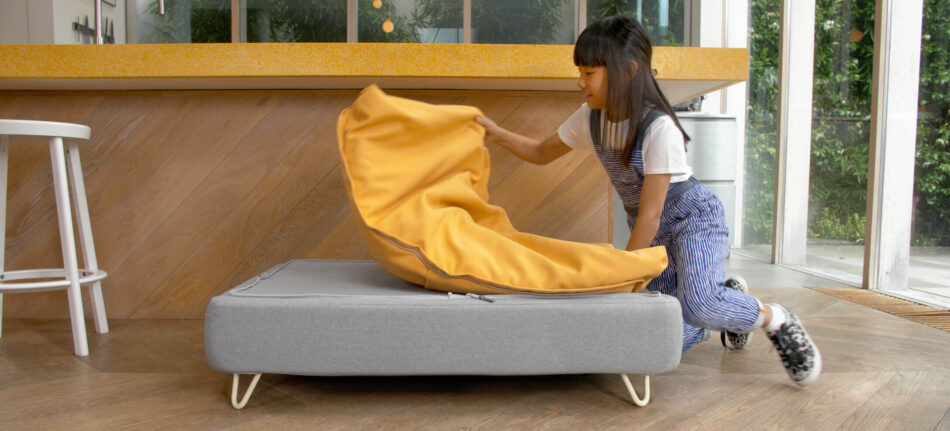
Conclusion
Being a pet parent comes with worries, but also plenty of love, laughter and snuggles along the way. Medically treating your cat or dog can be incredibly difficult to do because you don’t want to be the one that causes them any discomfort or pain, but sadly sometimes it is part of the job description and absolutely necessary to ensure they live a long and healthy life.
If you do suspect that your pet is suffering from any allergies, it is important to talk to your vet and run any concerns you have by them. Most allergies can be treated easily with medication, a change of diet or simple TLC. When dealing with allergies it is important to keep your cats and dogs home clean and you may need to adapt or change your routine to suit their needs.
This entry was posted in Cats
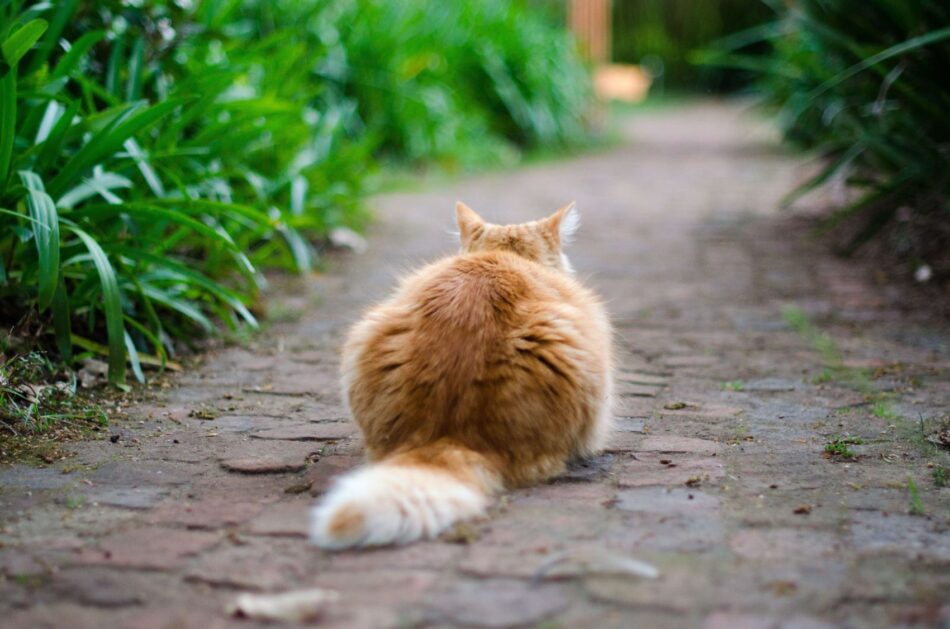
If your feline friend has turned your life into a frenzy and ran away before then you’re not alone. Cats are notoriously territorial, highly organized and routine-based, and are creatures of comfort and security. This does however not mean that they won’t abandon their home comforts if they feel the need for adventure or become distressed due to changes in their home environment. What are the main causes for our cats to run and turn curiosity into concern?
Possible Reasons why Cats go Missing and Don’t Come Back
Cats don’t just run away from home without a good reason. Indoor cats might be less likely to run because being outdoors isn’t something they are used to. Unfortunately, if something causes them to go outside and they get scared they could run out of fear and confusion. Outdoor cats might already be familiar with the perimeters of their homes, though there are many reasons why they too could run away. Here we look into various reasons why this could happen and what we can do about it if it does, so that our domesticated cats stay safe!
Your Cat was Scared
A cat’s disappearance can also be linked to fear. Indoor cats will have less access to the outdoors mostly for safety reasons or lack of outdoor space. They can be scared by loud noises, an unwelcomed visitor, for example a neighbor’s dog or something unfamiliar to them, and it doesn’t take long for your purrfectly happy pussycat to turn into a scaredy-cat. They certainly enjoy a peaceful environment and can often become quite disgruntled when that peace is disturbed. If their home life has become unsettled due to divorce, children leaving home or moving house their impulse could be to escape what may seem like a dangerous environment.
They’re in Season (or looking for a cat that is!)
This is something to watch out for, especially when female cats are in heat. When unneutered male cats get a whiff of a reproductive female there’s little you can do to distract him! It is not uncommon for cats to follow their mating instinct and they could disappear for days during this mating season.
As an owner of a female cat, it may be a good idea to keep them in during this time to avoid this dilemma and a few worried cat owners. Otherwise, ensure that your cats are neutered, which will diminish this instinct.
They were Stressed
As we have looked at some of the common, perhaps less threatening, causes for cats to run away, it is important to address the more serious reasons, which can be down to changes to the home environment and the stress that this can cause to our pets in general.
Cats are independent and can often be quite aloof and lead us to believe that they are pretty resilient, but this is not at all the case. They crave the security of home life, and while they’re not as dependent on us as dogs are, they love their human families and are very protective of them. As we spend so much time with our pets, they develop possibly more human characteristics than we realize. When our lives become unsettled, so do theirs. Take the time to explore cats and stress, why it happens and how to spot it.
Cats do suffer from separation anxiety, which may be more apparent as we emerged out of various lockdowns and headed back to work. If the home routine changes, cats will notice and can often become very distressed. This could lead to some more challenging behaviors, however, running away is unfortunately also very common as a result of stressed home life.
They’re Cheating on You
If you’ve noticed that your cat has put on a little weight, it’s not unlikely that an overly friendly neighbor is feeding them. Cats absolutely love being spoiled and they can be very sneaky and often get what they want. It’s unlikely that anyone will just allow a cat to be a permanent resident of their home without checking if they belong to anyone, but it’s best to be on the lookout. If you become aware that this in fact is happening, just have a polite word with the person(s) in question and stay one step ahead of your greedy pussycat.
You Didn’t have an Outdoor Catio
Allowing space for your cat to challenge itself and play is really important. At Omlet we have developed our Omlet Catio range, which provides a safe and secure place to do just that. Conquer the curiosity in your cat’s personality, let them climb, hang, balance and relax as if they were out in the wild. This way you can entertain your cat’s natural instincts and keep them safe at the same time.
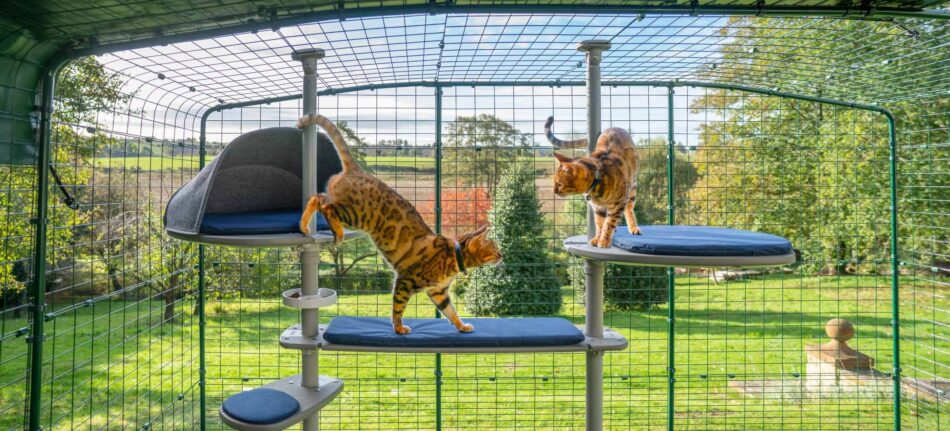
Natural Predators
Cats are determined hunters and once that animal instinct kicks in they can go for miles, extending their hunting perimeter. It is possible that they become so distracted pursuing their prey that they get lost! More often than not, they will return, perhaps rather hungry and slightly embarrassed that they managed to get lost in the first place!
Disease, Injury or Death
Outdoor cats are more prone to sickness and injury than indoor felines. That could be due to infection from ticks, fighting with other cats, poisonous plants or food. For this reason, your cats are safer in an outdoor cat run so you know where your feline is at all times.
If you’re concerned about your cat once they’ve returned from a stint in the great outdoors, it is recommended you take them to the vet immediately to get them checked over.
In a desperately sad situation, and one we don’t like to think about, some cats will wander off to die. A senior cat who knows they are nearing the end of their life may wander off to be alone. Cats who are very unwell, often hide away and some will not return. If you do have an elderly cat or one that’s unwell then, it’s important to make sure they stay warm and comfortable. So, what are the best ways to keep your cats warm? Pay attention to your cuddly companions, because after all that is what they are, companions, and you want to make sure that they are looked after in the best way possible.
Picked up By a Moving Vehicle
Wandering cats may find themselves in a tricky situation if they end up creeping into an open car or delivery van and falling asleep! Given their size, they could easily go unnoticed until much later. A more worrying or unimaginable reason would be that they have been catnapped. Sadly, they could easily be picked up by someone and they wouldn’t be able to give that much of a fight. Your cat’s safety is important and given all these external factors and fears it is recommended that your cat is microchipped, even if you have an id tag on your cat’s collar. That is better than nothing, but it’s worth noting collars can also impose a risk to your cat’s safety when climbing trees or getting stuck in bushes.
What Should I Do if My Cat is Missing?
If you have a missing cat, try not to panic. Despite feeling helpless, scared, and worried it is important to get on the case and take action as soon as possible. There are multiple reasons why cats run away or wander off, and more often than not they will return, but it’s always best to be prepared. Whether you have an indoor cat or a predominantly outdoor cat who often roams freely, finding out they have gone missing is a frightening experience. Get as many people as possible involved in the search and contact a local shelter or vets so that they too can keep an eye out.
Don’t Beat Yourself Up
As a cat lover, you would naturally be devastated if your cat runs away. You have probably done everything you can to provide the most comforting home for your furry friend, but cats do sometimes run away, and it’s won’t necessarily have been your fault. So, try not to be too hard on yourself! If you can identify why your cat may have bolted, it might help work out how to get them back.
Post on Local Facebook Groups
The internet is full of animal lovers and can be a very useful resource in a situation like a missing cat. Post an up-to-date photo and description of your whiskered friend in some local Facebook groups, this way you’re increasing your chances of finding him/her. Someone may have spotted your lost cat, which may give you a clue as to which direction they have gone in!
How Missing Cats Find Their Way Home
Most cats are capable of finding their own way home to their cat parents. Our animal’s ability to retrace their steps even after a few days following the scent of an unneutered male or female cat or chasing after prey is part of their natural homing instinct. So, if you’re a cat parent to a runaway cat, don’t jump to the worst conclusion. There is always a possibility that they will return.
If you have recently moved house a cat can potentially try to find their way back to its previous home. It has been reported that cats can travel hundreds of miles over the course of a few months, if necessary, just to get back to what they think is home. It’s not recommended to let your cat out when you first move, because they need to get used to their surroundings first. You can attempt to use a cat leash and harness, which isn’t always straightforward. Cats, unlike dogs, aren’t particularly keen on being “walked”. Another suggestion is to carry your cat around the yard or down the driveway or road so that they can become a little more familiar with the perimeters of their new home.
Their Favorite Treats Were Left Out
Domestic cats love being spoiled, and they enjoy a treat or two! Leaving some of their favorite Cat Treats out may well entice them back after their recent wanderings.
They Missed You
Not all cats run away from home on purpose. It is likely that something caused them to run. Your relationship with your feline friend will have a big impact on how they feel about you. Cats are often treated as a family member and they recognize that, so they will miss their cat parents after a while and crave the comfort of home life soon enough.
They Decided to Come Back
After the mini adventure, they might realize that being away from home isn’t that great and will just return by themselves! The prospect of a nice warm lap to sit on or the pleasures of their own Maya Donut Cat Bed will beat staying out in the cold and having to fend for themselves. Cats are independent beings, but they are guilty of wanting human interaction and creature comforts.
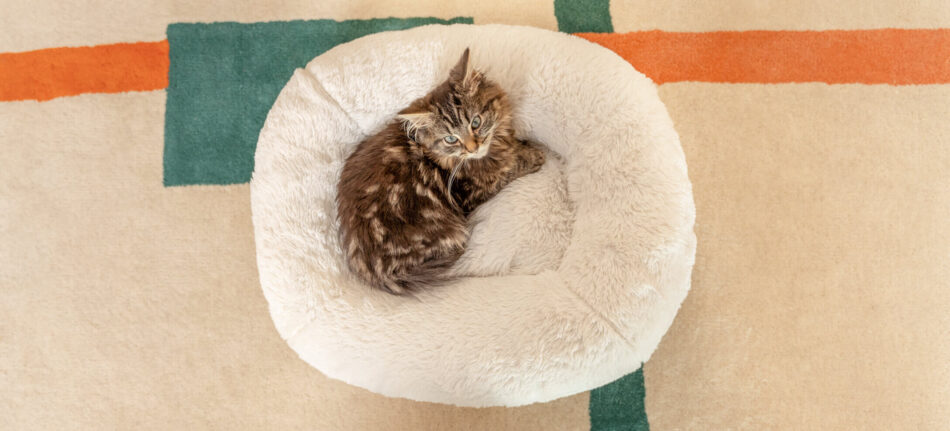
Why Do Cats Run Away from Humans?
Despite your best efforts cats may feel a bit neglected due to changes in your life such as a more demanding job, a new partner or a baby, which would naturally require more of your attention. You may have less time to devote to your kitty, which can make them look for attention elsewhere. A cat’s personality craves attention and play, and even though they may act like they don’t need their cat person, they really do.
Make sure that you dedicate some time to your cat, and why not provide them with a Freestyle outdoor cat tree setup which is an excellent source of entertainment and exercise, especially if you are perhaps a little busier than usual. Your cat will thank you!
Humans are Much Bigger and Can Seem Intimidating
Cat owners naturally adore their whiskered freinds and would do almost anything to protect them, however, it’s worth taking into account not all humans feel the same, with some even being afraid of cats. Many cat parents will be recognizable to their kitty babies, but they may feel a little intimidated by humans they have not come across before. Cats can certainly pick up on any negativity from humans that might not be so welcoming to a small four-legged furry friend.
You Might’ve Been too Rough with Them
Cats are not as tough as they might seem, and remember, they are only small creatures! Your strength could be overpowering to them and frighten them. So when you are playing with them, be careful that you’re not too rough! When there are small children around, it is important to keep an eye on how they behave around cats, especially if they don’t have any of their own. Children might not understand how to play and often tug at the tail, which certainly will not impress our furry feline.
How Can I Stop My Cat from Running Away from Me?
Take into account your current home life and any changes, whether there are other animals to contend with or new humans to get used to. Cat’s don’t like to feel second best, so there are feline aids that will make them feel extra special, like the Luxurious Maya Donut Cat Bed that will leave your kitty feeling like a king or queen. It is important to build a good relationship with your cat and understand their unique personality.
Build Trust
Whether you bring up your feline from a tiny kitten or take in a shy rescue cat, your relationship with them as the primary caregiver needs to be consistent. The trust between this small creature and their cat parent is fundamental to their happiness, and ultimately yours too!
Positive Reinforcement
Reward your kitty cat whenever required to do so, because knowing that they are loved will reinforce their desire to stay with you and not try to escape if the moment presents itself.
- Entertain your cat with fun and stimulating cat toys by exploring the fun side and predatory behaviors rather than trying to diminish it
- Provide more accessories to their customizable Freestyle cat climbing frame
- 2 legged human companions respond well to the occasional promise of chocolate or sweets and that includes cats! Reward them with some tasty cat treats
- Love, lots of love! Shower your cat in love, which will ultimately be the best reward ever!
Create a Safe Space
In a potentially unsettled environment, if you have moved house, welcomed a new member to the family or have suffered a loss within the family your cat will feel this unsettled feeling in the same way. Make sure you provide a safe and secluded space for your cat, like the Omlet Maya Indoor Cat House, which gives your pussycat a super snuggly cozy house away from any disturbances. Introducing your cat to a new house might take a little time, but we can help you get your cat used to a cat house and they will be purring away with happiness in no time.
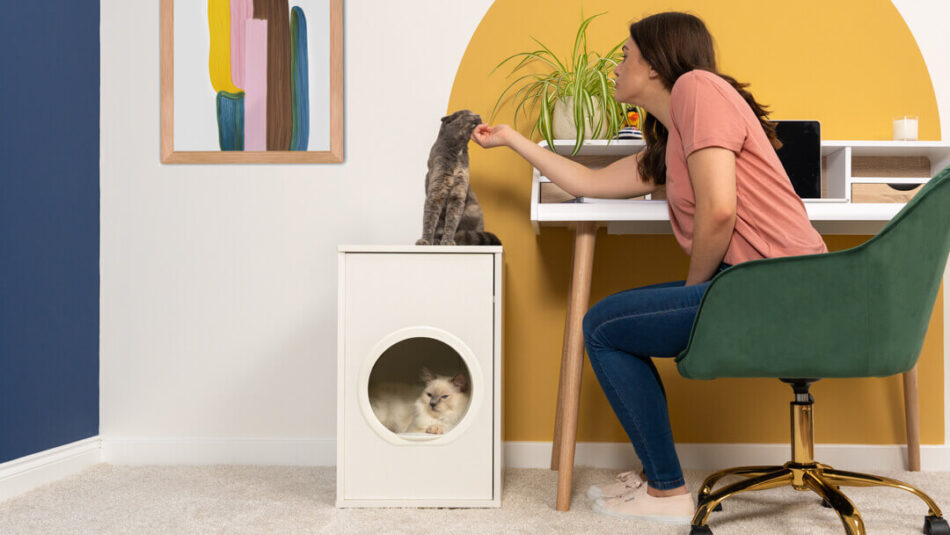
Conclusion
It is very important to provide a safe home for your cats and gradually get them used to a new routine if anything changes at home. Cats love order and change can cause them to feel stressed, scared or even unwanted. When cats feel threatened, they usually respond in three ways to the object, individual or circumstance: fight, flee or freeze. Sadly, for us, cats running away from home is more common than we would like, and while the prodigal pussycat will often return when they please, it is important to be prepared for every possible situation. For peace of mind, ensuring that your cat is microchipped with up to date information is very important, and for the owners of indoor cats who don’t roam freely, give them the sense of the great outdoors and feed their curiosity with an outdoor catio, or a cat balcony enclosure.
This entry was posted in Cats
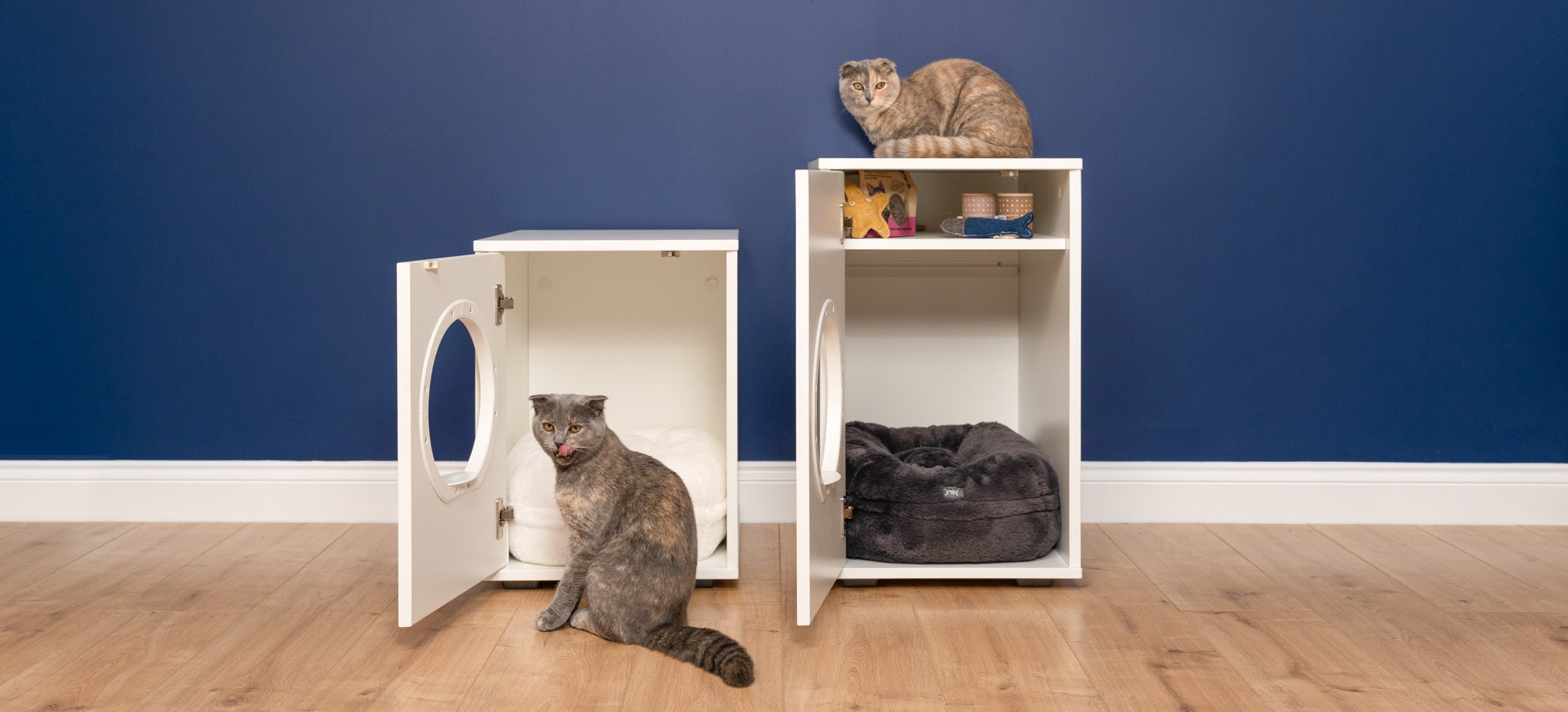 While cats can be great companions, most love having their alone time too. This is because cats are solitary predators, meaning that they hunt alone as opposed to in packs like our canine furry friends do. Cats will also establish their own territory via spraying, ‘claiming’ an environment as their own, which is somewhere they should be left undisturbed. This is why it’s a good idea to invest in a cat house – a safe and quiet space for your cat to relax in privacy, away from the chaos of the rest of the household! But how do you get a cat to use a cat house?
While cats can be great companions, most love having their alone time too. This is because cats are solitary predators, meaning that they hunt alone as opposed to in packs like our canine furry friends do. Cats will also establish their own territory via spraying, ‘claiming’ an environment as their own, which is somewhere they should be left undisturbed. This is why it’s a good idea to invest in a cat house – a safe and quiet space for your cat to relax in privacy, away from the chaos of the rest of the household! But how do you get a cat to use a cat house?
Firstly though, if you’re unfamiliar with what a cat house is exactly, they’re a shelter specifically designed for cats to be able to retreat to. Whilst some cat houses are designed to stay outside in the garden, should you have an outdoor cat, they’re not an alternative to your cat living inside of the family home. Think of it more like a home within a home for your pet.
A frequently asked question is whether cats actually like indoor cat houses. The answer to this is yes! If your cat has never used a cat house before, it could take them some time to get fully used to the idea, and they may not immediately take to their new cat house. However, rest assured, there are steps you can take to get your cat comfortable within their new shelter and once they’ve settled in, they’ll love getting cozy in their own little den!
How Will My Cat Benefit from a Cat House?
Indoor cat houses are beneficial to cats for a number of reasons, as we’ll find out. Furthermore, the Omlet Maya Indoor Cat House is great for humans too! The stylish and easy-to-clean design will fit into your home perfectly, doubling as a storage facility, making for an ideal solution all round.
Privacy
If you live in a fast-paced household, your cat might not always appreciate being the center of attention! A cat shelter will be beneficial to your cat in that it allows them to have privacy in their own shelter, moving them away from the hustle and bustle of the home.
Safety
Another benefit of a cat house is that they provide your pet with an enclosed environment, which gives them an element of safety. If you’re a cat owner, you may be familiar with cat hiding behavior, which cats do because a secure space can make them feel safe. It’s not usually anything to be concerned about, unless it becomes excessive, which could then be a sign of an underlying issue. If you notice your cat also avoiding eye contact, running away, or tucking their tail under them, they may be suffering with anxiety. In this circumstance, it’s always a wise idea to get advice from your vet, however, a cat house offers anxious cats their own hideaway within the family home, that will give them assurance that they have their own ‘safe zone’.
Comfort and Coziness
A cat house will also provide your cat with a comfortable, cozy, and warm space, which is especially important during the colder months. You can place your cat’s bed inside of their indoor cat house, so they can enjoy sleeping and relaxing in their snug shelter.
How do I Get My Cat to Use a Cat House?
Just as you’d make your bedroom your own with cozy furnishings and decorations, it’s important that you make your cat’s house into a home too! By creating an environment your cats love, it will make it a lot easier for them to get into the swing of getting into their cat house.
Treats
It’s important that your furry friend associates their house with being a positive environment. One way to do this is by using cat treats to lure them in. Simply place some of your cat’s favorite treats in and around their cat house and watch as they are unable to resist going in. This form of positive reinforcement will make for a much simpler transition. Once your kitty has realized that the shelter is somewhere they actually enjoy going to, you should no longer need treats to guide them in, and they should willingly walk in by themselves.
Catnip
Why not try some catnip? – a firm favorite amongst a lot of cats, due to effects of the chemical compound nepetalactone, found in the leaves of catnip. You can read more on why cats go crazy for catnip in this previous blog here. Unless your cat is unreactive to the substance, the scent can’t be missed by cats, so it’s a perfect method for trying to get them to enter their shelter. You can use catnip either in its natural form, dried or flaked, or in catnip treats. Just as you would with regular treats, simply sprinkle your catnip in and around their cat house to tempt them in.
Toys
If your pet is a fan of catnip, Omlet also provides a number of cat toys that contain the ingredient, which can be used to entice your cat into their house. this can be used to entice your cat into their house. If your cat isn’t too big on the stuff, don’t worry, as you can use any other type of cat toy that they really enjoy playing with. Initiating play with your cat and any of their favorite toys outside of their cat house, again will allow them to make positive associations with their house, teaching them that great things happen when they go near the shelter!
Chase toys are particularly good for this activity, as it will mean that your cat could end up chasing the toy directly into their house. Cats have a natural instinct to chase, meaning that many go wild for these types of toys.
Additionally, once your cat has settled into their house, it can also be used as storage for their toys!
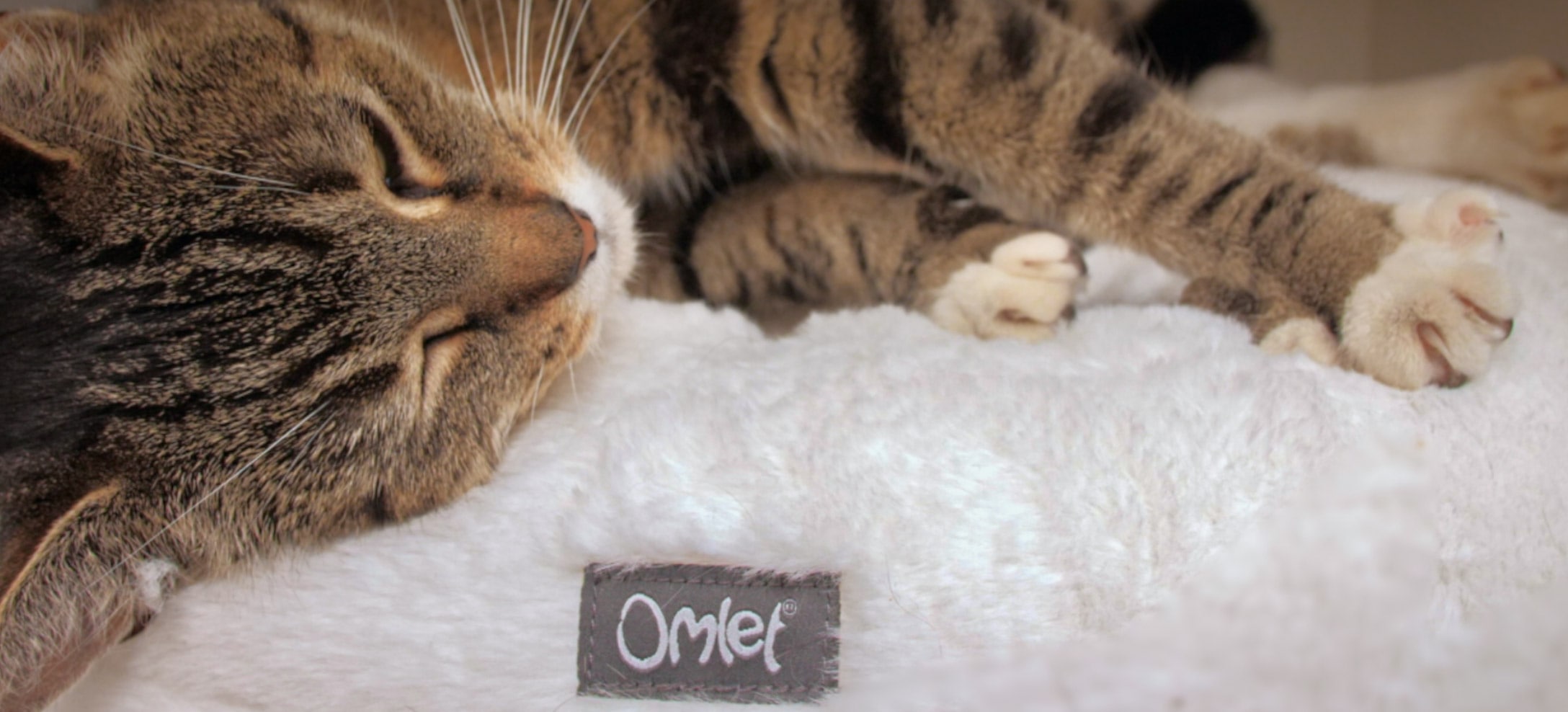
Comfy Bed
Placing a comfy bed on the floor of their house is one way to get your kitty to use their house. Since your cat could end up spending a lot of their time in their den, it’s only right that their bed provides them with an optimum level of comfort. The Maya Donut Cat Bed is a great option to go for, with a deep cushioning that will have your cats sinking into the bed of their dreams.
Warm Blankets
With winter round the corner, placing a blanket inside of your cat’s den will be warmly welcomed by your pet. You can also position a soft blanket on top of your cat’s bed inside of the shelter to give it more of a luxury feel and have them keep even more cozy. Just as a comfy bed can work to tempt your cat into using their house, a warm blanket will be equally irresistible.
Where Can You Put Your Cat House?
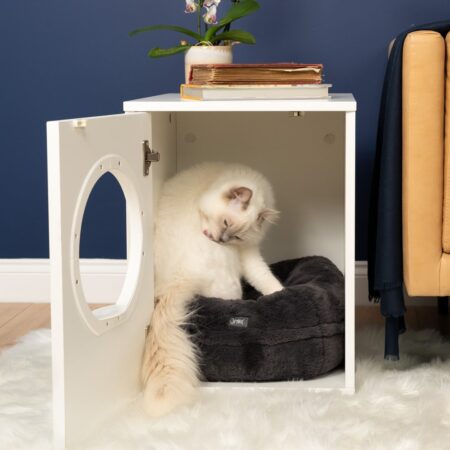 There are a number of different areas in your home that may be appropriate to place your cat house. This depends on your living situation, and your cat’s preferences. Do they like to be involved with family time or would they prefer to have their shelter in their own quiet room? As we earlier mentioned though, if you have outdoor cats, it’s not recommended that you place your Maya Indoor Cat House outside, as it is designed for indoor use only.
There are a number of different areas in your home that may be appropriate to place your cat house. This depends on your living situation, and your cat’s preferences. Do they like to be involved with family time or would they prefer to have their shelter in their own quiet room? As we earlier mentioned though, if you have outdoor cats, it’s not recommended that you place your Maya Indoor Cat House outside, as it is designed for indoor use only.
When deciding which room to put your shelter in, you may also want to consider factors for yourself such as how easy it will be to clean and whether it will look right in your home.
In a Quiet Room
As mentioned, most cats prefer a quiet life. If this is applicable, then a quiet room would be the perfect location for your house! If you have a room in your home that is not frequently used by other members of the household and is also not close to anywhere in the home where you can hear a lot of noise from the outside e.g. traffic or noisy neighbors, then this could be the right solution for you and your cat.
The Kitchen
Maybe you have a cat who likes to be more involved with family time. If this is the case, the kitchen might be best suited to placing the indoor cat house in. Furthermore, if you keep your cat’s food and water bowls in this room, then it will mean they’ll have the convenience of this too!
The Living Room
Similarly, you can also place your indoor shelter inside of the family living room, if your cat doesn’t mind a bit more noise. With the Maya Indoor Cat House, the contemporary and stylish design means that the shelter can fit in perfectly with any existing furnishings, so you needn’t worry about it clashing with your home. Furthermore, if you have any concerns about keeping a house in your living room from a cleaning perspective, the Maya Indoor Cat House can easily be hoovered and wiped down after use.
The Bedroom (If You Don’t Want Them on Your Bed!)
To have your pet in the bedroom or to not have them in the bedroom? This is a common debate amongst many pet owners, but there’s not a one size fits all answer to this question. While some cat owners rule pets out of the bedroom completely, some will happily doze off with their cat at the end of the bed every night. If you’re not particularly keen about having a cat on the bed but do enjoy having their presence in your bedroom, then you can try placing the house in a corner of your room. This way, you’ll have the benefits of sharing a room with your cat but it will save you from having to clean up any cat hairs from the bed and you’ll both have your own personal space – a win-win situation!
An indoor cat house is a fantastic idea for both cats and humans, even if your cat does initially struggle with using it. What is important is to be patient and not to give up if one method of helping encourage them to use it doesn’t quite do the trick. Hopefully with a few of our tips your cat will love using their cat house soon enough!
This entry was posted in Cats
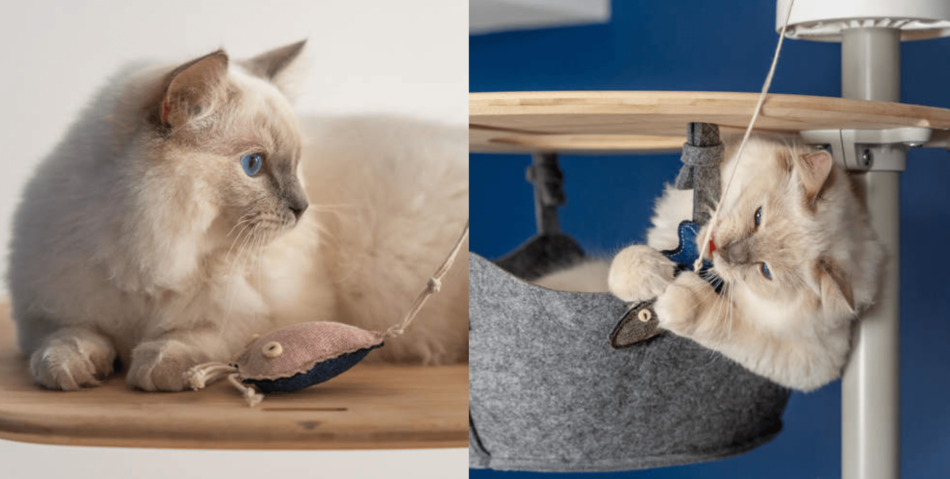
What Is Catnip?
Whether or not you’re familiar with cats, you’ll likely have heard of catnip. Renowned for sending cats “crazy”, catnip is actually a member of the mint family that also goes by the name of Nepeta cataria. The plant grows in Europe, Asia, Africa, and North America, containing nepetalactone, an oil, or chemical compound, found within the catnip’s leaves.
When cats sniff catnip, the nepetalactone enters their nasal tissue, sending signals to the brain. This stimulates sensory neurons, targeting receptors that usually result in behavioral changes. As your cat reacts to the herb, you may witness them shaking their head, licking, rubbing, leaping, or rolling around. Their behavior can also mimic a cat being in heat, even for male cats, with others displaying feelings of euphoria through being overly affectionate, relaxed, or playful.
How Can I Use Catnip?
Catnip is widely available in a number of forms. Although you can use the plant directly in its fresh, natural state, most commonly, catnip is found dried, or flaked. This can be used on anything including toys, bowls, or simply be scattered around your home. Alternatively, you can purchase catnip spray to spritz onto your cat’s favorite things. Catnip toys are also very popular, with the herb being used in a number of different types of toys including Omlet’s collection of ocean-themed Maya Cat Toys. However, don’t worry if your cat isn’t a fan of catnip, the toys are also available without.
Why Do Some Cats Not Like Catnip?
Seventy percent of cats will show some reaction to the plant, and whilst most go wild for the stuff, others simply aren’t interested or won’t respond to catnip. This isn’t anything to be concerned about and may be for two reasons. The first being that your feline friend lacks the gene that makes them responsive to catnip. The catnip response is hereditary, relating to the autosomal dominant gene which, interestingly, is not exclusive to domestic cats. Also found in big cats such as lions, fascinatingly, they too can be affected by catnip with effects lasting for up to an hour, compared to a reaction usually only lasting for up to fifteen minutes with our domestic cats!
Equally, your cat’s age may be another reason as to why they seemingly do not like or are not interested in catnip. Catnip is not harmful to kittens; however, researchers have found that kittens under eight weeks old show no reaction to catnip. Cats usually show signs of whether they’ll be a catnip lover or not by the time they reach around six months old.
Benefits of Catnip
Anxiety Reducing
As we earlier discovered, catnip can have a sedative effect on cats. Consequently, this can help with their stress levels and in turn, work as a natural form of anxiety relief.
Pain Relief
Research suggests that cats may actually benefit from catnip as pain relief. The plant has the potential to work as a short-term solution for cats with muscle pain or arthritis, similarly to how aspirin or paracetamol works for humans.
Encourages Play
With cats often becoming highly energetic after interacting with catnip, this encourages play and exercise, even more so with catnip toys that are bound to give your cat hours of enjoyment. If your cat is particularly playful, they’ll have great fun chasing around the Maya Cat Wand Toy with catnip, and the detachable wand makes it easier for you to raise the toy up high.
Can Help with Bath Time
If you’ve got a cat that doesn’t love bath time quite as much as they love catnip, then adding catnip to their bathwater might make things a lot easier for the both of you. Catnip can make a bath a lot more appealing for your pet, which you can do by adding up to a teaspoon of flakes to boiling water, allowing it to soak, and then putting it into the bath.
If you do decide to give your cat a taste of some catnip for the first time, you’ll want to initially start off with a small amount to gauge their reaction. Should your cat respond well, you can continue to incorporate it into their routine up to a few times a week. Fortunately, catnip is a completely safe product, and your cats will not be able to overdose from it. At worst, your cat may experience some digestive issues, however, most cats will let their owners know when they have had enough by refusing.
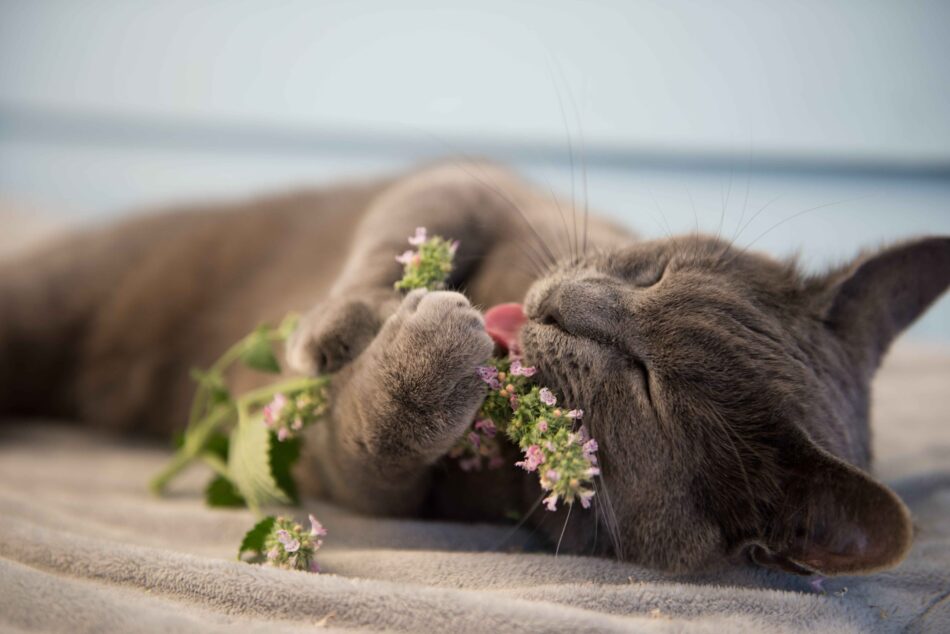
This entry was posted in Cats
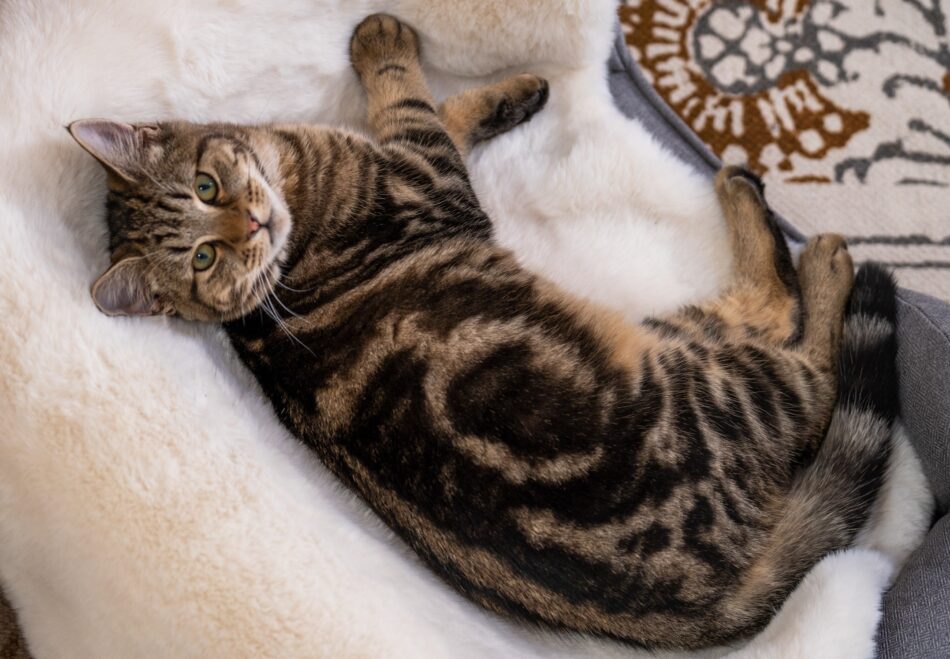
Let’s face it – all cats shed, and keeping your home free from loose fur and other messes isn’t always easy. But keeping on top of a fuss-free hygiene routine and having the right products for your purry pal will have your house clean in no time! Keep reading for feline-approved top tips.
Grooming goes a long way
Grooming does way more than just make your cat look great. It’s also important for getting rid of loose fur from their coats and your home. If you’ve got a bit of a fussy feline on your hands, try placing down cat grooming mats on the table and chair legs in your home. This way, kitty can avoid the brush but it still means getting a groom. These mats cling to the loose fur so that it doesn’t float through your home. Plus, you can easily pull hair out from the mats and clean it as necessary. Still in need of some cat fur-collecting techniques? Read our complete guide on removing pet hair from your home.
Say goodbye to litter box mess!
Another source of mess in our homes with cats is their litter box. Not only because of the odors and unsightly mess that comes with it, but cats will also carry out the litter on their paws, also known as ‘tracking’.
Thanks to Omlet, there is a solution to all of the above! The Maya Jump On Top Entry Cat Litter Box features an anti-tracking platform which, once they’ve done their 1s and 2s, cats will step out onto before jumping down from the box. The platform has tiny holes which allow the loose litter to fall through and back into the litter box as your cat jumps out! This significantly reduces the amount of litter they carry out with them, meaning you won’t step on tiny grains of litter.
If that wasn’t clever enough, the anti-tracking platform also has an active carbon filter. This effectively absorbs and controls bad odors before they emit from the litter box. Plus, the litter box has a wipe-clean, waterproof liner which makes it super easy to maintain a clean, odor free and hygienic environment all in a discreet, furniture-style box that will give kitty the privacy they desire.
Air-purifying, cat-friendly plants
Air-purifying plants in the home help to improve air quality and contribute to a fresher, hygienic feeling for everyone. There are lots of cat-friendly plants, such as the Boston Fern and Lavender, which will have your home smelling great! If your cat likes to play with plants, claw at the soil or chew on the leaves, you might want to consider smaller plants out of reach, or more robust plants.
Cat sheets need changing too
It’s much easier to maintain a fur-free, clean and hygienic home when living with a cat if their favorite sleep spots are easy to wash. That’s why we designed a cat bed with a removable, machine-washable cover…
The Maya Donut Cat Bed offers an easy clean solution! All you have to do is unzip the cover and pop it in the washing machine on a gentle cycle with a mild detergent. Leave to air dry and pop the cover back on – it’s super simple!
You can also raise the bed with stylish feet, which not only look great but also improve airflow beneath the bed to prevent a build-up of fur, dust and moisture and protect your carpet. The Maya Donut Cat Bed is a great hygiene solution, and is super cosy and soft for cats who desire the best!
Protect your furniture with easy-to-clean blankets
If your feline friend prefers to curl up on the sofa, you can encourage your cat to sleep in their own bed to protect your furniture from fur, dirt and sharp claws! But if you’re still working on convincing them, a dedicated cat blanket, or two, is a simple solution to creating a barrier between your nice clean sofa and your cat’s fur and mucky paws. The Luxury Faux Sheepskin Cat Blankets are super duper soft, and they’re available in three sizes! Your cat simply won’t be able to resist snuggling down on these dual-sided, quilted throws!
Have a pet-safe cleaning kit on hand
A strong vacuum cleaner is an obvious choice to keep pet fur at bay, but there are other essentials you should have in your pet-safe cleaning kit. Lint rollers are super handy for running over clothes, cushions and blankets to quickly lift any clumps of loose fur. Fabric freshener sprays are also a must for eliminating any bad odors which cling to curtains and sofas. A pet-safe carpet cleaner is bound to come in useful when you’re faced with muddy paw prints or other accidents!
Wipe clean feed bowls
Regularly cleaning your cat’s feed bowls is also an important step in reducing odors and maintaining hygiene in the home. Make sure they’re sturdy, can be wiped clean and in a quiet spot with little footfall. This way, your cat can have privacy while they eat, and the food smell won’t upset visitors or attract other pets and children! Putting the feed bowls on a wipe-clean mat will also protect your floor, especially carpets, from food mess or spilt water.
Keeping a clean cat home with Omlet
Keeping your home clean when you live with a cat doesn’t have to be a chore! Omlet has designed solutions to all of your cat’s needs, so take a look at our expertly designed Cat Beds, Cat Blankets, Cat Bowls and more to discover how Omlet can help you to keep your home clean, and your cat, happy!
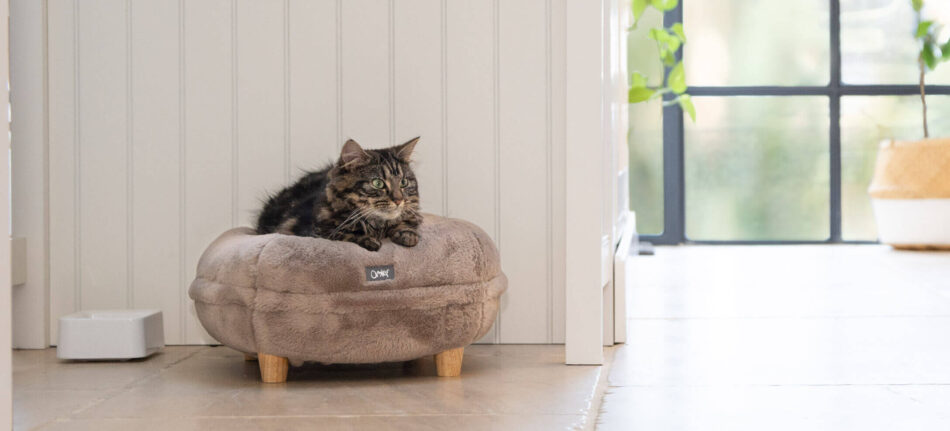
This entry was posted in Cats
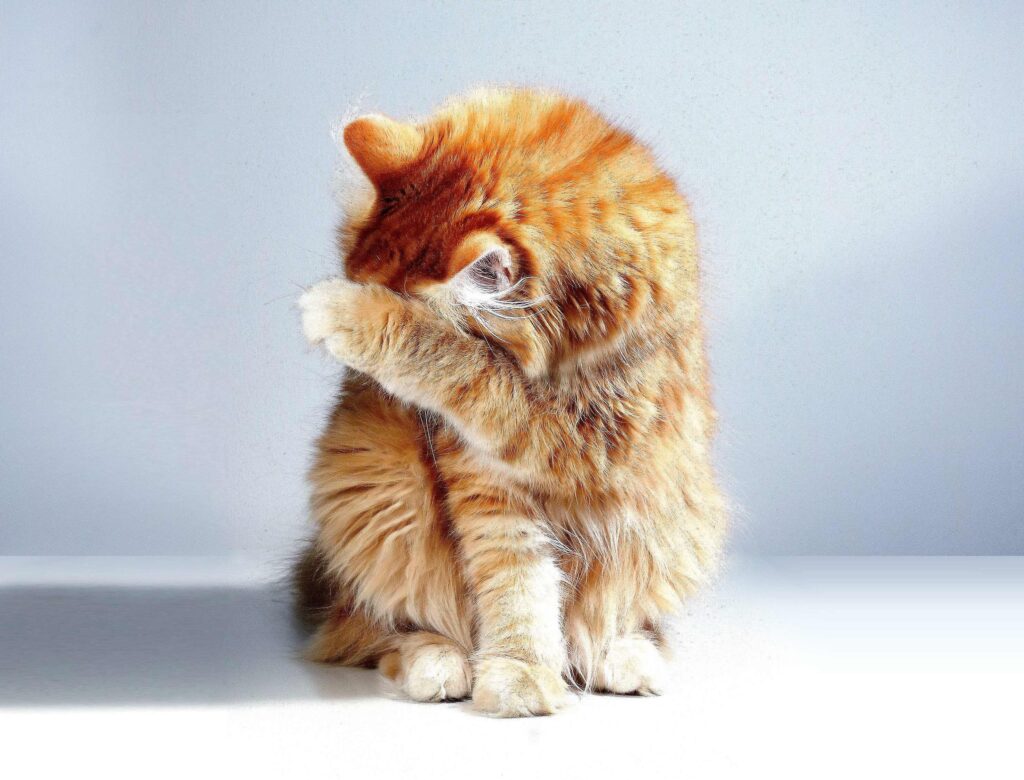
While some cats follow their owners to the bathroom and don’t understand the concept of privacy, many are still wary of who’s watching when they go to the bathroom themselves.
Some cats will do their business solely outside, others might do a bit of both, perhaps preferring a warmer toilet in the winter months. Many cat owners choose open litter trays, and don’t always have the option to have the tray hidden away.
But how do cats feel about doing their business?
Why do cats prefer to poop in private?
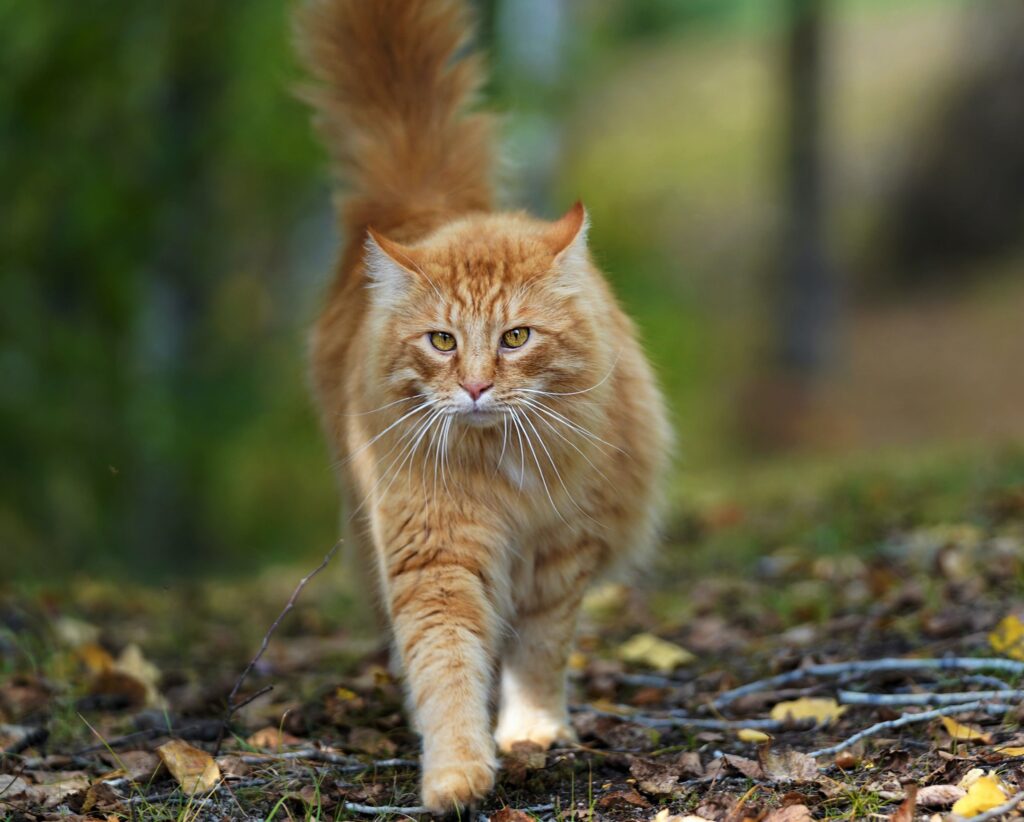
It’s easy to empathize with our feline friends’ desire for privacy when we remember the troubles their ancestors faced and the natural instincts that’re placed in our cat’s mind.
Cats have a deep-rooted urge to be alert at all times. Their desire to protect themselves and be wary of their surroundings extends to the toilet.
Using an uncovered litter box while other people are around can make a cat feel extremely vulnerable and exposed, this may especially be the case for anxious cats and rescues.
So, it of course makes sense that some cats may prefer to do their business in private, without disturbances, somewhere they can feel safe and comfortable to relieve themselves without the potential of being attacked!
What’s the best litter box for privacy?
Open litter trays give the most exposed and vulnerable bathroom experience for cats, and for you they offer the least in the way of odor and mess control. An enclosed litter box, such as the Maya Jump On Top Entry Litter Box, allows your cat to drop down into a dark and secluded litter box, giving them a feeling of peace and privacy to do their business.
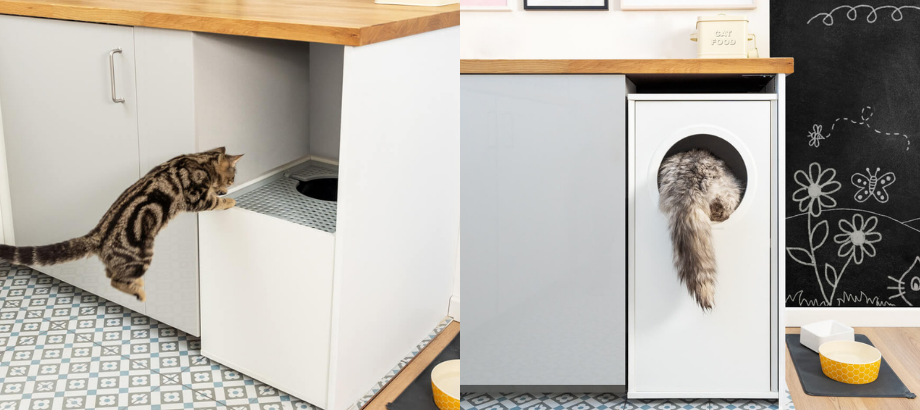
The Maya Jump In Litter Box takes that privacy one step further with a high entry point where cats can jump in and step down into a completely covered litter box. In the Jump In, cats can feel completely at ease that no dogs, children or adults can watch or touch them while they’re using their toilet.
For you, the Maya Cat Litter Box also offers an effective odor control solution, reducing tracking mess around the home thanks to a grid platform which collects loose litter from your pets’ paws, and an easy wipe clean litter liner, with a cute underwater scene printed on the inside for your cats to enjoy.
The Jump In’s optional storage space is a great place to keep spare litter and poop bags, and the discreet pocket on the side of the litter liner holds a complimentary, fold-flat scoop, meaning everything you need for used litter removal is always on hand.
Best of all, this litter box fits in your home seamlessly, designed like a discreet cubicle, with no hint to what’s going on inside. This gives your cat that all important privacy and keeps all the mess which comes with loving a cat hidden out of sight from you and your guests.
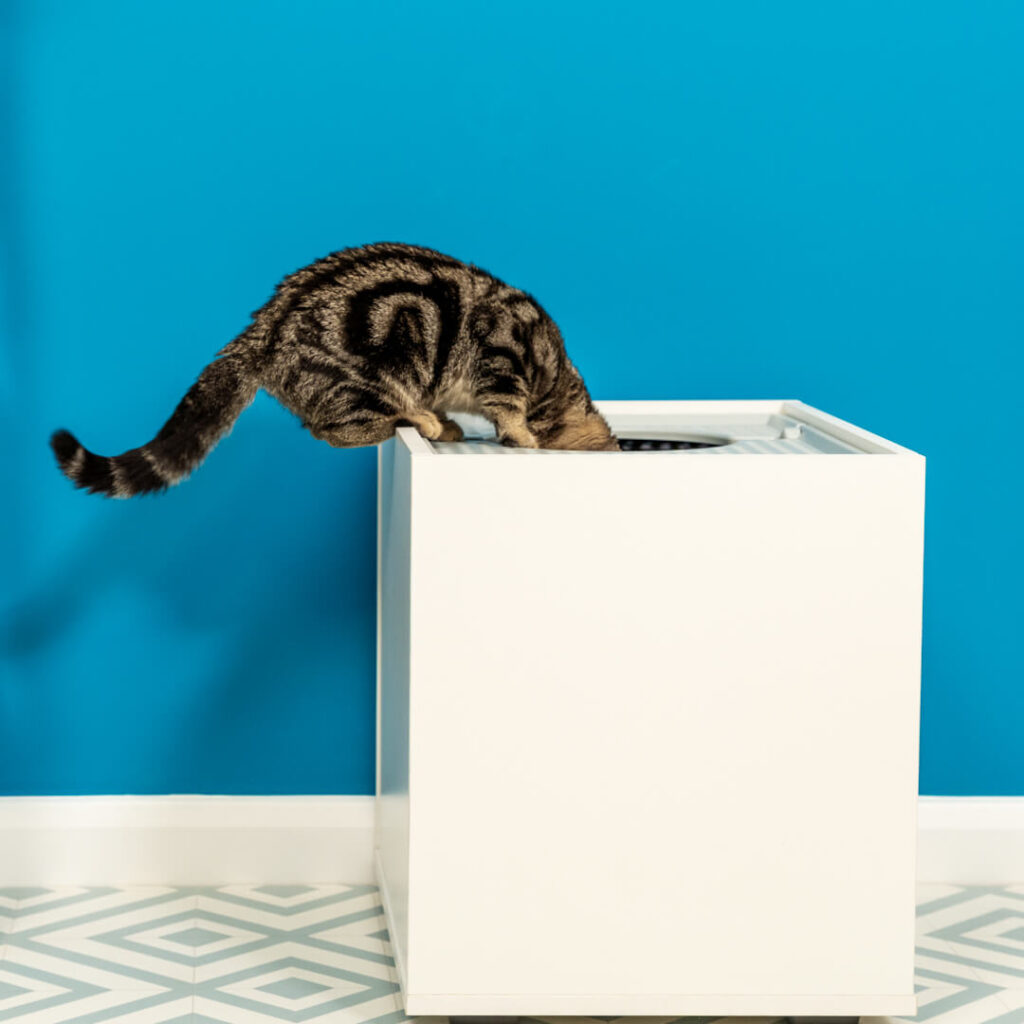 What else can I do to help my cat feel comfortable?
What else can I do to help my cat feel comfortable?
As well as an enclosed, private litter box, there are other things you can do to minimize any feelings of vulnerability your cat may have when they use the toilet.
If you notice your cat is visiting the litter box frequently but never leaving any mess behind, it might be a sign that they have been disturbed and not felt safe enough to do their business.
Leave the room for a while to give your cat the opportunity to use their litter box without noise and disturbances. If you have children or other pets in the house, encourage them out of the room with you so your cat has complete privacy.
If you can, place the litter box in a room which is not frequented often and rarely gets noisy, for example a bathroom or utility room.
Do cat’s dislike using dirty litter boxes?
Another reason for cats being reluctant to use their litter box or visiting without using it, could be that the litter tray has already been used and is dirty. Cats can be incredibly fussy about mess and filth in the litter box and may decline their used litter as to not dirty their paws!
Make sure you are regularly removing used litter from the litter box, and that you choose a litter with strong odor control qualities.
Use the fold-flat scoop in the Maya Cat Litter Box to remove the used clump of litter, and the loose, clean litter will fall back into the litter box through the fine holes in the scoop.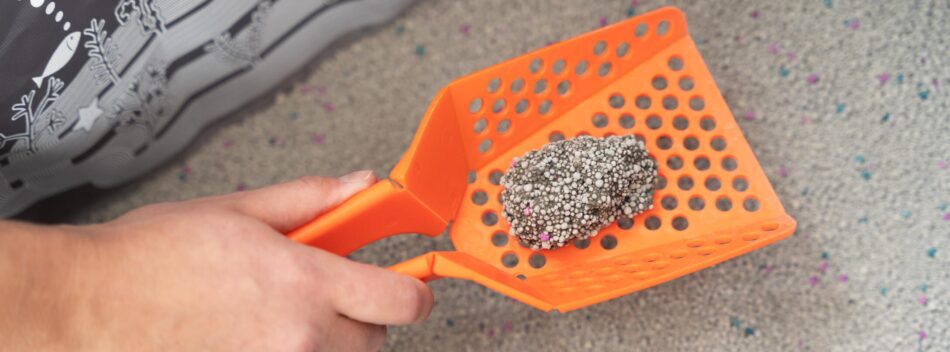
What are the best litter boxes for a multi cat household?
Covered litter boxes are also a wise choice for multi cat households where cats may prefer to do their business in secret from their house mates! Cleaning the litter box regularly is also key if the same box is used by multiple cats, and opting for fresh, hygienic type of litter such as provides longevity and ease of cleaning.
Some cats can also be fussy about sharing a cat litter box with a friend. While keeping it clean will help, the scent of another may put off your cat, and bringing a new cat into the home to share the litter box can make an existing cat feel especially annoyed. In this instance you may need to be prepared to get a separate litter box for different cats in the house.
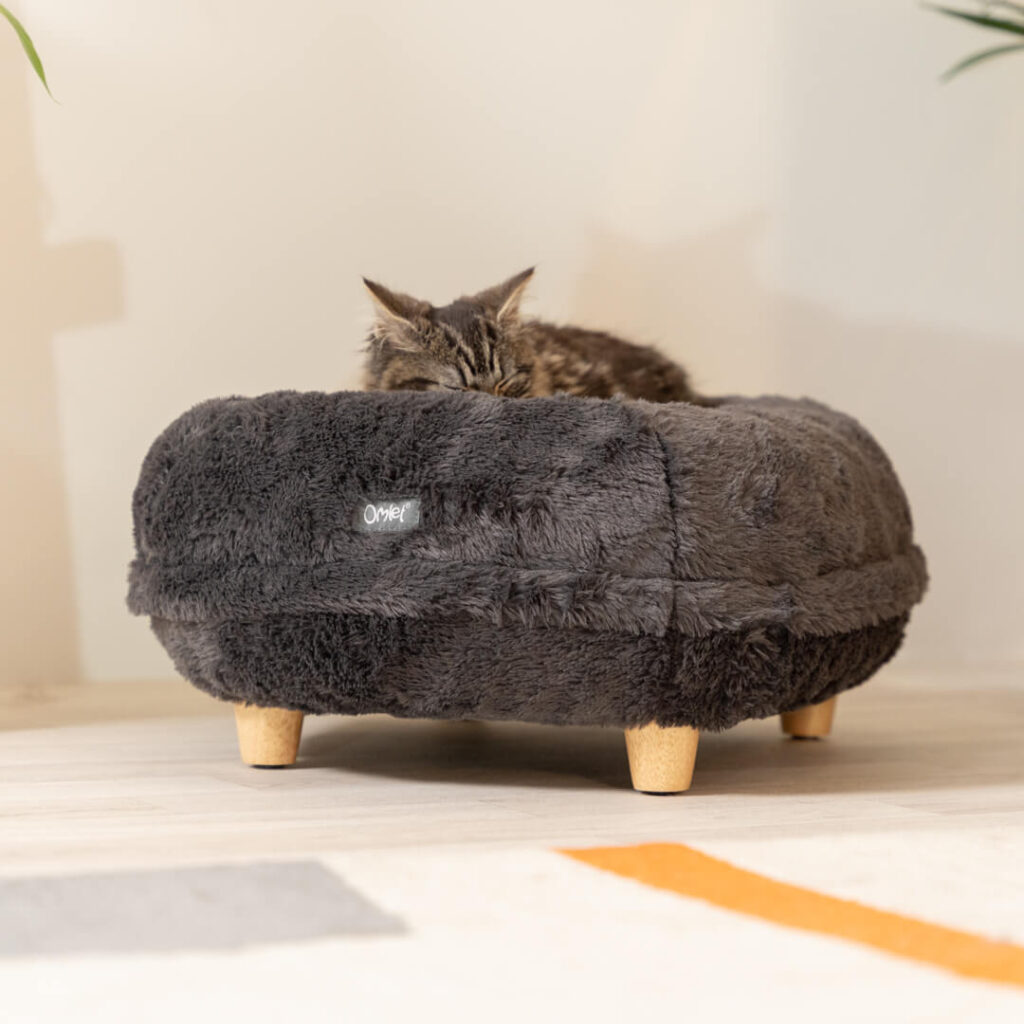 How and when to give your cat space
How and when to give your cat space
Giving your cat privacy extends beyond the litter box. Cats can also feel vulnerable and exposed when trying to sleep in a busy house and particularly anxious cats will search for a quieter spot in the home.
Consider where your cat chooses to rest during the day when the house is busy and make that space comfortable for them, for example, if your cat prefers to nap under a bed or chair, place a blanket or small bed, like a Donut Bed, beneath to make the spot cozy and warm.
If you have children and dogs in the home, it’s a good idea to keep them from your cat’s ‘safe space’ when your cat is resting or grooming.
Also consider where you have placed your cat’s food and water bowls. It may also be advisable to leave the room, or move them to somewhere quieter, where your cat can eat in peace without feeling threatened.
What’s the best litter box for a senior, disabled or pregnant cat?
While tall Jump In boxes will give cats peace and privacy, less agile cats will feel most comfortable with an easy access litter box that won’t cause them pain or discomfort. The Maya Walk In Litter Box offers just that, while still being a relatively covered and discreet litter box for cats who want to feel secluded and safe.
7 Reasons You and Your Cat Will Love the Maya Litter Boxes
1. Easy to clean cat litter box solutions, reducing smell and mess
2. A range of entry point options and litter box styles to suit all cats
3. Designed to fit seamlessly into your home like a piece of furniture
4. Enclosed litter box to give your cat the privacy they desire
5. Durable, reusable and long-lasting litter liners are easy to wipe clean
6. Includes a complimentary Omlet folding scoop in discrete pocket
7. Push-to-open door prevents accidental opening
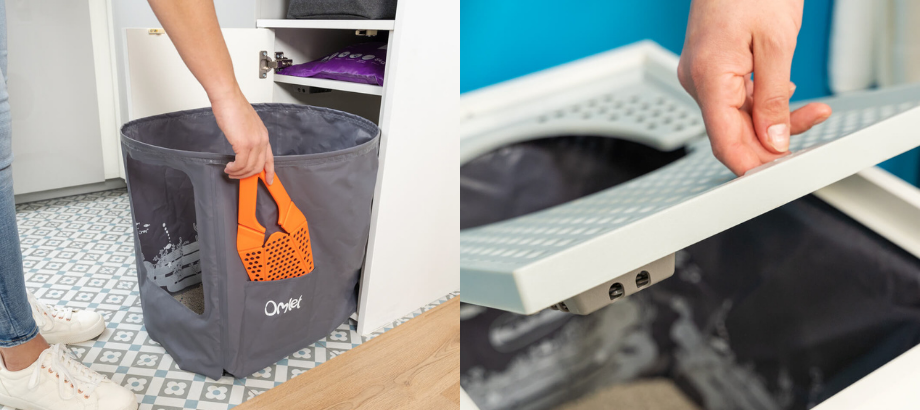
Which litter box should I choose for my cat?
All the Maya Cat Litter Boxes offer an easy clean solution and effective odor and mess control, in a discreet, seamless unit. Find the right box for you and your cat from the range of 5 entry points…
Jump On – Anti-Tracking & Low Mess
Walk In – Senior & Disabled Cat Friendly
Walk In + – Senior Cat Friendly with Storage
Jump In – Anti-Tracking & Discreet
Jump In + – Anti-Tracking with Storage
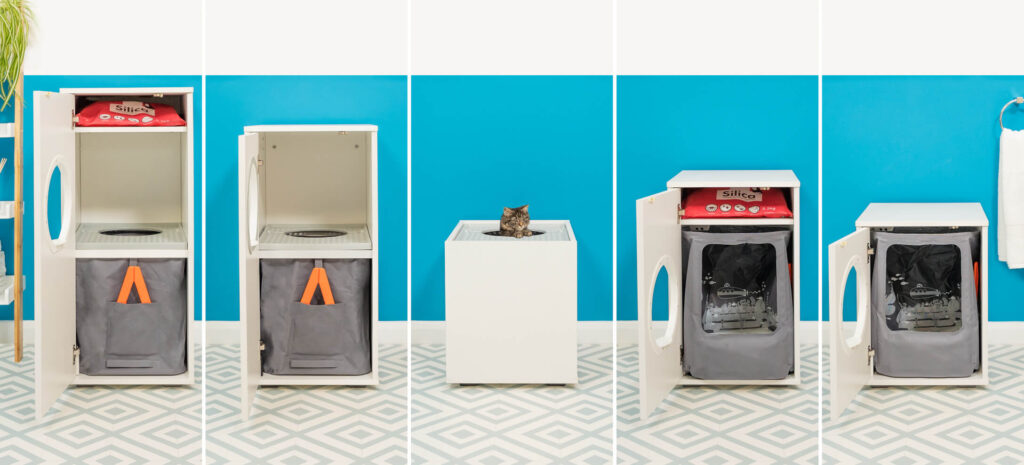
From left to right: Jump In with Storage, Jump In, Jump On, Walk In with Storage, Walk In
Discover Omlet Cat Litter
Our modern range of high-performance cat litter offers excellent odor control and highly absorbent particles to eliminate bad smells from your litter tray. With 5 different types of cat litter on an easy to compare page you’ll find the perfect litter for you and your cat.
Use our clever Cat Litter Selector to get an expert recommendation for your cat. We only sell direct, with competitive pricing and free delivery.
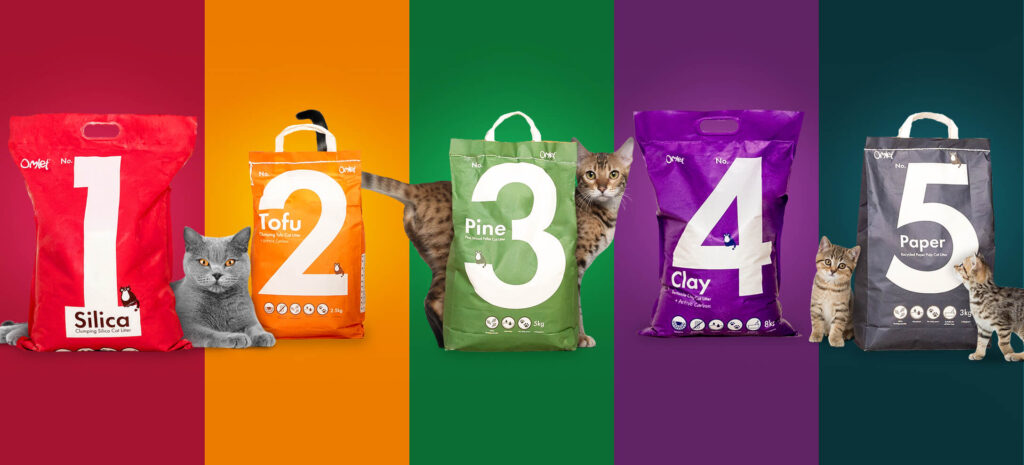
This entry was posted in Cats
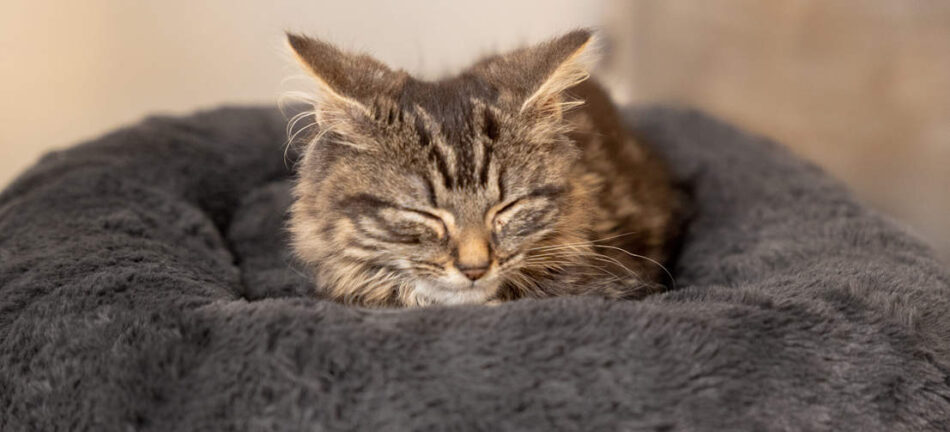
Have you ever taken a look at your cat’s whiskers and wondered why they’re there? Or why one cat’s whiskers are shorter than another’s? Read on to find out 10 things you might not know about cat whiskers.
1. Your cat’s whiskers can tell you how they’re feeling
Did you know that your cat’s whiskers can give you an insight into their emotions? A happy cat’s whiskers will be relaxed and slightly to the side, whereas a cat on high alert or hunting prey will have fanned out whiskers that are pulled forward. A fearful or shy cat, on the other hand, will try to make their face look smaller by pulling their whiskers back.
2. Cats are born with 24 whiskers
Cats are born with around a total of 24 mystacial whiskers – that’s 12 on each side of their face. This number will stay the same for the rest of a cat’s life!
3. Whiskers are connected to a cat’s nervous system
Whiskers are also called vibrissae, which means to vibrate. And because a cat’s whiskers are connected to their nervous and muscular system, this makes them highly sensitive. Therefore, when brushed against something, causing a vibration, whiskers will send signals to your cat’s brain to help them to navigate the world.
4. The world record for the longest cat whiskers is 7.5 inches!
In 2005, Missi the Maine Coon from Finland achieved the world record for the longest cat whiskers at 7.5 inches long! To put this into context, the average cat whisker only measures at around 3 inches. However, generally speaking, longer haired cat breeds do tend to have longer whiskers.
5. Whiskers can make cats better hunters
Whiskers can help a cat when it comes to hunting their prey. Initially, a cat’s whiskers will determine whether they will be able to squeeze into an enclosed space to make their catch. Their whiskers will then help them to identify the shape of their prey, allowing them to bite in the perfect spot.
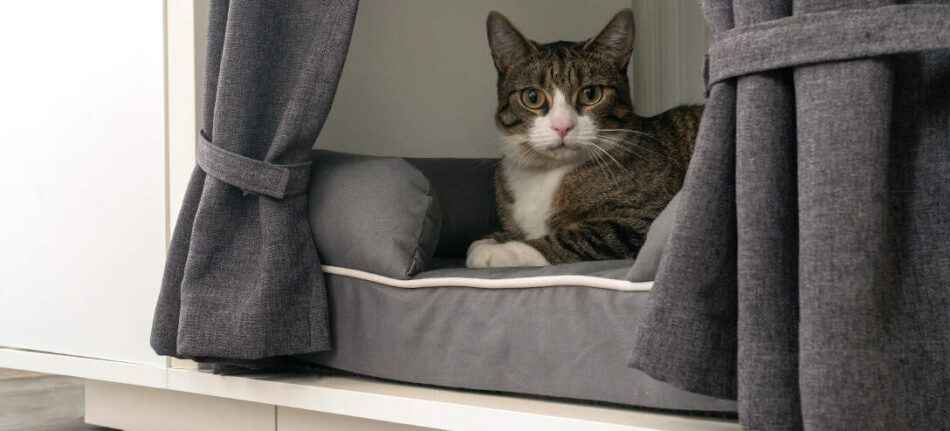
6. Whiskers help protect cats’ eyes
Just like our eyelashes, a cat’s whiskers also have the purpose of helping protect their eyes from dust and debris.
7. Cats have whiskers on the back of their legs
Whiskers aren’t just found on a cat’s face! Cats also have whiskers on the back of their front legs. These are known as carpal whiskers. Although they may appear to look like fur, carpal whiskers help with spatial awareness and hunting.
8. Sometimes mother cats chew off their kitten’s whiskers
If you’ve ever had kittens, you might have noticed a kitten’s whiskers being chewed off by their mother or even their littermates. Most commonly, cats do this either out of habit, as a sign of stress, boredom, or excessive grooming. To prevent unwanted behaviors, cats should be provided with a range of boredom busting cat toys to keep them both mentally and physically stimulated.
9. Cats shed their whiskers
You’ll no doubt have found your cat’s fur lying around the home, but what about their whiskers? Cats usually shed between 1 and 3 whiskers a year, which is nothing to be concerned about. However, if you notice excessive whisker shedding, this could indicate what’s likely a skin or stress issue, so should be looked at by your vet.
10. Your cat’s whiskers can change color!
As your kitty ages, you’ll probably notice their whiskers changing, or losing, color along with the rest of their coat. Depending on their breed, their whiskers will usually turn grey or black.
If you enjoyed finding out 10 things you might not know about cat whiskers, find out some more fascinating facts on cat’s whiskers and their senses in our previous blog The Seven Fascinating Senses of Cats.
This entry was posted in Cats
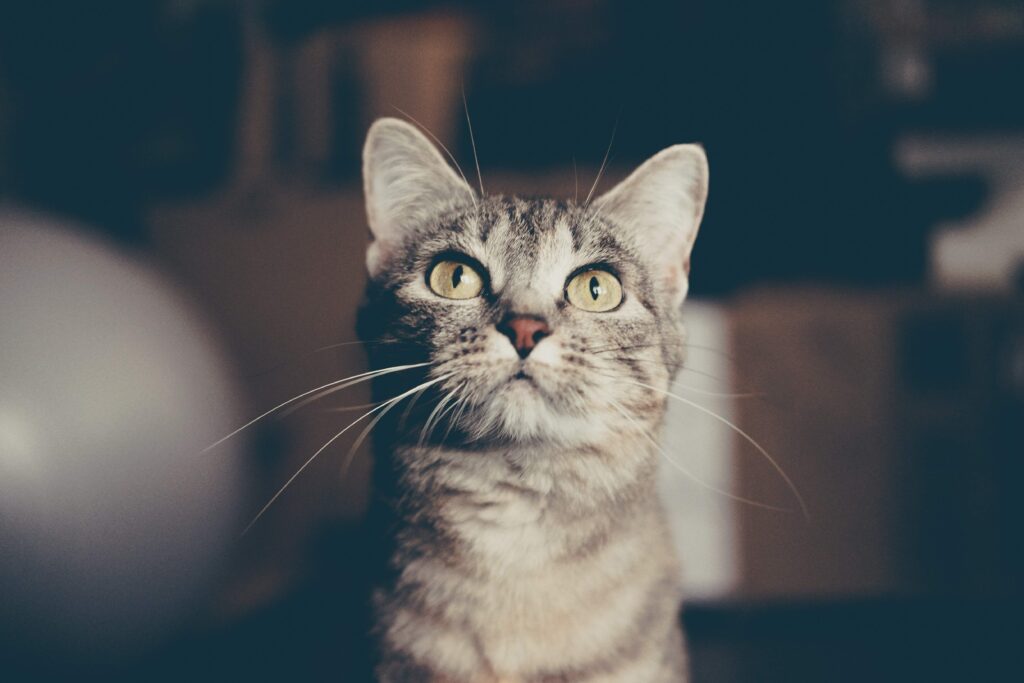
Photo by Erica Leong on Unsplash
As indoor cats frequently use their litter boxes, it is important for cat owners to take the right measures to keep litter box odors under control. Stinky cat litters, however, can be more than just an unpleasant aroma in the air around our homes. More worryingly, the smells coming from your cat’s litter box can actually be having an impact on yours and your cat’s health. However, with a few helpful tips on good litter box hygiene, you can be on your way to keeping pungent cat litter smells at bay, all while creating a healthier environment for both you and your cats.
What Causes a Stinky Litter Box?
A rancid smell from a litter box can often derive from a lack of, or poor, cleaning. Although you may be cleaning your cat litter box, if not done effectively, you may simply be masking the smell, as opposed to eliminating it.
Before anything else though, make sure that your cat is not spraying outside of their litter box, which can be one reason as to why there is an odor circulating your home. Your cat spraying outside of the litter box can be happening for a number of reasons such as boredom, territorial marking, and sickness. If you do, however, notice that your cat is simply refusing to use their litter box, the chances are, this is due to an issue surrounding the litter box itself. Some suggestions include
the litter box being dirty, (we wouldn’t like to use a dirty bathroom so why would our cats?); your cat disliking the litter you are using, based on either smell or texture (remember, cats have preferences too!); or the location of the litter box not being well suited to your cat/s.
A litter box should be placed in a quiet environment, away from the heart of the home or any outside traffic, to ensure peace and quiet. The litter box should also be separate from where your cat eats, have sufficient lighting, and within a room your cat likes or is comfortable in. The Maya Cat Litter Boxes are a great solution for cats who need complete privacy and comfort. With five different styles and entry points, your furry friend is bound to find a way to suit them.
However, if you do decide that it would benefit your cat to move their litter box to a more suitable location, which will in turn hopefully
help with the odor of the house, be mindful that cats are creatures of habit, so disturbing their space must be done with caution. Take it step by step with the litter box transition by purchasing a second box to place in the new location, while keeping the old box in its remaining place. After around a week, if your cat is using their second litter box, then feel free to remove the original, as this is a sure sign, they have comfortably made the transition. Another pro tip is to continue to use the same litter as you had before, which will make sure you’re not putting your cat under any more additional stress than need be when you replace their litter box.
Once you have ruled out that the smell is not from your cat spraying outside of their box, but in fact the odor is coming from what is going on inside of the litter box, you can begin to follow the appropriate steps to eliminate the stench and have your house smelling fresh again.
How to Control the Odor
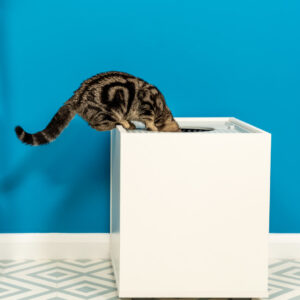 Regularly Wash the Box
Regularly Wash the Box
Although it may sound obvious, regularly cleaning the litter box is the starting point to waving goodbye to nasty odors. How often you give your litter box a deep clean really does depend on how often your cat is using the litter box along with other lifestyle factors such as age, diet and exercise coming into play. If you are starting to notice litter box odors becoming stronger with your current cleaning regime, up the frequency of cleaning and start giving the litter box a good scrub once a week. To wash your cat’s litter box, first remove and dispose of any litter, before beginning to scrub the box using warm water mixed with a mild dish detergent. Once cleaned, thoroughly pat dry with a towel. If you’re after an even easier cleaning solution for your litter box, have a look at litter liners, which prevent dirt from sticking to your box. The Maya Litter Box comes with a waterproof and long-lasting liner, making it simple for you to effortlessly wipe your box clean.
Keep On Top of Scooping Out the Litter Box
Scoop out your cat’s litter at least twice a day. It may initially seem a bit of an ordeal, but your cat really does prefer plenty of clean and dry space in their litter box to continue using it comfortably. Furthermore, frequently scooping the litter box means a lot less time for litter box smells to accumulate. It’s also important to replace the scoop itself, along with the litter box annually. This is because over time, the plastic scoop reacts with the acid in your cat’s urine, eventually causing the plastic to degrade and then smell.
Use a Clumping Litter
Clumping litter works by forming clumps when the litter gets wet, or your cat’s urine is detected. A great thing about this type of litter is that it makes it easier to scoop out all of your cat’s waste, before it has time to build up and cause an odor. If you’re on the search for a good clumping litter, clay clumping litter is a popular option, due to its absorbent properties. As clumping litter dries out cat feces, its absorbability makes it fantastic for preventing your cat’s waste from reaching the bottom of the litter box, which makes things a lot more difficult when it comes to cleaning.
Add Another Litter Box
If you’re lucky enough to have more than just the one cat, we’re sure you’re more than aware of how bad litter box odors can get! We all know how bad the smell can become from one cat’s waste, let another one, two, or three…! Purchasing another litter box, however, will definitely help you to fight nasty odors. Adding another litter box will help to control the litter box smell, as the rate at which cat waste piles up will significantly reduce. The general rule of thumb is to use one litter box per cat in the household.
Try a Cat Litter Deodorizer
A cat litter deodorizer should not be used to replace correct hygiene, however they’re a fantastic way to get your cat litter smelling wonderfully clean and fresh, once all other cleaning is complete. Deodorizers can come either as granules, beads, sprays, or in powder form, with a range of different scents on the market. Alternatively, you can use a scented litter, which also comes in a number of fragrances. However, just be mindful that some cats are more sensitive to new smells than others so may not take to scented deodorizers or litters. As another option, you can go for an unscented deodorizer, which works by neutralizing odors. These will be best for cats that are more prone to irritation from strong scents.
Charcoal Cat Litter
Just like clay, charcoal, or activated carbon, is highly absorbent, making it perfect for getting rid of nasty odors. To incorporate charcoal/carbon into your routine, you can either opt for a bag of cat litter with activated charcoal or carbon or purchase a cat litter deodorizer that contains it. The Maya Cat Litter Box comes ready with an activated carbon filter, that will prevent odors from escaping the box.
Use Baking Soda
If you decide that a cat litter deodorizer isn’t right for either you or your cats, using a little baking soda is another sure way to help with the odors coming from your cat litter box, although it may sound like an unlikely fix. Not only is baking soda a completely natural, safe, and pet friendly option for your cats, but it can also be used on any type of cat litter, working by absorbing your cat’s urine. A little baking soda goes a long way, so you will only need a couple of teaspoons, even for a large cat’s litter.
Dangers of a Dirty Litter Box
Dangers of a Smelly Litter Box to Humans
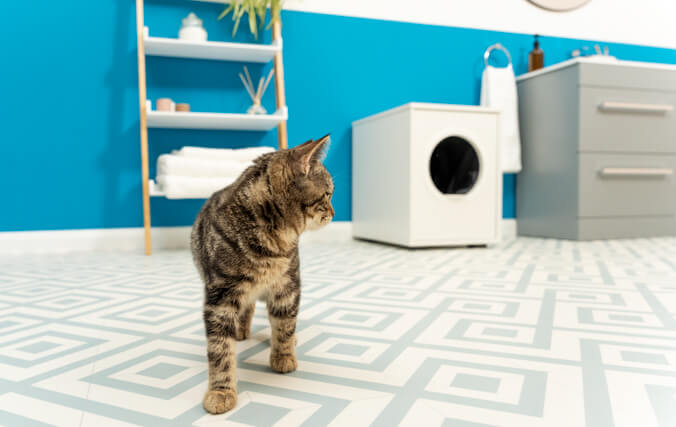 Ammonia is the most likely culprit for litter box odors, found in approximately 0.5 percent of your cat’s urine. As the litter box continues to accumulate waste within a room in your house that may not necessarily be well ventilated, the harmful gas of ammonia is formed. Overexposure to ammonia can result in queasiness and headaches, but should it become more serious, it can further lead to pneumonia. For those with a compromised immune system or are pregnant, overexposure to ammonia can be the onset of toxoplasmosis, an infection by the parasite toxoplasma gondii, which can become life threatening.
Ammonia is the most likely culprit for litter box odors, found in approximately 0.5 percent of your cat’s urine. As the litter box continues to accumulate waste within a room in your house that may not necessarily be well ventilated, the harmful gas of ammonia is formed. Overexposure to ammonia can result in queasiness and headaches, but should it become more serious, it can further lead to pneumonia. For those with a compromised immune system or are pregnant, overexposure to ammonia can be the onset of toxoplasmosis, an infection by the parasite toxoplasma gondii, which can become life threatening.
Cat scratch fever, or cat scratch disease, is a bacterial infection from Bartonella henselae bacteria, associated with cat feces. Although very rare, the disease can again cause dangerous symptoms such as fatigue, swollen glands and fever.
Dangers of a Smelly Litter Box to Cats
Cats really are clean animals, which means that many will only use a clean litter box, often resulting in cats doing all they can to avoid using a dirty one, even if it means uncomfortably holding in their urine. However, delaying using the bathroom is not a great idea for cats as it can cause urinary tract diseases such as bladder inflammation and kidney blockage, or failure. Although all of which can be treated by your vet, prevention is always better than the cure.
Cats can also unfortunately fall victim to cat scratch fever. Their symptoms are similar to those that we can suffer, with swollen glands, fatigue, and a lack of appetite being the most common.
Having a cat should not mean having to compromise on the smell of your home. Although the unpleasant odor from a litter box can be overwhelming at times, it doesn’t have to remain that way. Hopefully with a bit of advice, you can now be one step closer to saying goodbye to cat litter odors for good.
This entry was posted in Cats
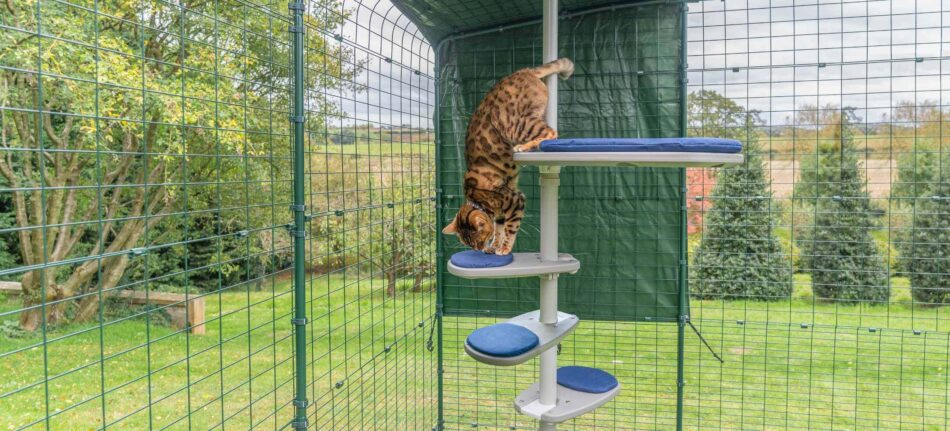
When it comes to wildlife in the backyard, is your cat as ruthless as a raging lion or timid as a mouse? We might want to believe that our feline friend wouldn’t hurt a fly, but as descendants of their larger feline members of the family, cats are natural predators, whether we like it or not. But do all cats need or want to kill, and can you stop them from hunting? Sadly, the answer is no, despite spoiling them rotten or pampering their every need. Given the opportunity to go out and hunt, most cats will take it, purely because they have the animalistic instinct. So how can you make your cat’s interaction with wildlife in the backyard safer?
Hunter or hunted?
Even the most cuddly and affectionate cats can resort to their hunting instincts, but they’re not always the predator…
Allowing your cat to roam freely in the great outdoors isn’t always the safest and because they’re solitary creatures, they will hunt alone. This makes them more vulnerable to attacks from larger predators such as dogs, foxes, mink, and raccoons, as well as getting into fights with other cats and more human threats like cars, poisoning or thieves.
As a predator, our cats can impose a huge threat to our wildlife and nature’s neighbors. Your kitty is capable of killing wild animals such as birds, reptiles, and small mammals and while they don’t always bring the kill home, there is every chance they’ve already been consumed.
Hunting and hunger
Hunting is not solely motivated by hunger but the way you feed your cat will certainly make a difference to how they hunt. Cats are opportunistic hunters and know that if they were to hunt only when hungry, they could risk starvation, purely because capturing prey isn’t always successful and isn’t always available. Today, cats have evolved to change their daily patterns depending on the food that is available to them.
Ultimately, whether they’re hungry or not, hunting is an instinctual behavior. The average well-fed pet cat partakes in approximately 3 hours of hunting each day, whereas a cat that is fed less will hunt more, so it’s important to feed your cat at regular intervals throughout the day to mimic their natural feeding patterns. They’ll also benefit from a meal rich in meat content.
Cat safety
To avoid the hunting impact that your cat has on the local wildlife and protect them from predators and human dangers, we designed the Omlet Catio. Finally, cats can play safely in the fresh air! The Omlet Catio can be extended and adapted at any time to suit your cat and space and if you don’t have a large backyard, no problem. Introducing the Catio Balcony Enclosure – perfect for apartment balconies. Now, cats get all the stimulation they need while both they and the wildlife in your backyard stay safe.
If your cat does spend a lot of time outdoors and you’re concerned about wildlife and your cat’s hunting habits, there are a few things that can help.
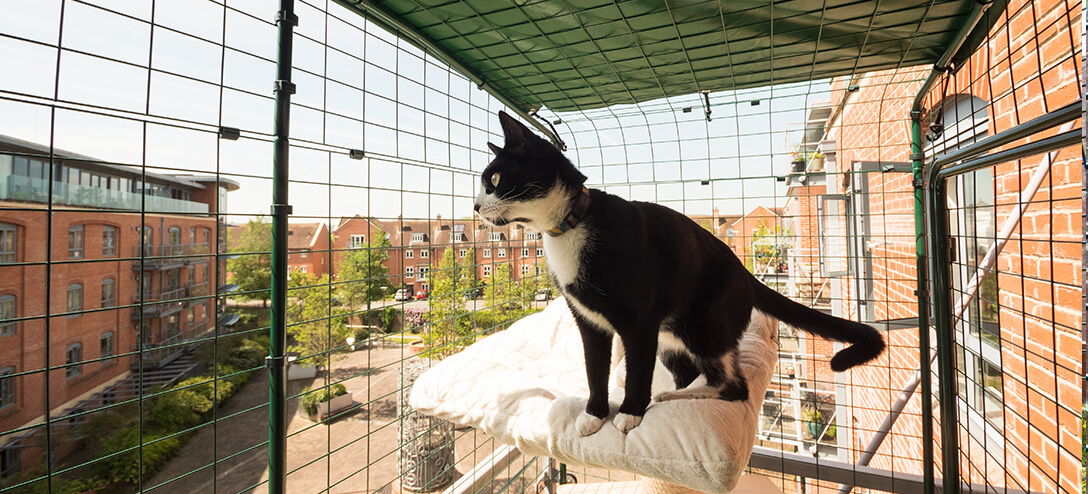
More time to play
Similar to their food patterns, the way cats play can affect how they behave in the wild. Regularly play with your cat and offer them cat toys that resemble prey. We’ve all seen the way cats crouch down ready to pounce on a scrunched-up ball of newspaper. If your cat doesn’t go out and is purely an indoor cat, don’t worry, you are not depriving them of their ancestral hunting heritage. Hunting doesn’t necessarily mean killing prey, which is why it can be adapted to play.
You can also introduce a cat scratching post for some extra brain stimulation. The Omlet Stak cat scratching post is perfect for cats plus the environment, made with durable cardboard that can withstand endless scratching sessions. Entertain your cat’s curious mind and hunter instinct rather than try and diminish it.
When not to hunt
Try to avoid dawn and dusk, prime hunting times. However, remember that changing a cat’s routine needs to be done slowly to ensure it’s not having a negative impact on the cat.
Cats need variety
Cats are neophiliac, which means they absolutely love variety – especially when it comes to food. Regularly providing different foods may curb their hunting behavior as they don’t need to look elsewhere for new tasty treats.
Sound the alarm
Adding a bell to the collar is certainly one way to alert prey that danger is coming, however, cats are incredibly intelligent. Just be mindful that while this may seem to work to start with, your cat might find a way to master this new skill of getting close without making a noise.
Omlet and your cat’s hunting
Omlet can’t stop your cat’s hunting but with products like the super secure Catio and Stak cat scratcher to keep them entertained for hours, your feline friend’s habit can be much safer for both them and wildlife.
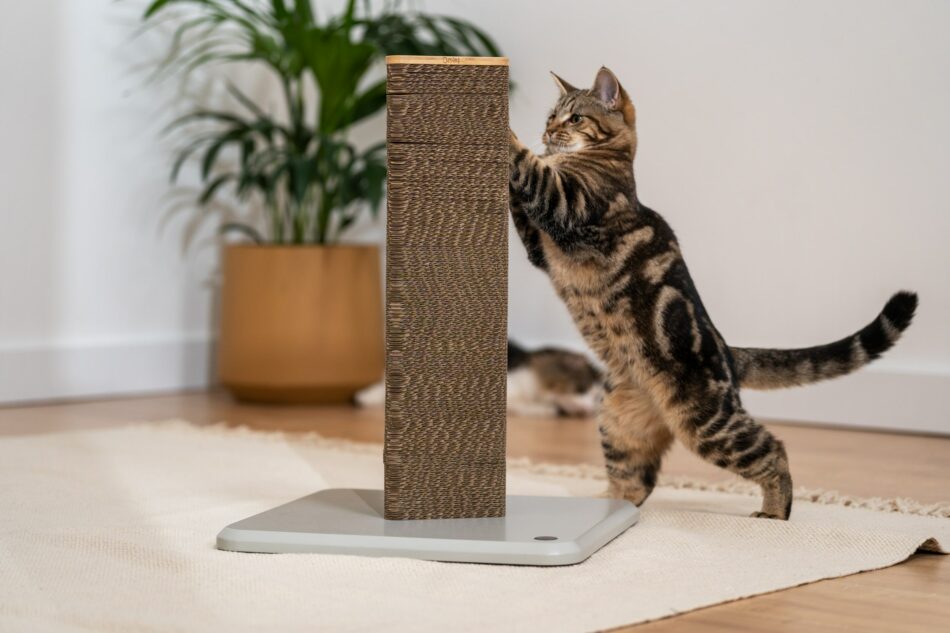

This entry was posted in Cats

Spring is the ideal time for a fresh start! Whether that means having one big clear out, starting a new project, or getting organized, it presents the perfect opportunity to have a bit of a change! So why not get your cat or dog involved with your spring overhaul so that they can start the new season in tip-top condition! So, how do you begin a spring clean of your cat or dog’s life?
Remove Pet Hair from Around the Home
Before making a start to your cat or dog’s own spring clean, grab the supplies and get to work on removing any pet hair or dirt from around the home. Many pet parents will agree that getting rid of animal hair from around the house seems to be an impossible task, especially if you’ve got a cat or dog that sheds a lot.
However, there’s no need for harsh chemicals when cleaning the house with pets. For your carpets, a top tip is to sprinkle down some baking soda before vacuuming. Not only will this help to remove hair, but the baking soda will minimize odors. Just be sure to use a vacuum that has been specifically designed for dog and cat hair to make things a bit easier!
When it comes to cleaning fabric sofas, you can simply use a dry sponge, and this will pick up any cat or dog hair lying around. For more household cleaning tips with pets, you can read our previous blog Cleaning Tips For Dogs Who Love Mud!
Using a pet blanket on top of beds and sofas, however, is the best way to keep your furniture protected in the first place, as well as providing your pet with a cozy spot to relax.
Clean Your Pets’ Beds
Now that the household spring clean is complete, it’s time to focus on your pet, and a great place to begin is by cleaning their bed. We wouldn’t like to sleep on a dirty mattress, so neither would our pets. And with dogs sleeping between 13 and 14 hours a day, and cats between 12 and 16, it’s fundamental to provide them with a clean, secure, and safe place to rest. Fortunately, all Omlet beds are conveniently easy to clean, with removable covers and toppers that are machine washable.
Alternatively, treat your cat or dog to a new bed this spring. For cats, the Maya Donut Bed comes in a wide range of colors that can add a touch of spring freshness to your home for the season. The Topology bed is perfect for dogs, with the option of raised feet, which improve home hygiene and airflow.
Give Your Cat or Dog a Groom
Spring cleaning wouldn’t be complete without a bit of a pet makeover! Well, not necessarily a full head to paw transformation, but a good bath and brush go a long way! Depending on the breed of your dog or cat, they might need to make a visit to the groomers, but it’s a good idea to keep on top of a basic regime at home. Furthermore, grooming is not only for your dog or cat’s appearance but is also important for your pet’s health by aiding with keeping their skin healthy and preventing fleas or ticks for example.
Treat Your Pet to Some New Toys and Outdoor Entertainment
Spring means some warmer weather is on the way, so both pet owners and our furry friends will be spending much more time outside. A few new toys will be greatly appreciated by your cat or dog, as they adjust to the new season after spending a lot of winter cozied up indoors. Or how about treating your cat to their very own outdoor cat run, which is perfect for indoor and outdoor cats alike, who love adventuring but need to remain safe in the garden.
Prepare for the Heat
Before we know it, summer will be here, so why not get prepared as early as possible by giving your pets the best chance of staying protected from the heat. Something to invest in during spring is a cooling mat for your dog. The Omlet Memory Foam Cooling Mat has a non-toxic self-cooling gel inside, meaning that the mat doesn’t require any refrigerating. You can place your pup’s mat either on a flat surface or on their bed and they’ll stay nice and cool for up to three hours – the perfect summer accessory!
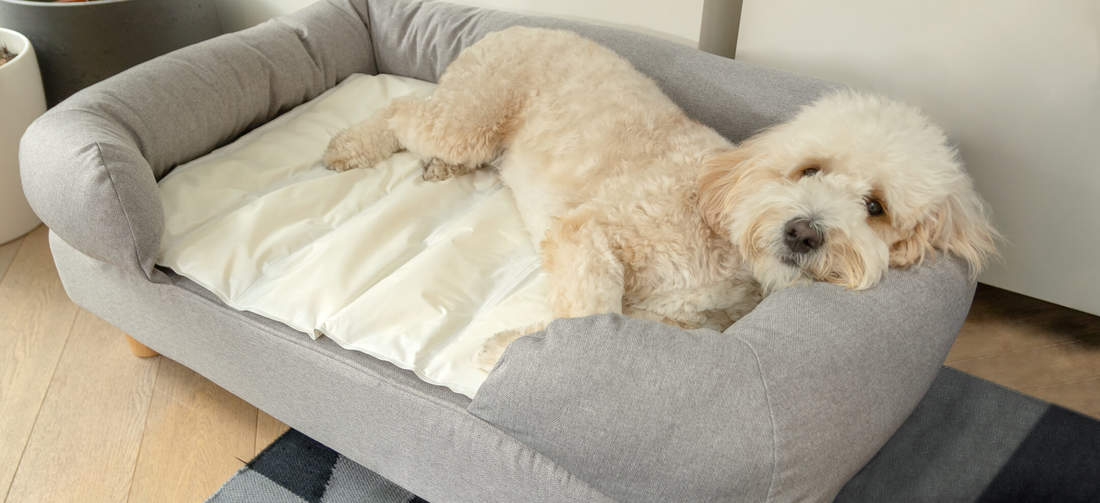
The Omlet Cooling Mat is super easy to clean, with a quick wipe down!
Spring is just around the corner, so there’s nothing stopping you from beginning your tidy up from today! Before you start cleaning your home, however, it goes without saying that any cleaning products you use in your house should be pet-safe, so always make sure to check the labels. How will you be spring cleaning your cat or dog’s life?
This entry was posted in Cats
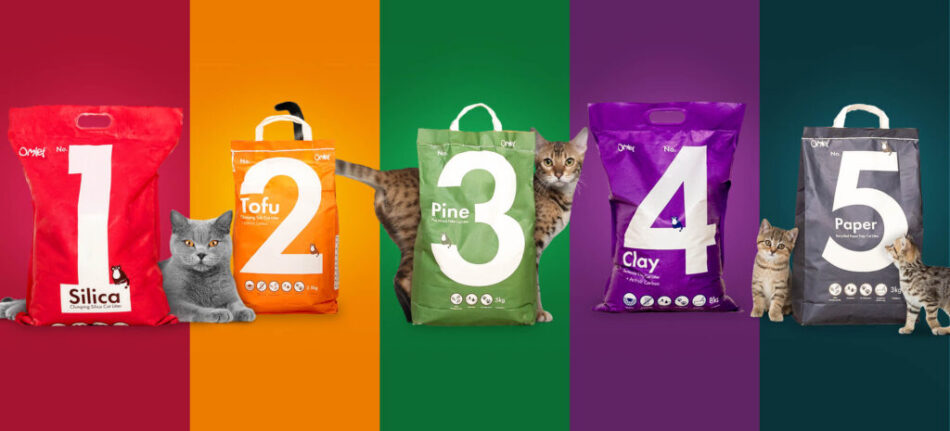
Choosing the right litter for your cat is an important decision but with so many different types of cat litter out there, it can sometimes be overwhelming to know which to go for! Cats can be very fussy animals, even when it comes to their litter boxes, so when choosing which litter to invest in, you’ll need to take both you and your furry friend into consideration. Clay and pine cat litters are popular choices – but which is best for you and your pet cat?
What is Clay Cat Litter?
Clay cat litter was one of the earliest cat litters to be used. Traditional clay litter is formed when clay is crushed, dried in a kiln, and then crushed again to form the litter as we know it to look. To make a clumping clay cat litter, bentonite clay is added to the mix, which absorbs liquid, or your cat’s urine, once it has been detected.
What is Pine Cat Litter?
Pine cat litter on the other hand is made from either wood pulp, or recycled pine shavings, that are then shaped into pellets. This type of litter has a natural wood aroma and can either come as a clumping litter or in non-clumping form.
Now that we have established what the main difference is between these two types of litter, we can start to consider what other factors need to come into play when you decide on either clay or pine.
Scent and Odor Control
A lot of clay litters are artificially scented, so if you want more of a natural smell, a pine litter is probably best for you. Furthermore, some cats can be easily irritated by the artificial scents that a lot of clay cat litters have, which can sometimes simply be masking odors, making it near impossible to get rid of litter box odors entirely. If you and your cat prefer a more freshly chopped wood scent, then you’ll love the Omlet Cat Litter No. 3 – Pine, that naturally helps to reduce litter box odors such as ammonia thanks to its absorbent properties. However, if a clay litter is more to your taste but your cat is prone to irritation, unscented clay cat litter is also available. This might be a better option for your cat if you notice a scented clay litter resulting in allergies or your cat refusing to use their box.
Texture
Of course, every cat is different, but particularly fussy cats will likely prefer a fine-grained litter texture. Clay has this advantage over pine, which some cats do not get along with, as the granules are slightly larger than the sand-like texture that clay offers. In the outdoors, cats like to bury their waste in sand so the closer their litter can replicate this, the better.
Clumping
Many clay litters are clumping, which means that they form clumps when coming into contact with liquid. This is because of the type of clay that is added to the formula (bentonite). Clumping clay litter, as opposed to a clay non-clumping litter, is what you’re most likely to find on the market as it makes for a much easier cleaning process of the litter box. Although pine is highly absorbent, it simply does not clump quite as well as clay does.
Dust
Dust can become a real issue with some cat litters. When litters are handled or in transit, it almost becomes inevitable that the pellets will rub together which then forms a dust. Many cat owners notice this dust when pouring the litter into their cat’s litter box. Although it may seem harmless, litter dust can in fact become harmful for both humans and cats, causing respiratory problems in the long run. Pine litters are generally better than clay when it comes to producing the least dust. They are a low dust cat litter option, which also means a better choice for cats with allergies or sensitivities.
Environmental Impact
If a more environmentally friendly option is what you’re on the lookout for, then a pine litter will be a much better choice for you. Being a natural litter made up of wood pulp, pine is a renewable and biodegradable material. Alternatively, Omlet’s Cat Litter No. 4 – Clay offers a low waste clay litter solution that is less taxing on the planet than traditional non clumping clay cat litter, which can often create more waste, as cat owners can unknowingly end up frequently disposing of fresh litter. Omlet’s clumping clay cat litter means less waste for you, as clumps appear once the litter box has been used by your cat, making it super easy to scoop.
Other Litters to Consider
Pine and clay cat litters are just two of the many litter options out there. Omlet stock a range of different types of cat litter that might be a better fit for you and your cats.
If dust is becoming a problem with your current litter, how about switching to Omlet’s Cat Litter No. 5 – Paper. As previously mentioned, many types of cat litter produce at least some amount of dust. However, the Omlet paper cat litter is virtually dust free, with the biodegradable pellets being made from recycled newspaper.
Natural litters such as grass are growing in popularity. Grass cat litters are a newer product on the market and are made using grass seeds. This litter is extremely lightweight, offers good odor control, and is also scent free.
Omlet’s Cat Litter No. 2 – Tofu may be one that you’ve not heard of just yet, but with highly absorbent properties and being more of an eco-friendly candidate, it might just be the right litter for you and your furry friend. Made from 100% crushed tofu, tofu cat litter stays fresher for longer with its active carbon composition.
Silica gel litter, also known as crystal litter, is a silica-based cat litter. Made from silica crystals, it has the amazing ability to absorb a large amount of liquid. Another newer cat litter that has become available, dust from silica gel litter is also practically non-existent. Take a look at Omlet’s Cat Litter No. 1 – Silica.
After reading how clay and pine cat litters differ and learning a bit more about what else is available, hopefully you’ll now be one step closer to making your final decision on which one is the perfect match for your pet!
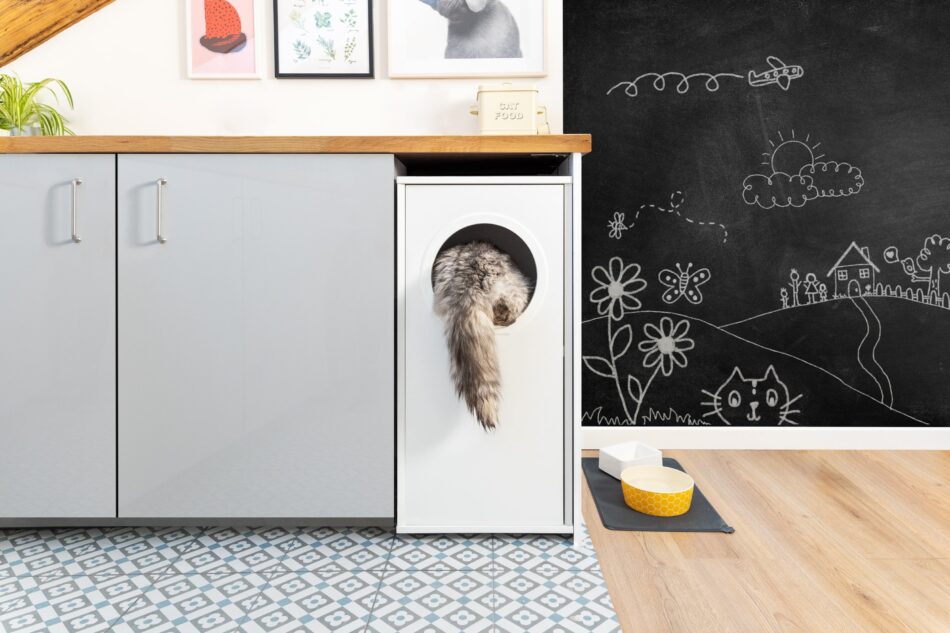
This entry was posted in Cats
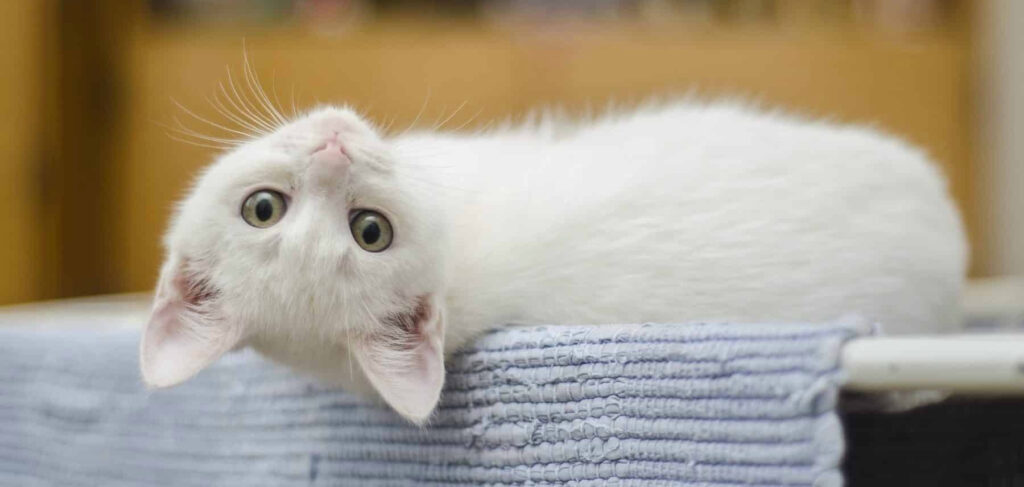
With the increasing awareness of how the environment is being affected by humans, it is understandable that many pet owners are attempting to make more environmentally friendly decisions within their home.
Some litter can be composted, and some can’t. If you are determined to compost it, the starting point is to ensure that your litter is made from natural, biodegradable materials.
The origins of cat litter
Cat litter, which was first invented in the mid-century, has always been viewed as unusable waste that needs to be thrown away after use. The inventor was American businessman Edward Lowe, who began using Fuller’s Earth – an absorbent clay-based mixture – rather than the ashes, soil or sand. He patented his product under the name Kitty Litter in 1947.
Many types of modern cat litter contain silica, which, although not harmful to cats, takes a long time to degrade after it’s been thrown away and can’t be composted at home. Some litters are marketed as ‘flushable’, but evidence suggests this can cause environmental damage. It’s made from ingredients such as corn, wood, pine or wheat, which means its biodegradable. However, the flushed litter can potentially spread toxoplasmosis, which can affect humans as well as other animals. Most water treatment plants are not equipped to remove the tiny organism. A healthy immune system can fight off the bacteria and the disease it causes – toxoplasmosis – but the ailment is life-threatening to people who are already unwell.
To add to the problem, flushable litters can block toilet pipes. If you use a septic tank system, the hardened poo and litter waste will not easily break down. If you opt for this type of product, it is actually best to bin it in compostable bags. Any litter that is not soiled can, in theory, be composted on the compost heap.
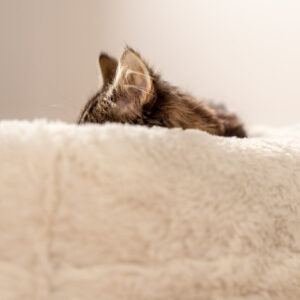 Choosing the best litter for your cat
Choosing the best litter for your cat
So, what do cats think about all this?
No two cats are the same, and some seem to be very fussy about their litter. Every cat has its own individual needs, quirks and preferences – for example, sometimes a cat won’t share its litter tray with another cat or will turn its nose up if the tray doesn’t contain their favorite type of litter.
Choosing a litter that your cat is comfortable with while remaining environmentally friendly can be tricky. Omlet eases this dilemma by offering four different types of biodegradable cat litter.
Omlet Cat Litter No. 2 is made from tofu and is one of the most environmentally friendly cat litters available. As well as being great for the environment, it’s also great for your home, as this litter is long-lasting and absorbs smells faster and more efficiently.
Omlet Cat Litter No. 4 is clay-based and is incredibly easy to clean up as it clumps together when wet, giving you an easier clean each time. The clay mix is not compostable, but it will not damage the environment when you dispose of it.
If your cat is only happy using a silica-based litter, it might be a good idea to head to your nearest waste disposal center to dispose of it. They may have a more environmentally friendly option available than adding it to the general waste.
How to compost cat litter
Composting cat litter is like any other composting. The key thing is to get an appropriate bin. Follow these five points, and you won’t go far wrong:
- Keep the compost pile away from any vegetable beds or other food-growing areas.
- Ensure the bin is large enough to enable the compost to be turned regularly – a container of at least one cubic meter will be sufficient.
- Only litter that is 100% plant-based can be disposed of in this way. Clay litter or litter with added chemical deodorants cannot be composted.
- Add composter liquids, vegetable and plant matter and grass clippings to the compost. Chicken or horse manure will help the composting process, too.
- Leave the compost for two years before using it in the backyard or garden, and only use it for plants, not food items.
Disposing of the clumps of cat poo (down the loo or in the general waste bin) before composting is highly recommended. The droppings contain bacteria that could cause illness if it contaminates food.
Happy composting!
This entry was posted in Cats
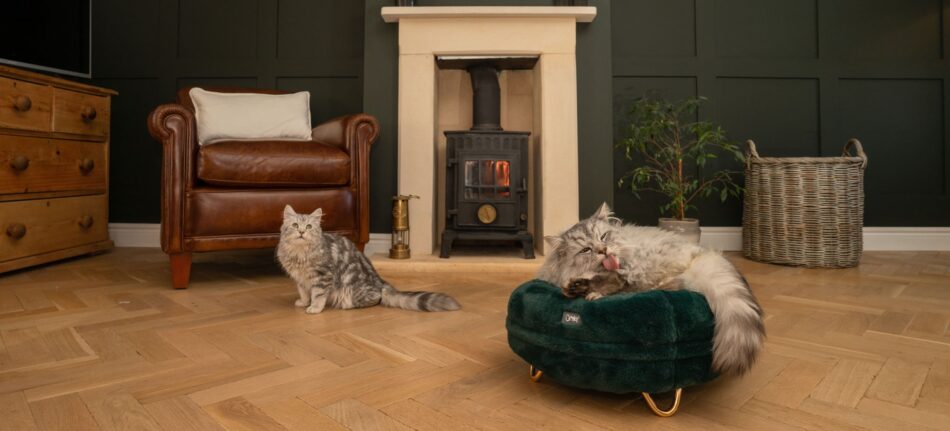
Just like us, our cats feel the effects of the cold weather that comes with winter, with some breeds less equipped for the harsh weather than others. Hairless cats, or cats with shorter coats, for example, struggle to retain their body heat during the colder winter months. Unsurprisingly, longhaired breeds such as Siberians find it easier to adapt to the cold because of their long and thick coats that offer layers of protection. However, sometimes all of our feline friends need that extra bit of help to prevent them from becoming too cold when the temperature drops. Here’s how to keep your cat warm in winter.
Do cats get cold in the house?
If you have indoor cats, you may be wondering whether they can be affected by the cold weather as well. The answer is, yes! While we can try our best to keep our homes warm by turning up the heating and wearing more layers, certain rooms always seem to feel as though they have more of a draft than others.
How can you keep your cats warm in a cold house?
Our homes can get pretty chilly over the colder months, which means you’ll often find your cat moving to areas where they can find the most warmth. Luckily, there are several ways that you can help keep your outdoor, or indoor cat warm in the home.
Do blankets keep cats warm?
One way to keep your feline friend warm inside of a colder house is to purchase a cat blanket, which you can place over a piece of furniture that your cat likes to spend time on, or even on top of their own bed. The Omlet Luxury Super Soft Cat Blanket is ideal for cold weather, with a quilted grey plush on one side, and a luxury sherpa on the reverse. How about using your pet’s blanket along with a cardboard box and cushioning to build them a cozy den? Find out how you can make one here.
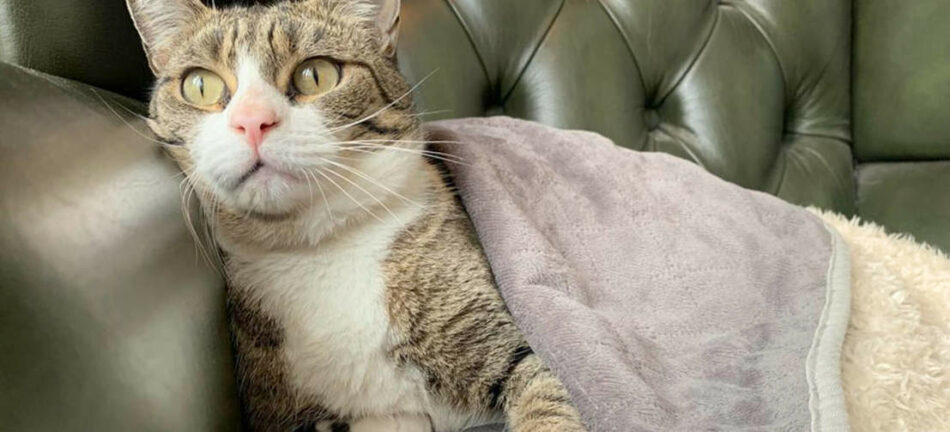
A cozy bed
In a previous blog, we explained why some cats prefer to sleep on our beds instead of their own. However, having a good quality, cozy pet bed could help to resolve this issue as well as keep your cat warm in a cold house. The Bolster and Maya Donut beds are great cat bed options, both having been designed to provide your cat with ultimate levels of comfort in mind. The snug Maya Donut Bed is perfect for winter weather, with the deluxe faux fur being irresistibly soft and cozy, alongside its squishy cushioning, making for a bed that your cat won’t want to leave!
A safe and warm hideaway
For additional comfort for cats during the winter weather, you can place your cat’s bed inside an indoor cat house. A cat house can be placed in any area of your home and will protect your cat from drafts and disturbances in their private den.
An additional top tip to help keep your cat happy and healthy over this period is to feed them more. You might notice that when it’s colder your cat appears to be more hungry, just like us! This is a response to burning more calories as they maintain their body temperature to stay warm. Try adding a bit more to their food to their diet or provide them with a few more nutritious treats to keep them going.
Something else to be aware of during the colder months as a cat owner is the location of their litter tray. Of course, it’s only natural to want to keep cat litter odors at bay, which can mean placing their indoor litter tray in a room away from where the family spends a lot of time. However, secluded areas of the home such as the garage can have more of a breeze, so be sure to move it to a warm room if need be.
What temperature is too cold for cats?
Extreme weather conditions such as really low temperatures can be detrimental, and even fatal, to cats. Older cats and kittens, as well as indoor cats, in particular, are more susceptible to feeling the cold as their bodies are not as well adapted as cats who have spent more time outdoors. Other factors such as body weight and fur also play a role when it comes to dictating what temperature is too cold. The general rule of thumb, however, is that they should not be left outside once it reaches below 44ºF.
When cats are left outside in freezing temperatures, they become at risk of developing frostbite and hypothermia. If your cat has been outside and displays symptoms such as excessive shaking, shallow breathing, being cold to touch, having blistering on their skin, or icy paws, tail tip or ears, when they return, you must contact your vet immediately.
Is it okay to let your cat outside in winter?
The best place for cats to be over winter is indoors, where you know you can keep them safe. We earlier found out just how dangerous the low temperatures can be for cats, so it’s wise to keep them indoors until it warms up again. Fortunately, when the weather gets too cold, most outdoor cats will naturally retreat to their home, where they know they’ll be warm. However, it might take other outdoor cats a bit more convincing. Keeping your cats entertained with plenty of stimulating toys is a good idea to help them get through this period, which will help with meeting their physical and mental exercise needs.
Does cats’ fur keep them warm in winter?
Cats’ fur plays a vital role in protecting their internal body structure, and how they communicate. Have you ever noticed how your cat’s hair stands on end when they’re agitated? Your cat’s fur is also there to keep them protected from the outside elements like the cold, but also from warm weather. The amount of sunlight affects how much your cat sheds, which is why you’ll find that they will often shed more during the summer months. During autumn, when we begin to lose sunlight, cats will grow a thicker winter undercoat to keep themselves insulated, ready for the cold weather.
As we previously touched on, this means that cats with longer hair have more protection from the cold weather. Hairless, or cats with short coats, need a bit more help staying warm over this season. It’s important that you are able to provide your cat with a safe, warm indoor space, regardless of breed, along with investing in additional winter supplies such as blankets. For hairless cats who struggle more this time of year, you may wish to purchase a sweater for them to keep warm and toasty. Just be sure that they are completely comfortable, and the fabric doesn’t irritate their skin.
The winter can be a tough time for our pets but as we get through the last few months of cold weather, you should continue to make sure that you’re helping to keep your cats happy, healthy, and warm with the right resources!
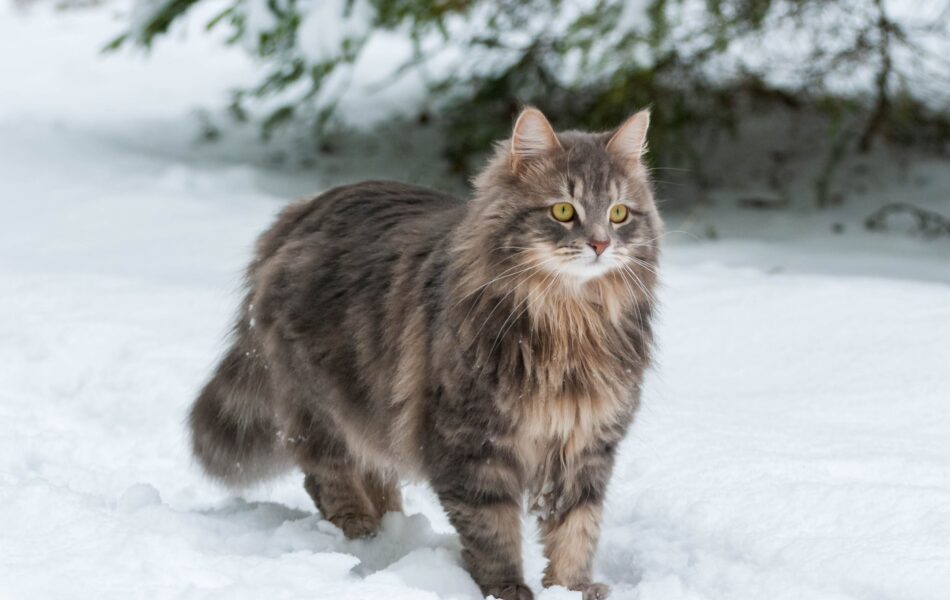
This entry was posted in Cats
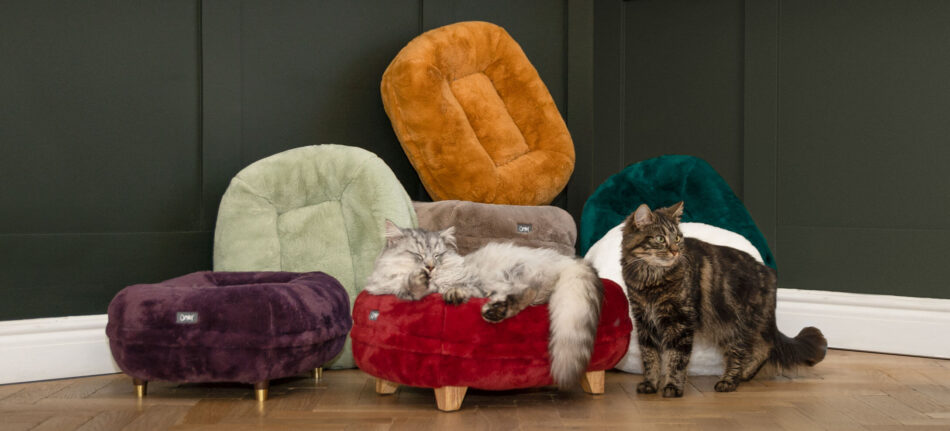 With the new Cozy Collection, there are six new amazing Maya Donut colors to choose from! If you like them all, or are just a bit indecisive, why not let your cat’s personality decide? Take the test to see which color bed your cat should have!
With the new Cozy Collection, there are six new amazing Maya Donut colors to choose from! If you like them all, or are just a bit indecisive, why not let your cat’s personality decide? Take the test to see which color bed your cat should have!
What time does your cat wake up in the morning?
- They do all their sleeping in the daytime
- 5am
- 7am
- Whenever I wake up
- When they hear the noise of food bowls being filled
- Never before noon
What does your cat do when allowed outside?
- Just sit by the door waiting to be let in again
- Chase squirrels and birds
- Sleep on a lawn chair
- Go meet up with their friends
- Sit in a tree and groom themselves
- God knows, they just run off
You have to take your cat to the vet, how do they react?
- They love it
- Run and hide somewhere I can’t get to them
- Hiss and scratch
- They make a lot of fuss for a while, then happily jumps in the carrier
- They always behave really well
- We have to get the vet to come to us, it’s the only way
What word would you use to describe your cat?
- Quirky
- Playful
- Needy
- Lazy
- Hungry
- A little cranky
How does your cat react when you come back after a day at work?
- Just roll over and continue sleeping
- Run towards me
- They always sit by the door waiting
- They are nowhere to be found
- Make sure I notice them, then go and sit by the empty food bowl
- Come in to say hi, but go away again pretty quickly
What animal would your cat be friends with?
- They are a bit of a loner to be fair
- Other cats
- Smaller animals
- Larger animals
- Dogs
- They could get along with anyone
What is your cat’s favorite treat?
- Anything with catnip
- They just love normal cat food
- Anything really smelly
- Expensive, organic cat treats
- It’s a bit weird, but my cat loves fruit
- My cat doesn’t care about food
If your cat went to school, what would their favorite subject be?
- History
- English
- PE
- Modern languages
- Science
- Break time
What is your cat’s least favorite thing?
- Dogs
- Getting wet
- Being alone
- Loud noises
- Being woken up
- Having their nails clipped
Mostly 1’s
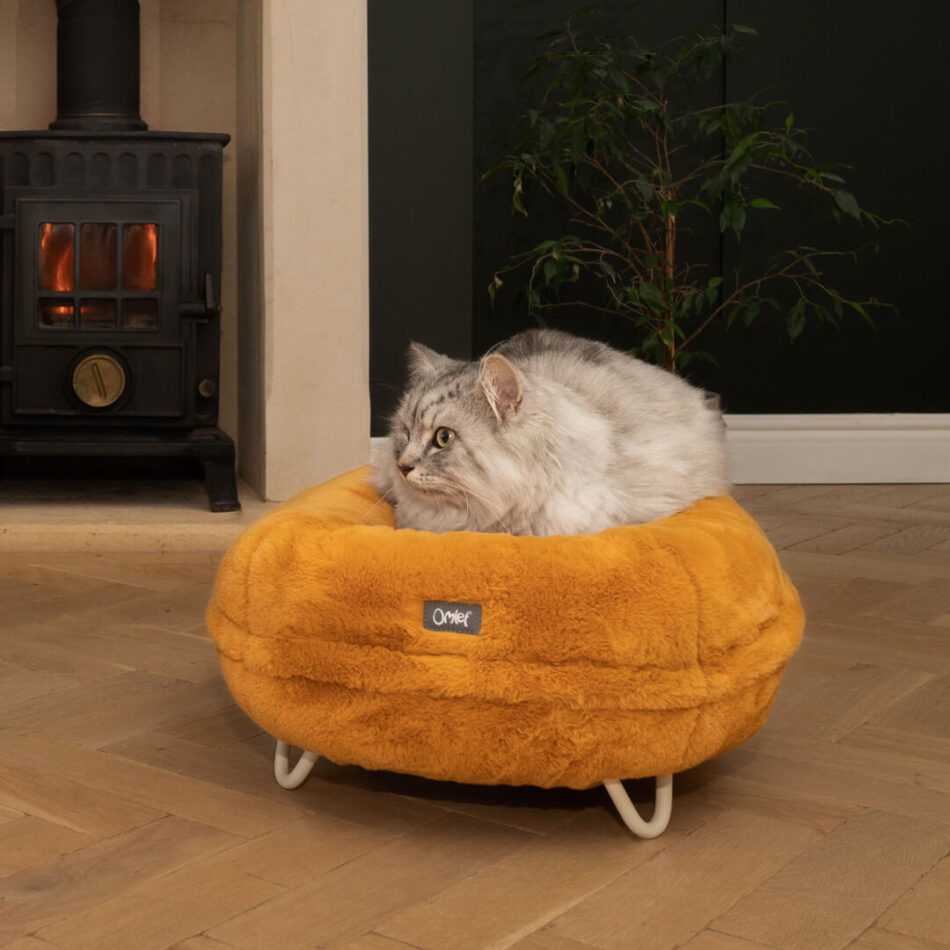
Butterscotch Yellow
Your cat knows what it wants and is not afraid to say it. The Butterscotch Yellow donut bed will be a great match, and we think it will look great against their coat as well.
Mostly 2’s
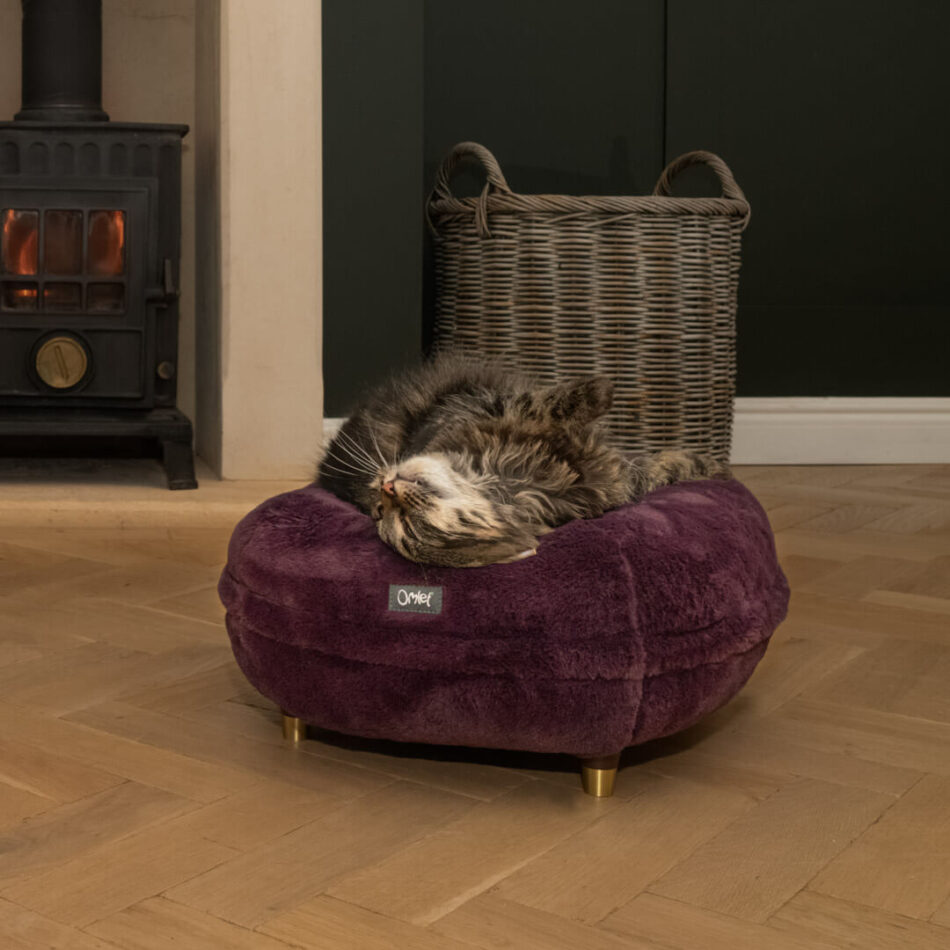
Fig Purple
Your cat is clearly full of energy, so giving them a nice, calming Fig Purple cat bed to relax on will be an improvement to their lives.
Mostly 3’s
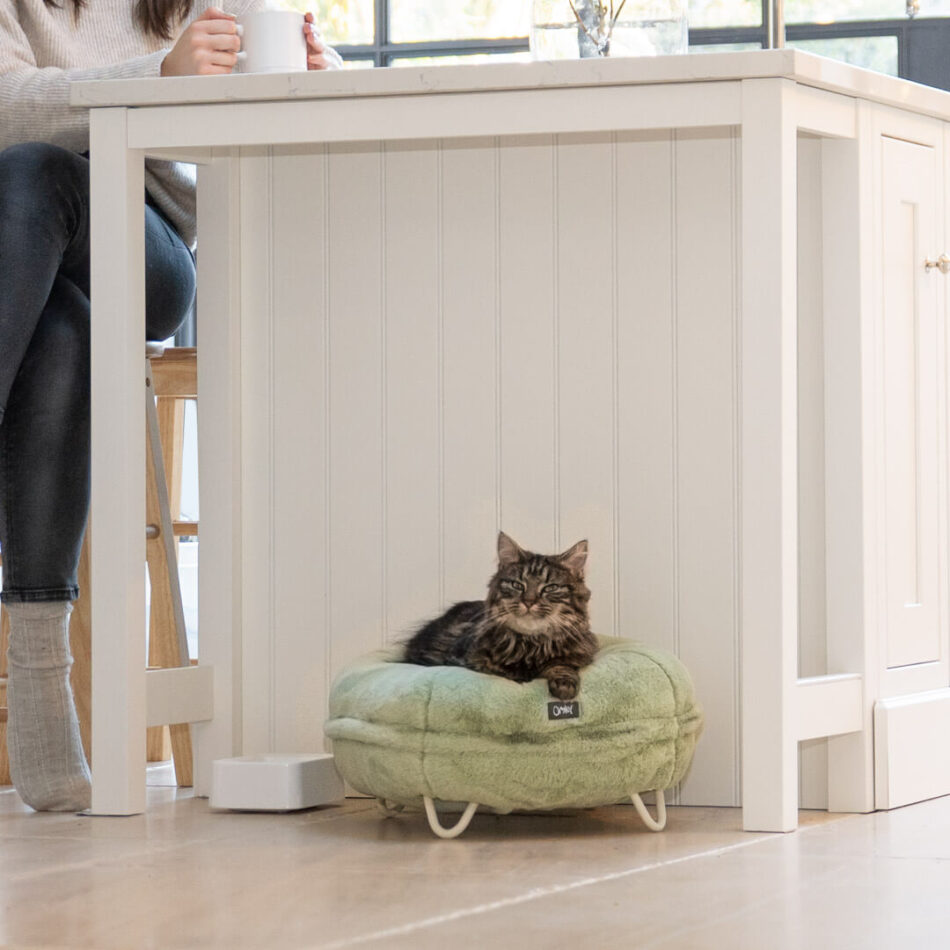
Mint Green
If your cat was a human, we’re pretty sure it would be pretty cool. Mint Green will match their amiable personality, and will look great in any room of the house.
Mostly 4’s
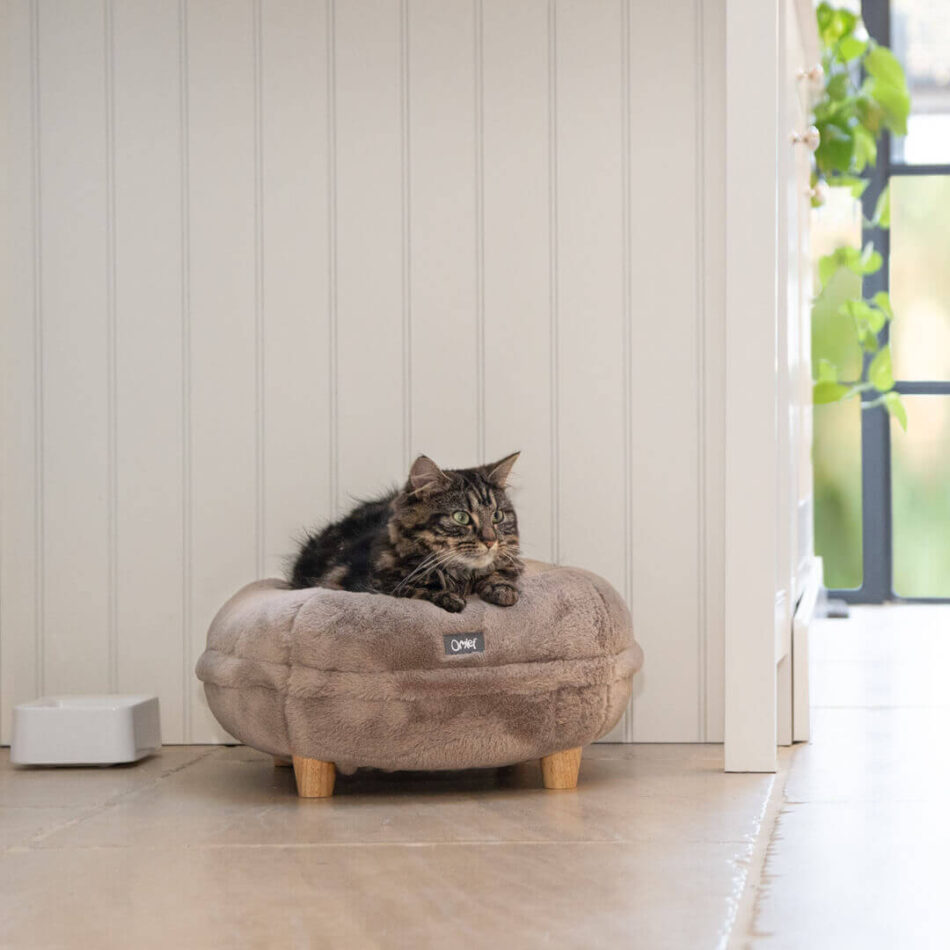
Mousse Brown
Your cat is pretty relaxed and likes to just chill out with the family. A bed that is stylish and classic will be ideal, choose the Mousse Brown Maya Donut!
Mostly 5’s
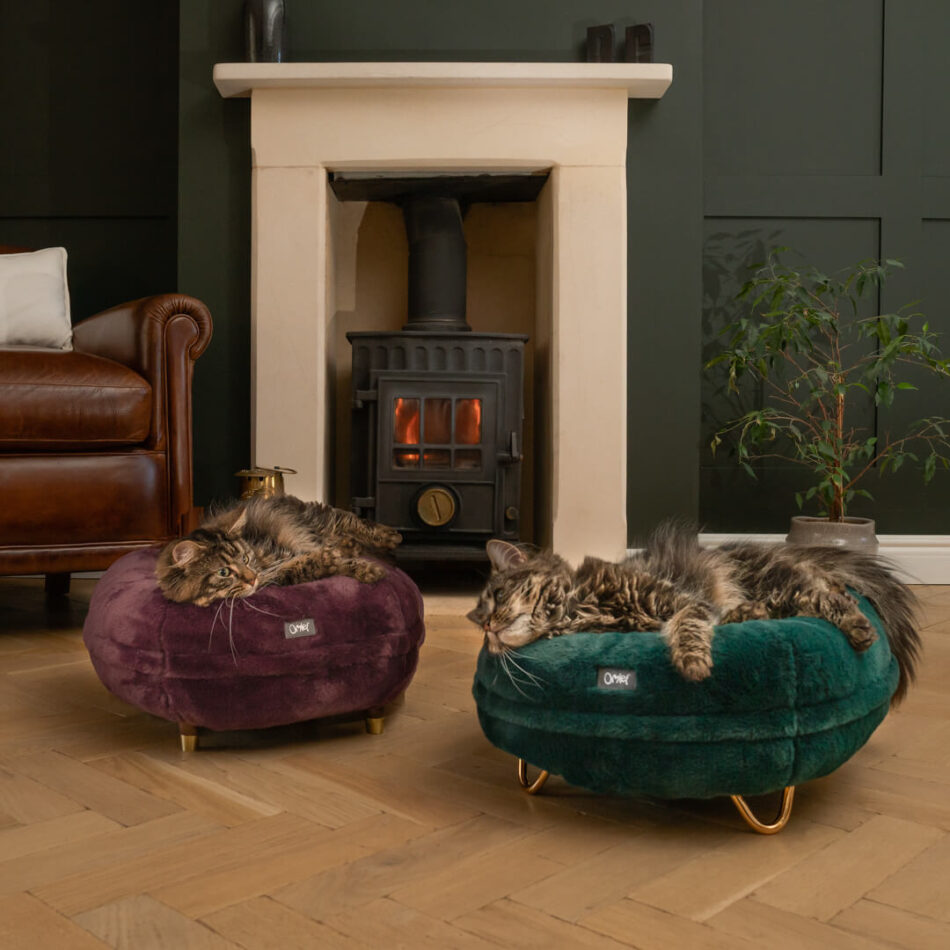
Peacock Green
We get the feeling your cat is a bit of a sensitive soul, and the color that goes best with that is of course a lovely Peacock Green.
Mostly 6’s
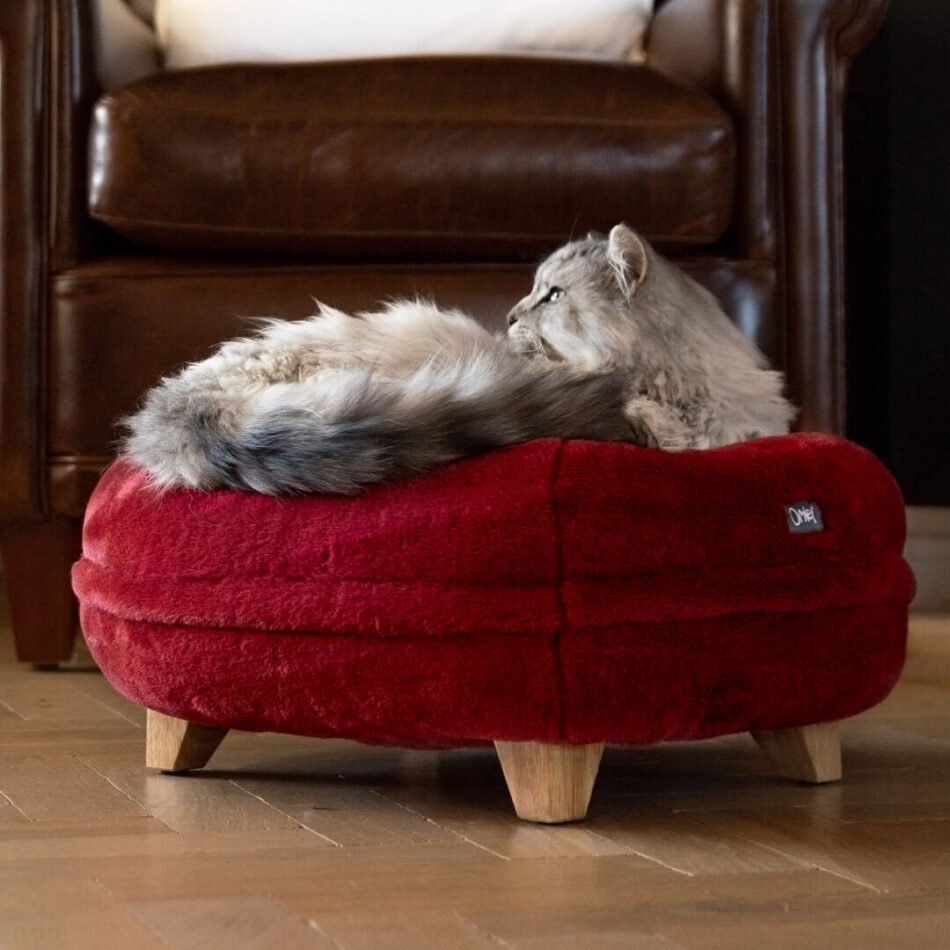
Ruby Red
Your cat is a rebel, so they need a bed to match their fiery personality! Ruby red will be perfect.
This entry was posted in Cats
Every cat owner knows the feeling of treating their feline friend to a new bed, only for him to reject it in favor of the cardboard box it came in, or even worse, jump straight back on to your bed and curl up right in the middle! But why is it that cats often like to sleep on our beds instead of their own? And can their minds be changed?
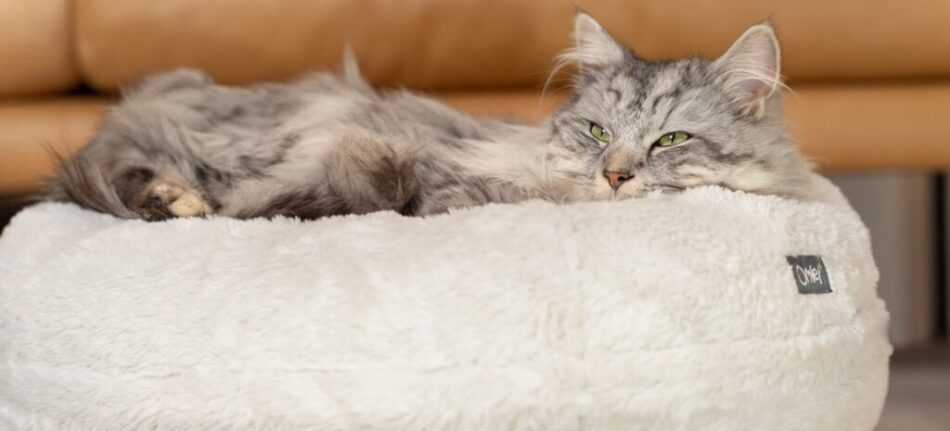
How long do cats sleep for?
Cats sleep an average of 12 to 16 hours a day! That’s double a human’s recommended sleep time. It’s no wonder cats can be so particular about where they choose to rest and can be found sleeping in different places all around the home, often depending on the time of day or night. Their important sleep routine should be supported by the perfect bed, so why do they choose yours?
Why does my cat prefer to sleep in my bed?
Many surveys have concluded that owners who allow their cat to sleep in the bed with them have a worse night’s sleep due to having less space or being disturbed by their cat meowing, snoring, purring or grooming, yet cats don’t seem to mind bunking with their owners!
You may also notice your cat is getting more use out of your bed than you and chooses to curl up there for a quick cat nap, or even a leisurely 5-hour snooze. This also leads to many cat owners reporting they have to wash their bed sheets more often if they share the bed with their cat.
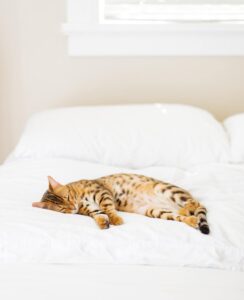 Cats may like to sleep with their owner for warmth, company or reassurance, but it may also simply be because your bed is far better than theirs.
Cats may like to sleep with their owner for warmth, company or reassurance, but it may also simply be because your bed is far better than theirs.
Why won’t my cat sleep in its own bed?
A commonly cited reason for cat owners not buying their cat a bed is that they think they won’t use it, but never giving your pet the chance to find somewhere else cozy to sleep will surely mean a life of nighttime disturbances for you.
It’s no secret that cats are the fussier pet in the home. This fussiness might extend to wanting a particular brand of cat food or litter, and of course refusing to sleep in that luxurious new cat bed you treated them too.
But why is this?
If your cat is eager to curl up on your thick fluffy blankets, or stretch out on your own memory foam mattress, the problem could lie with the quality and style of the bed you have chosen for your cat. Do you need to get your cat a new bed?
Image by Paul Hanaoka from Unsplah
Which cat bed is right for my cat?
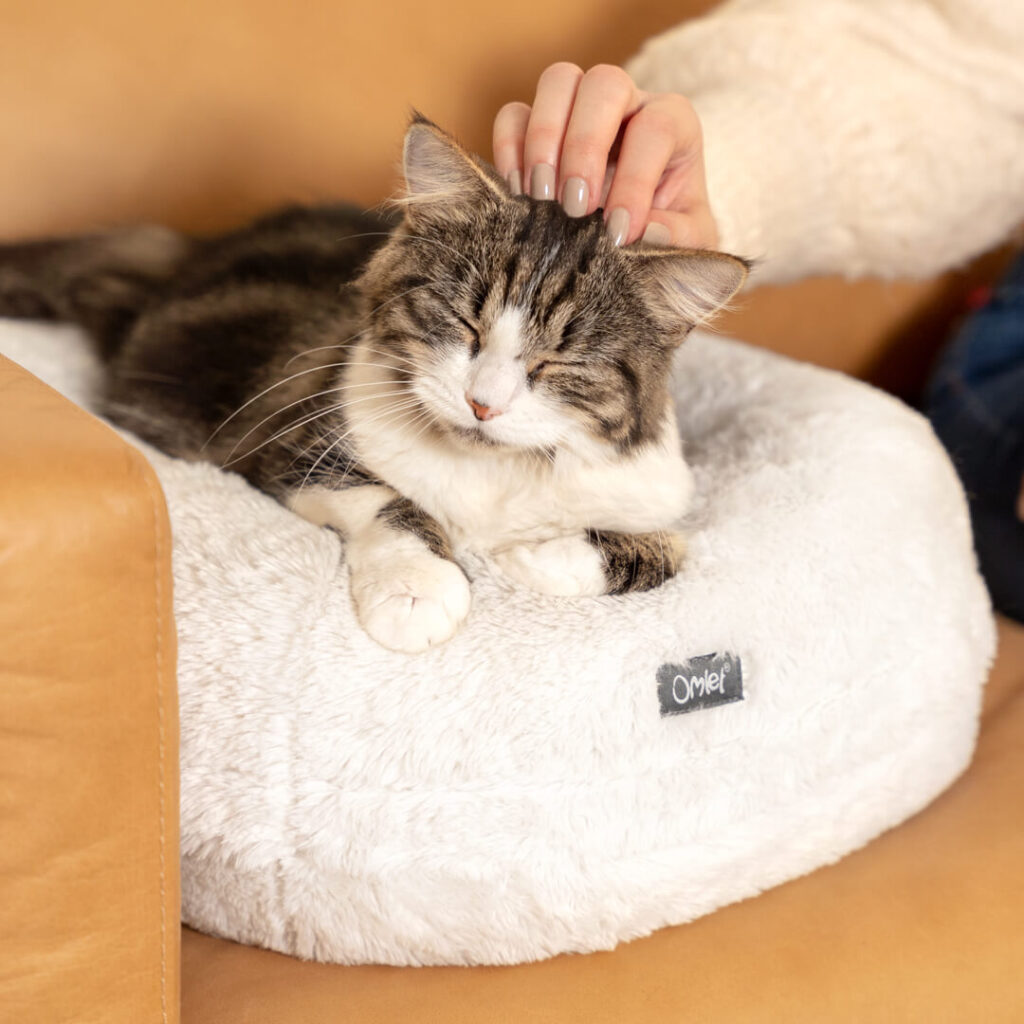 The first step to finding a bed your cat will actually use is identifying what they like; there is no use in buying a small cave bed if your cat prefers to stretch out across the sofa, or a thin, flat bed if your cat likes to sleep in a deep, squishy cushion. Ignore novelty cushions, get your cat a bed they will actually love.
The first step to finding a bed your cat will actually use is identifying what they like; there is no use in buying a small cave bed if your cat prefers to stretch out across the sofa, or a thin, flat bed if your cat likes to sleep in a deep, squishy cushion. Ignore novelty cushions, get your cat a bed they will actually love.
If your cat likes to curl up and sleep on a plush or faux fur blanket on the sofa, consider a fluffy bed they can really sink into, like the new Maya Donut Cat Bed from Omlet. The removable, machine washable cover is super soft to touch, and the deep donut cushioning supports all around the body for a warm and cuddly feeling which will lull your cat to sleep.
If your cat likes to sleep near you, place the Maya Donut Bed on the sofa for a cozy cat cushion. You can also raise the bed off the floor with sophisticated, designer feet to minimize drafts, disturbances, and maximize style.
For cats who like sleeping on their owners thick, memory foam mattress, consider a memory foam bed they can call their own, like the Omlet Bolster Bed. The generous size of the bed will allow your cat to stretch out and roll around just as much as on your nice double bed, and they can still curl up against the cushion of the bolster edge.
How can I encourage my cat to sleep in its own bed?
The position you have placed the bed in the home may also be unfavorable for your cat. Notice where your cat chooses to sleep in the day and place the bed near this area. If your cat sleeps on your bed or the sofa, start by placing the cat bed on top of these.
Use treats as a reward for getting on the bed voluntarily. Make sure not to move the bed repeatedly around the home, this could unnerve your cat and make him resistant to getting too close for fear of it being moved away again!
Some cats don’t like sleeping on the ground, so consider raising the bed up with feet, like for the Maya Donut Bed. You can also place the bed in a sleek frame, like the Maya Sofa, perfect for the Bolster Bed.
Why has my cat discarded his old bed?
If your cat has decided his once favorite cat bed is no longer for him, it could simply be a small personality change. If he’s not showing any other signs of abnormality which could hint to a health problem, he could simply have got bored of the bed, or found a better sleeping spot somewhere else in your home.
It could also be that the bed has lost its cushioning and is simply no longer comfortable enough for your cat to sleep on, or perhaps the bed has become dirty or smelly and your cat would prefer a fresh start. This also might be the case if you’ve got another cat in the home who has stolen the other cat’s best nap spot.
Make sure to buy a bed with an easy to remove and machine washable cover so you can keep the bed fresh, and a high-quality mattress or cushion which won’t lose its plumpness!
It’s important to give your cat freedom to sleep where he or she feels most comfortable, and if that’s a cardboard box then so be it! But by ensuring your cat has at least one warm and cozy option and using positive encouragement, your cat might see the benefit to his own space and finally let you sleep in peace!
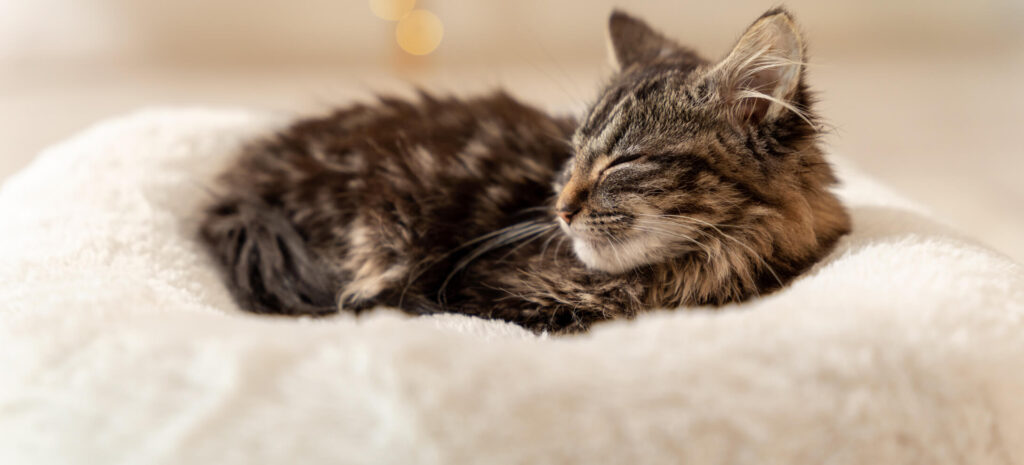
Introducing the new Maya Donut Cat Bed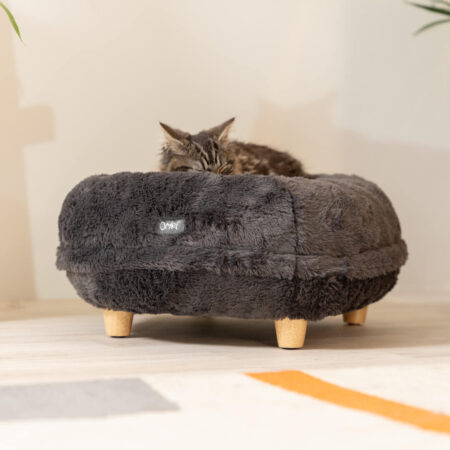
- Super soft and luxurious feel for a restful cat nap
- Removable, machine washable cover is easy to keep clean
- Raise the bed with designer feet for style, comfort and hygiene
- Supportive shape with deep filling for a warm, cuddly feeling
- Choose from two stylish colors to suit your home
- One size suitable for cats up to 11 lbs.
- Available from $28 now!
⭐⭐⭐⭐⭐ Gemma, Verified Omlet Product Tester – “I am so glad I have finally found a cat bed that is not only nice to look at but my cats love! I find that cheaper cat beds lose their shape and color quickly, and this hasn’t happened at all! It still looks great, and a super easy to wash cover means it will stay looking great for a while yet! Can’t recommend enough!”
Buy your cat’s dream bed now
This entry was posted in Cats

Are you struggling to find the purrfect Christmas present for a cat lover you know? Rest assured, you’ll be bound to find something the the Omlet Black Friday Sale! A number of cat toys and accessories are on offer this year so you’ll want to hurry to ensure you won’t miss out on some unmissable savings!
Donut Cat Bed
If you’ve got a cat who loves nothing more but to snuggle up and get cozy, the Maya Donut Cat Bed will be top of their Christmas wish list this year! The donut shape means your cats will have optimum support, that will provide them with a cuddly feeling that they’ll absolutely love. The faux fur material is so soft to touch that it will have your cats in a state of pure tranquility!
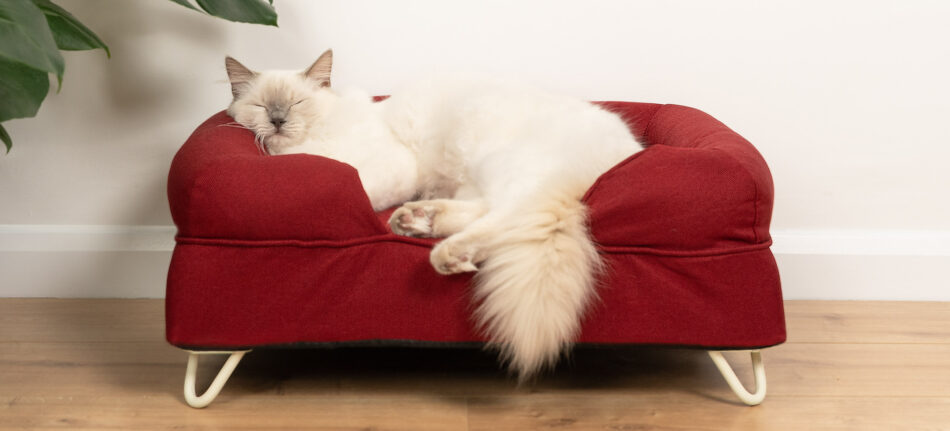
Bolster Bed
The Bolster Bed is another super soft cat bed that will also be an excellent Christmas gift for any cat parents.The zip-on, machine washable covers make them ideal for getting rid of any odors or fur balls.
With a range of 15 different beautiful colors and a range of designer feet to choose from, the Bolster is ideal for any cat parents who want a stylish bed to match the interior of their home!
Luxury Super Soft Cat Blanket
No cat will be able to say no to the Omlet Luxury Super Soft Cat Blanket! The beautiful throw can be placed on your cat’s favorite spot in the home, or even in their bed to help them get an even better sleep. The blanket is double-sided and also comes in two designs – grey and cream and poinsettia red and cream, giving cat parents the option to find the right style for their home.
Outdoor Cat Run
If you have an indoor cat that loves feeling the wind in its fur, a pedigree cat who can’t be left to roam free in the neighborhood, or live close to a busy road but want to give your feline friend a feel of the great outdoors, we have got the perfect gift for you. The Omlet Outdoor Cat Run is a customizable catio that is both stable and secure, where you will be able to spend time with your cat and give them some fresh air, while still knowing they are safe.
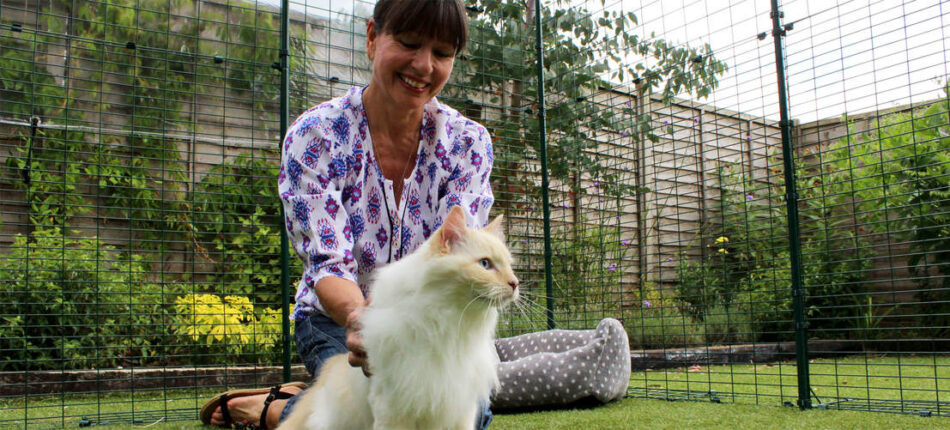
This entry was posted in Cats
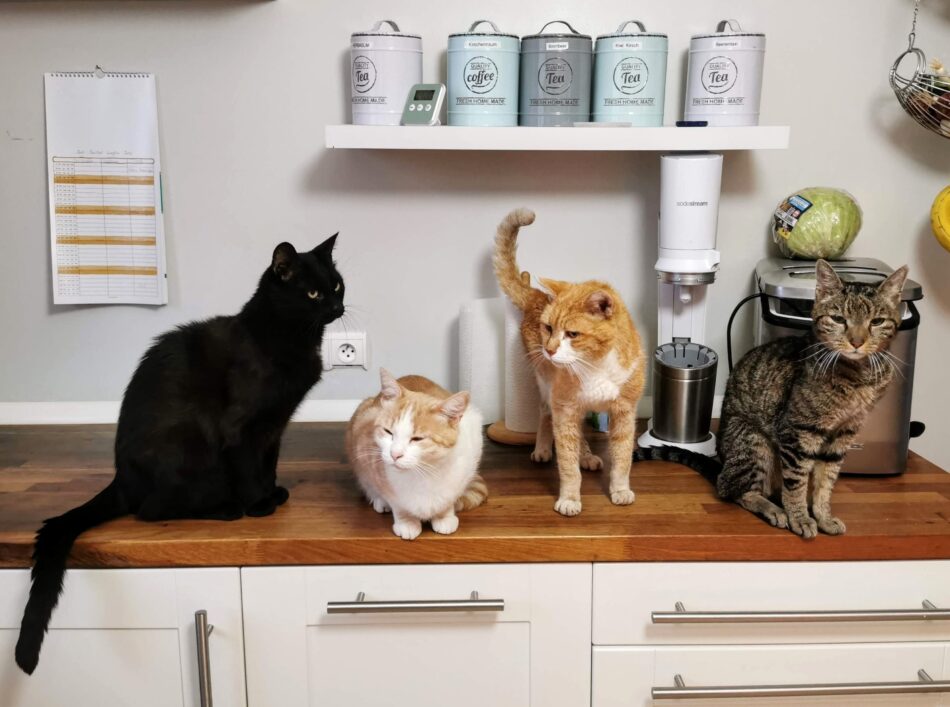
Photo by Dietmar Ludmann on Unsplash
Despite many cats enjoying being independent creatures, according to the PDSA PAW Report, 43% of cats in the UK now live in multi cat households. While it’s understandable why so many of us give in to the temptation of introducing another feline friend into the home, it’s also important to be cautious of the potential onset of cat behavioral issues such as aggressive behavior i.e. hissing, growling, or chasing as a result of doing so, and to consider if the dynamic of a multi cat household would work for you and your family. However, if you do decide to take the plunge, here are some tips on how you can try and keep the peace.
Plenty of Exercise
Providing your cats with plenty of exercise will help to keep them at a healthy weight and keep them stimulated. Both are important for all cat owners, even those who only have one cat. However, for cats who live amongst other cats, keeping active can aid with avoiding a potential buildup of excess energy, which can sometimes manifest itself as aggression towards other cats in the household.
One way to help keep your cats exercised is through play, which will also help to strengthen the bond between you and your furry friend. How about trying the new catnip wand toys that will encourage your cats to chase and provide them with endless hours of fun. Another great way of exercising your pets is to invest in a cat tree. Cats love climbing and scratching, so a cat tree is one sure way to encourage this and keep them entertained.
Use Pheromone Diffusers
Pheromone diffusers are an odorless plug-in product that works by producing pheromones, or chemical substances, that your cat naturally releases when they either rub against surfaces, scratch at items, bump heads with humans or other cats, or spray. Pheromone products mimic how pheromones would naturally send messages between cats, meaning that they can help in multi cat households to have your cats to feel more relaxed, and reduce their stress levels.
Multiple Litter Boxes
It’s important that your cats have their own litter box when they live with other cats. This is because of their territorial nature, which often means that cats like to ‘claim’ where they go to the bathroom and do not like this area to be shared. If cats feel as though their territory is under threat, this can lead to aggressive behavior such as fighting.
Furthermore, most cats will refuse to use a dirty litter box, which will likely happen should you only provide a single litter box for several cats, as of course, their waste will accumulate more quickly than if your cats were to have their own. The general rule of thumb is that you should have one litter box per cat, plus one spare to have placed out in your home.
Separate Feeding Stations
Cats like to be alone when they’re eating, meaning that if you have multiple cats, they will require separate feeding stations at mealtimes. When cats are forced to share the same area for feeding time with another cat, it can take away from their predatory instinct to hunt and eat by themselves, which inevitably can induce anxiety and aggressive behavior. In a multiple cat home, cats may see a shared feeding area as an opportunity to compete for food, which could result in you having a ‘food bully’ on your hands. As well as providing your cats with their own food bowls, give them each a designated space in the home to eat any from any other cats.
Furthermore, creating this divide will help your cats to stay healthy by having them fed equally, or in accordance with their own specific dietary needs, as it ensures one cat cannot access the other’s food. For example, factors such as the age, weight, or medical condition of your cat/s may mean that they have to be fed different diets. Therefore, it’s fundamental that you leave each cat’s bowl out of reach from any potential cat food thieves!
Personal Space
By nature, many cats need their own personal space, even when they’re not eating. It’s a good idea to have an area in the home that they can go to escape to by themselves, away from both humans and other animals. If you have the room, it’s advisable that each of your pets have at least one of their own private areas in the home that they can go to without being disturbed and becoming overwhelmed. This may even be a cardboard box if you’re limited for space but be sure this is away from the hustle and bustle of the home or outside.
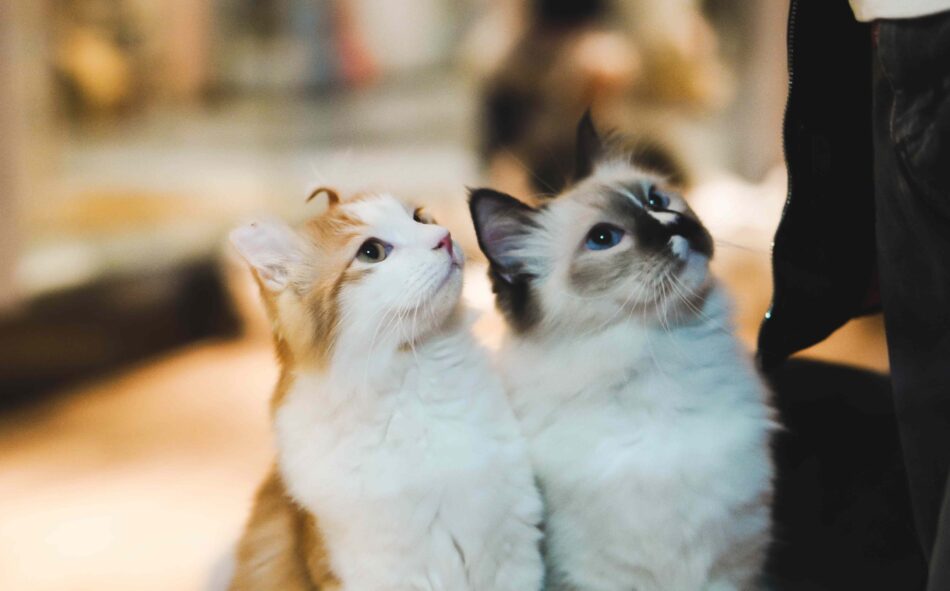
Photo by Kelly on Unsplash
Introducing a new cat can be a difficult time for you and your already existing pet, but fortunately, it’s not impossible to make multi cat households work. So, after a bit of advice, hopefully the transition period will be a lot easier. However, should you notice any signs of aggression between your cats, it’s important to seek help from a veterinarian before these issues get out of control.
This entry was posted in Cats
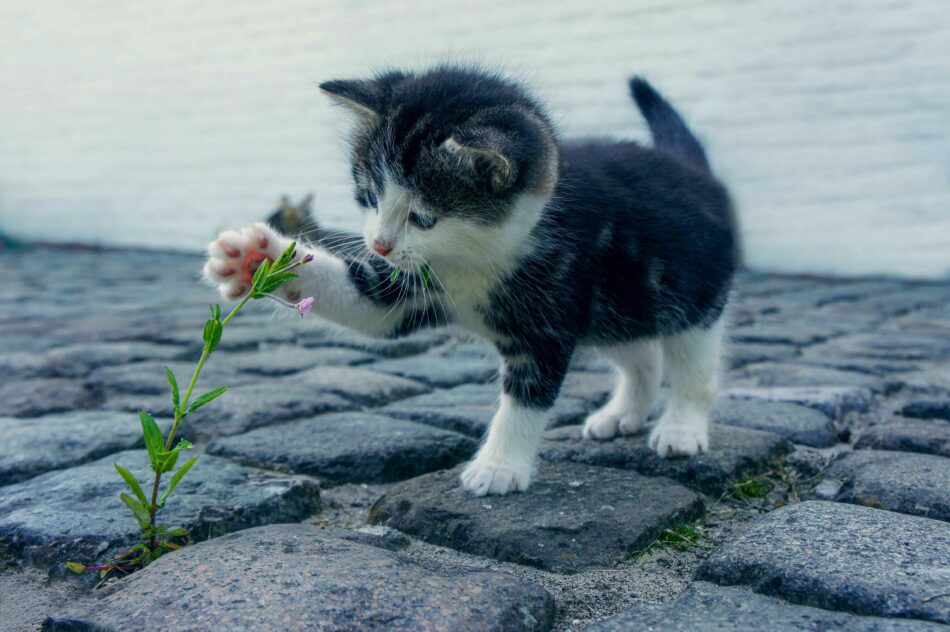
Whether in our gardens or in our homes, plants not only enhance the overall appearance of a space, but they can also help boost moods, increase creativity and reduce stress. But did you know some plants can actually be toxic to your cat if ingested?
While it’s important to know which plants could pose a danger to your furry friend, it is still possible to have green decor and healthy felines coexisting in the same place. So before you forego an indoor nature collection on account of whiskers, browse these 10 cat-friendly plants that are safe for your kitty and look good in your decor.
Why do cats eat plants?
Cats are curious. And just like little children, they often explore new things with their mouths. But if cats are obligate carnivores, or mostly meat eaters, why are they munching on my houseplants? There are several reasons, actually, and it’s best to start with their natural roots.
While most cats are domesticated from the wild, they still possess some innate, instinctual behaviors from their feline ancestors. Eating plants is very common among the cat population and is often something they do to explore textures, help pass a hairball, or even to just increase some nutrient value in their diet. But one of the most common reasons cats eat plants is out of sheer boredom.
You can solve the instinctual desire by only buying cat-friendly plants to keep your cat safe. And having a few sturdy and durable cat scratchers around will help as well. With a cat scratcher like Stak designed by Omlet, you will not only keep boredom at bay, but your cat will be entertained for hours!
10 non-toxic plants for cats
Grasses
If you were to give your cat a grass menu, they would likely choose “clippings from this morning’s mow” or a side helping of “dew covered sprigs”. When it comes to grasses, most cats are not that picky. But in order to be sure your nursery doesn’t send them to the emergency, stick to harmless grass options such as bluegrass, lemongrass and purple fountain grass.
Ponytail palm plants
Known as the most patient of all houseplants, the ponytail palm plant is both easy to care for and easy on your cat. While it looks (and sounds) like a tropical greenery, this drought-tolerant plant is actually a succulent. In order to maintain its non-needy nature, the ponytail palm stores water in its trunk and produces long curly leaves that look like ponytails. So not only is it safe for your kitty to be around, but it gives your room a calming, tranquil look as well.
Catnip/Nepeta cataria
The only thing your cat loves more than you is catnip. And as luck would have it for you both, this euphoric herb plant is 100% safe for your cat to be around and nibble. Part of the mint family, catnip omits a scent that most cats find simply irresistible. Whether you have it in a planter in the corner or throughout your outdoor garden, cats are wildly attracted to this fragrant plant. In fact, it’s completely normal if you catch your kitty rubbing up against, rolling on or just straight up licking your catnip plant. They literally can’t help it.
Spider plants
When you see a spider in your house, you can usually count on your frisky feline to catch the pesky insect. But what if that spider is on a spider plant? No problem! This cat-friendly plant is completely non-toxic and 100% safe for your kitty to be around. And unlike the legged version, spider plants are easy to care for and simple to maintain.
Prayer plant
If your decor is one that invites a bolder, more colorful style, then a prayer plant may be just the houseplant you, and your cat, need. With striking leaves of striped white and pink colors, these cat-friendly plants are completely safe for your furry friend to be around.
Christmas cactus
While the name may imply that it is only a holiday plant, the Christmas cactus is actually available year-round and is also non-toxic for your cat. More of a succulent than a plant, this feline-friendly cactus produces beautiful pink flowers that are not harmful to your kitty if ingested. And bonus, they add bright color to your greenery decor.
African violet
One of the most popular flower-blooming houseplants that is also safe for cats is the vibrant African violet. Due to their low maintenance care, many people with, and without, green thumbs like these plants as they add beauty to their space without a lot of requirements. And you can feel at ease knowing the flowers and leaves are not harmful to your cat if nibbled on.
Callisia turtle
This vine-like succulent plant is a great choice for your indoor garden decor as it mystically spills over pots with dense leaves and small white flowers. A unique addition to any home decor, the callisia turtle is also completely feline friendly. In fact, if your cat does eat it, don’t worry – this plant is full of nutrients. Rich in minerals and calcium, the callisia turtle can actually benefit your cat’s digestive system.
Banana tree
Looking to go bigger with your green decor? Then look no further than a banana tree – a dramatic accent plant that is also cat-friendly. The central stems of this tropical plant are often used in human cuisine, so it comes as no surprise that it has also been deemed a safe plant for felines to feast on as well.
Goldenseal
Herb plants are always a great choice when looking for cat-friendly greenery as most are harmless for your cat. Goldenseal sits at the top of the cat-safe list as it’s not only non-toxic but can also be used to treat everyday ailments. Used as a disinfectant for wounds and other sores, goldenseal is known for its soothing and healing properties. In fact, some studies show that, if ingested, goldenseal can help treat ulcers or high blood pressure in your cat as well.

Plants to avoid for your cat
The best defense against your cat’s health is a knowledgeable offense of which houseplants are toxic and potentially dangerous for your furry friend to be around. So if you have a cat in your home, you should be aware of which plants to stay away from to safeguard your cat’s health.
While this list is not exhaustive, some of the more popular indoor and outdoor plants to avoid are: Dieffenbachia, lily of the valley, lily, ficus, azalea, anthurium, daffodil, oleander, holly and mistletoe, poinsettia, yuccas, amaryllis, tulips, and sago palm.
But when purchasing any plants that your cat may be around, it’s best to do your research ahead of time to avoid any doubts or dangers. You can gather information on the internet or consult your vet or the nursery seller for advice as well. And remember, if your cat does ingest or come into contact with any of these toxic plants, you should immediately call or take your cat directly to the vet to seek help.
Omlet and keeping your cat safe
Cats are curious by nature and often unafraid to explore. And while no pet company can stop the inquisitive and common behavior of plant-eating among cats, we endlessly ask how we can help you both stay safe and happy. With the Stak cat scratcher to end kitty boredom or the Catio outdoor cat enclosure that allows your feline to be in nature safely, we create the products that keep your cat out of trouble.
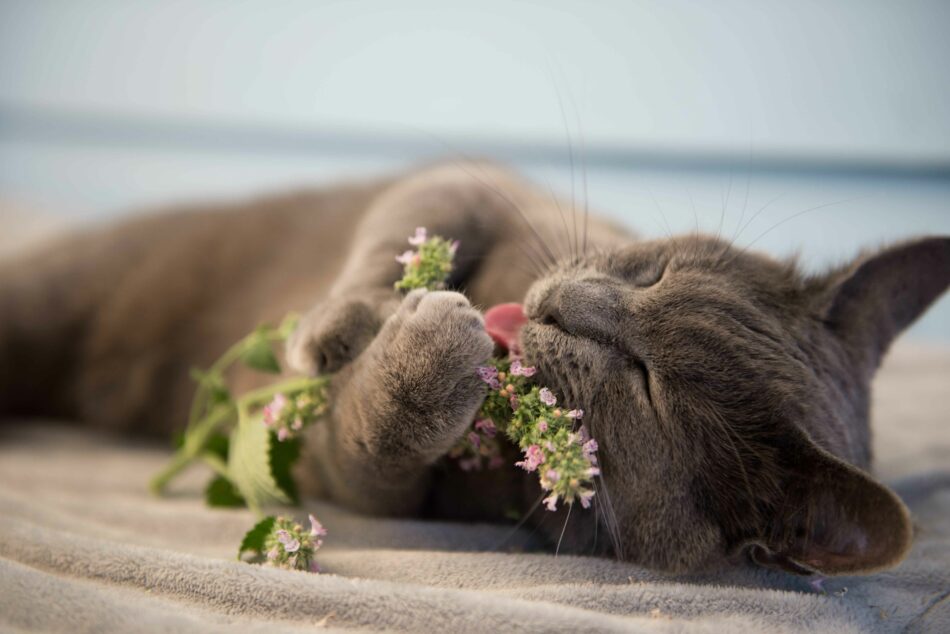
This entry was posted in Cats

Some animals, such as rabbits and guinea pigs, are herbivores. Others, like hamsters, are omnivorous. Finally, there are also carnivores like cats that cannot survive without meat.
All animals need to have their nutritional needs satisfied. However, this does not mean you can’t have a vegan dog. Vegan cats, though, are a lot trickier.
Can my dog have a vegan diet?
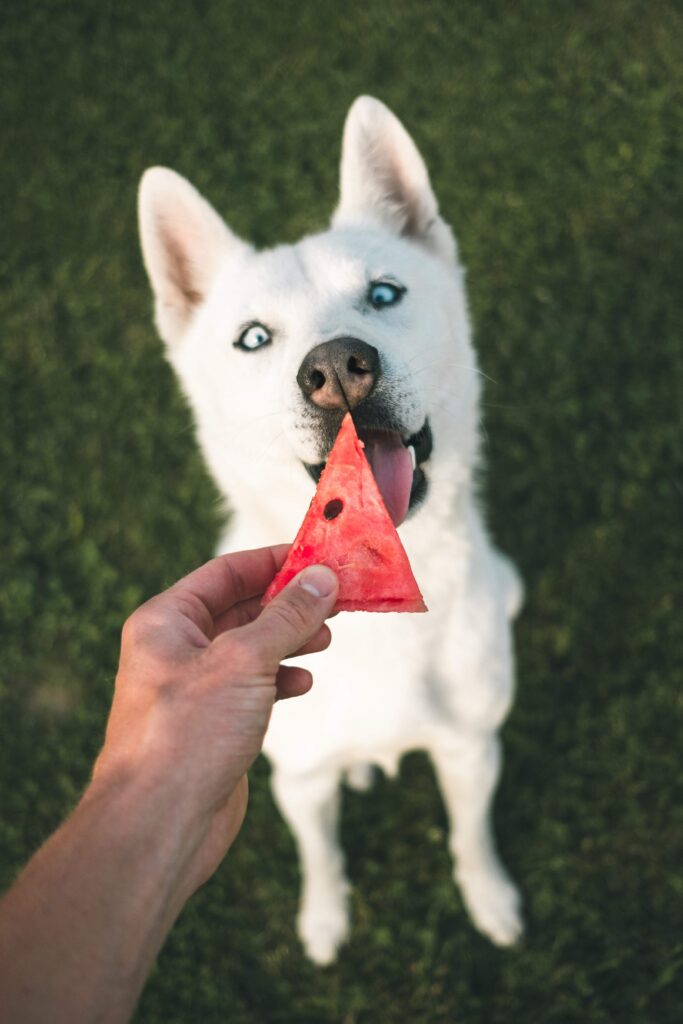 If you were to meet a species of animal for the first time and had to make an accurate guess about its diet, you would get lots of clues by looking at its teeth. The teeth of a dog, like the teeth of a bear, proclaim loud and clear that this animal is an omnivore – that is, one that eats both meat and vegetables. If you think of your dog as a domesticated wolf, you get a good idea of its natural diet.
If you were to meet a species of animal for the first time and had to make an accurate guess about its diet, you would get lots of clues by looking at its teeth. The teeth of a dog, like the teeth of a bear, proclaim loud and clear that this animal is an omnivore – that is, one that eats both meat and vegetables. If you think of your dog as a domesticated wolf, you get a good idea of its natural diet.
However, as the panda proves, a supposed meat-eater can sometimes get by perfectly well on a vegan diet. A panda’s teeth are similar to any other bear’s – long canines for meat-eating and molars for grinding vegetation. And yet pandas don’t eat anything other than bamboo. So, if a bear can be vegan, does that mean you can have a vegan dog?
The answer is yes – but it’s a yes with lots of small print! A dog requires a diet that contains the fats and proteins it would get from meat. It is dangerous to ignore this basic need and simply feed your pet with whatever you please. Some dogs have delicate stomachs. Also, a low-fat/high-fibre diet can cause potentially life-threatening problems. A diet that excludes meat should never be fed to a dog without the advice of a professional pet dietician.
The collagen, elastin and keratin found in meat diets are not easily replaced by veggie equivalents. Your dog will also need the ‘long chain’ omega-3 fats found in animal products such as egg, fish and some meats. Vegan omega-3 fats are not the same as animal-derived ones.
All of which presents a headache for the vegan dog owner. There are, however, products available that claim to let your dog live a healthy, meat-free life. Before you take the plunge, it is essential to seek professional, scientific advice and guidance. Compromise is usually the best choice here – a vegan diet supplemented by some of the animal-derived essentials. Crickets, for example, can provide lots of the amino acids and keratin a vegan diet lacks, and they’re 65% protein.
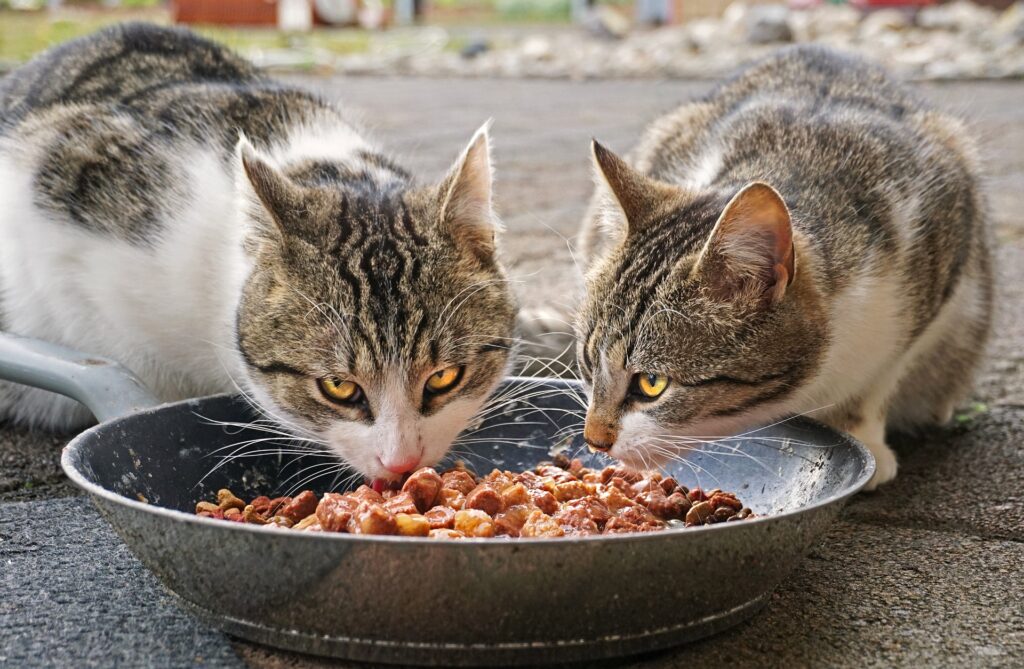
Can my cat have a vegan diet?
The compromise approach is even more important for cats. These are amongst the planet’s true carnivores, obtaining all their dietary requirements from other animals.
The main challenge with minimizing the meat in a cat’s diet is that, unlike many mammals (including dogs), cats cannot produce certain proteins. They have to absorb these from the meat and fish in their diet. Amino acids are another issue – cats deficient in the animal-derived amino acid taurine, for example, usually succumb to a specific type of heart problem.
Even a fortified vegan cat food cannot be confidently recommended. Turn the situation on its head, and try to imagine weaning a rabbit onto a meat-only diet, and you will get some idea of the challenge – and the ethics – involved.
There are some lab-grown ‘meat’ products in development, with vegan and vegetarian cat owners in mind. However, whether these will arrive – and remain – on the market any time soon is hard to guess.
For many vegan pet owners, there is a huge ethical issue involved in feeding the animals they share a space with. Ethics, however, include the animal’s needs too, and it’s an almost impossible issue to resolve when it comes to cats. If you are able to reduce but not eliminate the meat in your cat’s diet, that’s the safer option.
Top 10 pets for vegan households
There are, of course, plenty of other pets that don’t eat meat, or that eat some meat but can still thrive on a meat-free diet. Here are our ten favorites.
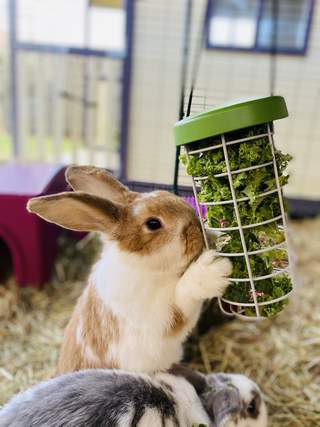 1. Rabbits. No problems here – rabbits are happy vegans, with diets based on hay and vegetables. You could argue that the soft pellets they eject and then eat are animal products of a sort, but they are simply semi-digested vegetation.
1. Rabbits. No problems here – rabbits are happy vegans, with diets based on hay and vegetables. You could argue that the soft pellets they eject and then eat are animal products of a sort, but they are simply semi-digested vegetation.
2. Guinea pigs. Like rabbits, these wonderful little characters thrive on a 100% vegan diet.
3. Hamsters. Most hamster owners give them store food, you don’t always know what’s in it. However, hamsters, like rats and mice, can do without meat.
4. Gerbils. Like hamsters, gerbils are omnivorous. They have sensitive stomachs and need a quality pellet mixture. Too much fresh produce can harm their digestive system.
5. Mice. Although they will eat pretty much anything in the wild, mice can thrive on vegan diets; but it is still best to use a food mix prepared specifically for them. This ensures that they will not be deficient in any of the vitamins and minerals they need.
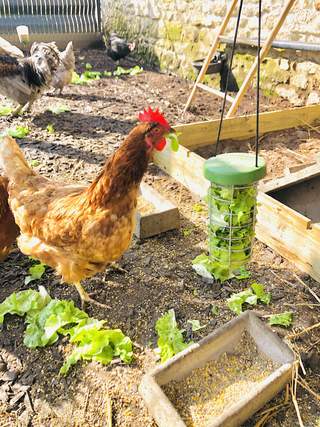
6. Rats. These are the most omnivorous of rodents, but as long as you feed them a vegan mix that has been fortified with all the nutrients they need, they will thrive. Be careful, rats who eat too much animal fat tend to become fat and die prematurely.
7. Chickens. If you watch a free-range hen, it soon becomes clear that she will eat anything – grass, beetles, worms, and everything in your vegetable patch if you’re not careful! Most chicken feed emulates this mix of plant and animal products. However, it is possible to buy vegan chicken feed, and circumstantial evidence suggests that hens can thrive on it. However, they are likely to produce fewer eggs, and you will not be able to stop them scratching for worms and bugs, no matter how vegan the layers pellets are!
8. Parakeets and parrots. Vegans will have no obstacles to face with budgies and parrots, unless the birds are being bred. Egg-brooding female birds need a protein boost, normally delivered via an egg-based food or cooked meat. Vegan alternatives are available, though.
9. Finches. Many finch species enjoy bugs and mealworms as treats, but these are not an essential part of an adult finch’s diet. These birds thrive on a mixture of seeds and fresh vegetables.
10. One for reptile fans. When you think of pet snakes and lizards, you probably have an image of dead mice or doomed crickets. However, there are a few commonly kept pet reptiles that eat a 100% vegan diet, the most popular being the Green iguana. Getting the balance of vegetables just right is very important for the animal’s health, but meat is certainly something you won’t have to worry about.
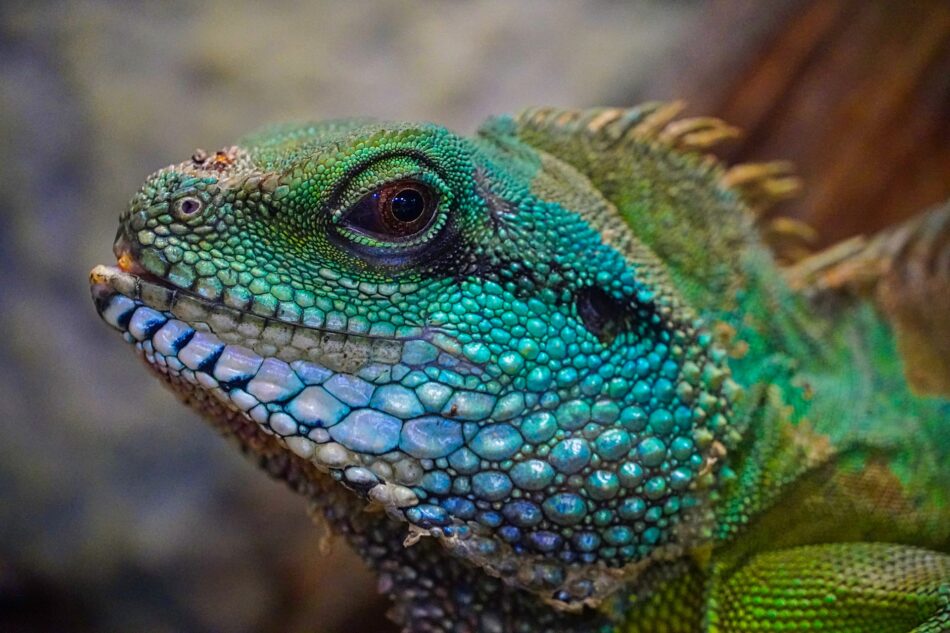
There is no shortage of choice when it comes to vegan pets. Keeping a vegan cat or dog is a much trickier proposition, though. And with all these animals, a balanced diet that matches the pet’s nutritional requirements should be your primary goal.
This entry was posted in Birds












 There are a number of different areas in your home that may be appropriate to place your cat house. This depends on your living situation, and your cat’s preferences. Do they like to be involved with family time or would they prefer to have their shelter in their own quiet room? As we earlier mentioned though, if you have outdoor cats, it’s not recommended that you place your
There are a number of different areas in your home that may be appropriate to place your cat house. This depends on your living situation, and your cat’s preferences. Do they like to be involved with family time or would they prefer to have their shelter in their own quiet room? As we earlier mentioned though, if you have outdoor cats, it’s not recommended that you place your






 What else can I do to help my cat feel comfortable?
What else can I do to help my cat feel comfortable?
 How and when to give your cat space
How and when to give your cat space






 Ammonia is the most likely culprit for litter box odors, found in approximately 0.5 percent of your cat’s urine. As the litter box continues to accumulate waste within a room in your house that may not necessarily be well ventilated, the harmful gas of ammonia is formed. Overexposure to ammonia can result in queasiness and headaches, but should it become more serious, it can further lead to pneumonia. For those with a compromised immune system or are pregnant, overexposure to ammonia can be the onset of toxoplasmosis, an infection by the parasite toxoplasma gondii, which can become life threatening.
Ammonia is the most likely culprit for litter box odors, found in approximately 0.5 percent of your cat’s urine. As the litter box continues to accumulate waste within a room in your house that may not necessarily be well ventilated, the harmful gas of ammonia is formed. Overexposure to ammonia can result in queasiness and headaches, but should it become more serious, it can further lead to pneumonia. For those with a compromised immune system or are pregnant, overexposure to ammonia can be the onset of toxoplasmosis, an infection by the parasite toxoplasma gondii, which can become life threatening.








 Choosing the best litter for your cat
Choosing the best litter for your cat


 With the new Cozy Collection, there are six new amazing
With the new Cozy Collection, there are six new amazing 






 Cats may like to sleep with their owner for warmth, company or reassurance, but it may also simply be because your bed is far better than theirs.
Cats may like to sleep with their owner for warmth, company or reassurance, but it may also simply be because your bed is far better than theirs. The first step to finding a bed your cat will actually use is identifying what they like; there is no use in buying a small cave bed if your cat prefers to stretch out across the sofa, or a thin, flat bed if your cat likes to sleep in a deep, squishy cushion. Ignore novelty cushions, get your cat a bed they will actually love.
The first step to finding a bed your cat will actually use is identifying what they like; there is no use in buying a small cave bed if your cat prefers to stretch out across the sofa, or a thin, flat bed if your cat likes to sleep in a deep, squishy cushion. Ignore novelty cushions, get your cat a bed they will actually love.









 If you were to meet a species of animal for the first time and had to make an accurate guess about its diet, you would get lots of clues by looking at its teeth. The teeth of a dog, like the teeth of a bear, proclaim loud and clear that this animal is an omnivore – that is, one that eats both meat and vegetables. If you think of your dog as a domesticated wolf, you get a good idea of its natural diet.
If you were to meet a species of animal for the first time and had to make an accurate guess about its diet, you would get lots of clues by looking at its teeth. The teeth of a dog, like the teeth of a bear, proclaim loud and clear that this animal is an omnivore – that is, one that eats both meat and vegetables. If you think of your dog as a domesticated wolf, you get a good idea of its natural diet.
 1. Rabbits
1. Rabbits
